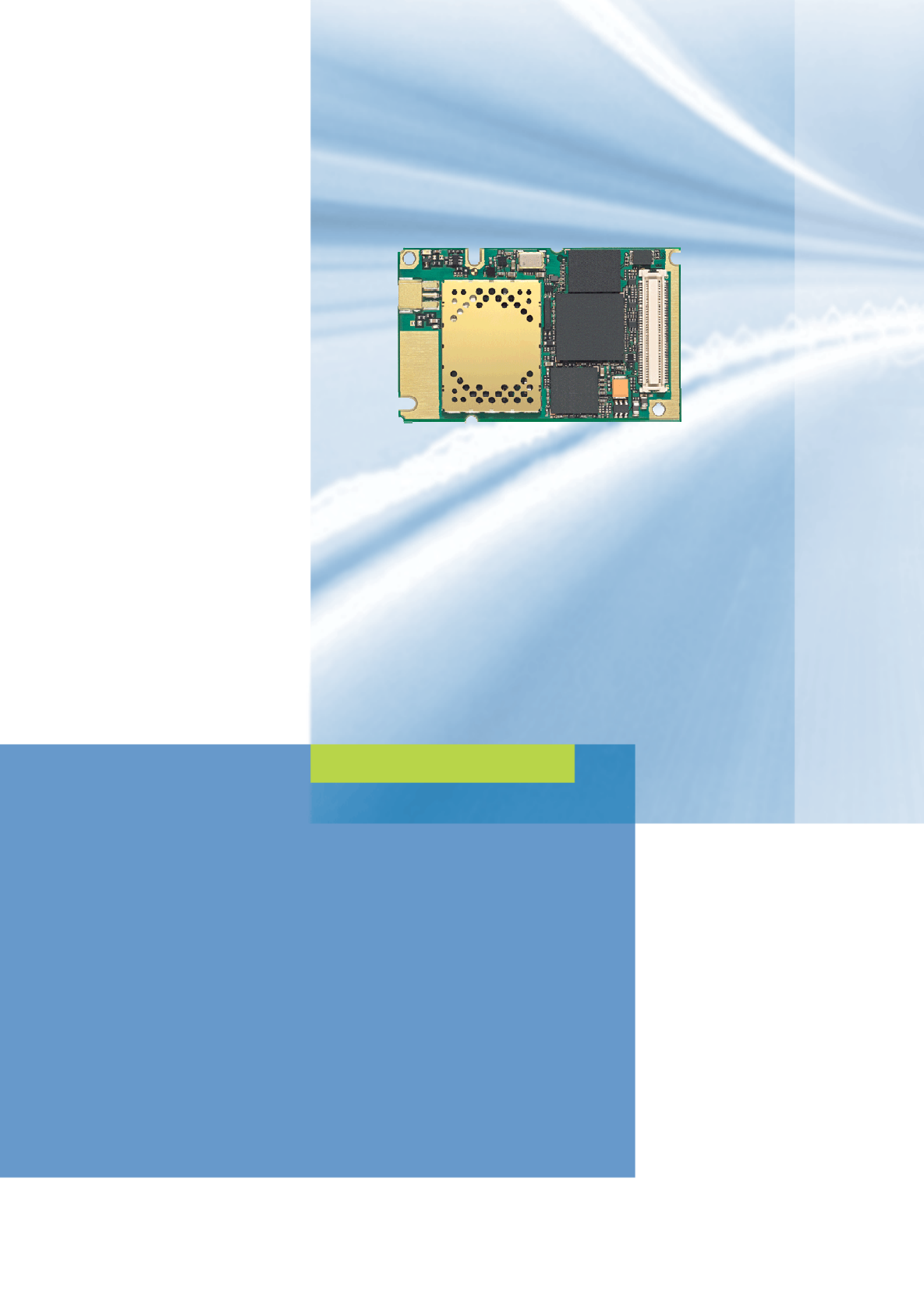THALES DIS AlS Deutschland AC65 Quad Band GSM Module User Manual AC65 AC75
Gemalto M2M GmbH Quad Band GSM Module AC65 AC75
User Manual

AC65/AC75 Hardware Interface Description
Confidential / Preliminary s
AC65/AC75_hd_v00.372 Page 2 of 118 2006-08-03
Document Name: AC65/AC75 Hardware Interface Description
Version: 00.372
Date: August 03, 2006
DocId: AC65/AC75_hd_v00.372
Status: Confidential / Preliminary
General note
Product is deemed accepted by Recipient and is provided without interface to Recipient´s products.
The Product constitutes pre-release version and code and may be changed substantially before
commercial release. The Product is provided on an “as is” basis only and may contain deficiencies or
inadequacies. The Product is provided without warranty of any kind, express or implied. To the
maximum extent permitted by applicable law, Siemens further disclaims all warranties, including
without limitation any implied warranties of merchantability, fitness for a particular purpose and
noninfringement of third-party rights. The entire risk arising out of the use or performance of the
Product and documentation remains with Recipient. This Product is not intended for use in life support
appliances, devices or systems where a malfunction of the product can reasonably be expected to
result in personal injury. Applications incorporating the described product must be designed to be in
accordance with the technical specifications provided in these guidelines. Failure to comply with any
of the required procedures can result in malfunctions or serious discrepancies in results. Furthermore,
all safety instructions regarding the use of mobile technical systems, including GSM products, which
also apply to cellular phones must be followed. Siemens AG customers using or selling this product
for use in any applications do so at their own risk and agree to fully indemnify Siemens for any
damages resulting from illegal use or resale. To the maximum extent permitted by applicable law, in
no event shall Siemens or its suppliers be liable for any consequential, incidental, direct, indirect,
punitive or other damages whatsoever (including, without limitation, damages for loss of business
profits, business interruption, loss of business information or data, or other pecuniary loss) arising out
the use of or inability to use the Product, even if Siemens has been advised of the possibility of such
damages. Subject to change without notice at any time.
Copyright
Transmittal, reproduction, dissemination and/or editing of this document as well as utilization of its
contents and communication thereof to others without express authorization are prohibited. Offenders
will be held liable for payment of damages. All rights created by patent grant or registration of a utility
model or design patent are reserved.
Copyright © Siemens AG 2006

AC65/AC75 Hardware Interface Description
Confidential / Preliminary s
AC65/AC75_hd_v00.372 Page 3 of 118 2006-08-03
Contents
0 Document History .........................................................................................................7
1 Introduction ...................................................................................................................9
1.1 Related Documents ...............................................................................................9
1.2 Terms and Abbreviations.....................................................................................10
1.3 Type Approval......................................................................................................13
1.3.1 SAR Requirements Specific to Portable Mobiles...................................15
1.4 Safety Precautions...............................................................................................16
2 Product Concept .........................................................................................................18
2.1 Key Features at a Glance ....................................................................................18
2.2 AC65/AC75 System Overview.............................................................................21
2.3 Circuit Concept ....................................................................................................22
3 Application Interface...................................................................................................23
3.1 Operating Modes .................................................................................................24
3.2 Power Supply.......................................................................................................26
3.2.1 Minimizing Power Losses ......................................................................26
3.2.2 Measuring the Supply Voltage VBATT+ ....................................................27
3.2.3 Monitoring Power Supply by AT Command ...........................................27
3.3 Power-Up / Power-Down Scenarios ....................................................................28
3.3.1 Turn on AC65/AC75...............................................................................28
3.3.1.1 Turn on AC65/AC75 Using Ignition Line IGT .........................................28
3.3.1.2 Configuring the IGT Line for Use as ON/OFF Switch ............................31
3.3.1.3 Turn on AC65/AC75 Using the VCHARGE Signal.................................32
3.3.1.4 Reset AC65/AC75 via AT+CFUN Command.........................................32
3.3.1.5 Reset or Turn off AC65/AC75 in Case of Emergency............................33
3.3.1.6 Using EMERG_RST to Reset Application(s) or External Device(s).......33
3.3.2 Signal States after Startup.....................................................................34
3.3.3 Turn off AC65/AC75...............................................................................36
3.3.3.1 Turn off AC65/AC75 Using AT Command .............................................36
3.3.3.2 Leakage Current in Power-Down Mode.................................................37
3.3.3.3 Turn on/off AC65/AC75 Applications with Integrated USB ....................38
3.3.4 Automatic Shutdown ..............................................................................39
3.3.4.1 Thermal Shutdown.................................................................................39
3.3.4.2 Deferred Shutdown at Extreme Temperature Conditions ......................40
3.3.4.3 Monitoring the Board Temperature of AC65/AC75 ................................40
3.3.4.4 Undervoltage Shutdown if Battery NTC is Present ................................40
3.3.4.5 Undervoltage Shutdown if no Battery NTC is Present ...........................41
3.3.4.6 Overvoltage Shutdown...........................................................................41
3.4 Automatic EGPRS/GPRS Multislot Class Change ..............................................42
3.5 Charging Control..................................................................................................43
3.5.1 Hardware Requirements ........................................................................43
3.5.2 Software Requirements .........................................................................43
3.5.3 Battery Pack Requirements ...................................................................44
3.5.4 Charger Requirements...........................................................................45
3.5.5 Implemented Charging Technique.........................................................46
3.5.6 Operating Modes during Charging.........................................................47
3.6 Power Saving.......................................................................................................49
3.6.1 Network Dependency of SLEEP Modes ................................................49
3.6.2 Timing of the CTSx Signal in CYCLIC SLEEP Mode 7..........................50
3.6.3 Timing of the RTSx Signal in CYCLIC SLEEP Mode 9..........................50
3.7 Summary of State Transitions (Except SLEEP Mode).........................................51

AC65/AC75 Hardware Interface Description
Confidential / Preliminary s
AC65/AC75_hd_v00.372 Page 4 of 118 2006-08-03
3.8 RTC Backup ........................................................................................................52
3.9 SIM Interface .......................................................................................................53
3.9.1 Installation Advice..................................................................................54
3.10 Serial Interface ASC0 ..........................................................................................55
3.11 Serial Interface ASC1 ..........................................................................................57
3.12 USB Interface ......................................................................................................58
3.13 I2C Interface .........................................................................................................59
3.14 SPI Interface ........................................................................................................61
3.15 Audio Interfaces...................................................................................................63
3.15.1 Speech Processing................................................................................64
3.15.2 Microphone Circuit.................................................................................64
3.15.2.1 Single-ended Microphone Input.............................................................65
3.15.2.2 Differential Microphone Input.................................................................66
3.15.2.3 Line Input Configuration with OpAmp ....................................................67
3.15.3 Loudspeaker Circuit...............................................................................68
3.15.4 Digital Audio Interface (DAI) ..................................................................69
3.15.4.1 Master Mode..........................................................................................70
3.15.4.2 Slave Mode............................................................................................72
3.16 GPIO Interface.....................................................................................................74
3.16.1 Using the GPIO10 Pin as Pulse Counter ...............................................74
3.17 Control Signals ....................................................................................................75
3.17.1 Synchronization Signal ..........................................................................75
3.17.2 Using the SYNC Pin to Control a Status LED........................................76
3.17.3 Behavior of the RING0 Line (ASC0 Interface only)................................77
3.17.4 PWR_IND Signal ...................................................................................77
4 Antenna Interface........................................................................................................78
4.1 Antenna Diagnostic..............................................................................................79
4.2 Antenna Connector..............................................................................................80
5 Electrical, Reliability and Radio Characteristics......................................................82
5.1 Absolute Maximum Ratings .................................................................................82
5.2 Operating Temperatures......................................................................................83
5.3 Storage Conditions ..............................................................................................84
5.4 Reliability Characteristics.....................................................................................85
5.5 Pin Assignment and Signal Description...............................................................86
5.6 Power Supply Ratings .........................................................................................93
5.7 Electrical Characteristics of the Voiceband Part..................................................96
5.7.1 Setting Audio Parameters by AT Commands ........................................96
5.7.2 Audio Programming Model ....................................................................97
5.7.3 Characteristics of Audio Modes .............................................................98
5.7.4 Voiceband Receive Path........................................................................99
5.7.5 Voiceband Transmit Path.....................................................................100
5.8 Air Interface .......................................................................................................101
5.9 Electrostatic Discharge ......................................................................................102
6 Mechanics..................................................................................................................103
6.1 Mechanical Dimensions of AC65/AC75.............................................................103
6.2 Mounting AC65/AC75 to the Application Platform .............................................105
6.3 Board-to-Board Application Connector ..............................................................106
7 Sample Application...................................................................................................109
8 Reference Approval ..................................................................................................111
8.1 Reference Equipment for Type Approval...........................................................111
8.2 Compliance with FCC Rules and Regulations...................................................112

AC65/AC75 Hardware Interface Description
Confidential / Preliminary s
AC65/AC75_hd_v00.372 Page 5 of 118 2006-08-03
9 Appendix....................................................................................................................113
9.1 List of Parts and Accessories ............................................................................113
9.2 Fasteners and Fixings for Electronic Equipment ...............................................115
9.2.1 Fasteners from German Supplier ETTINGER GmbH ..........................115
Tables
Table 1: Directives..................................................................................................................13
Table 2: Standards of North American type approval ............................................................ 13
Table 3: Standards of European type approval...................................................................... 14
Table 4: Requirements of quality............................................................................................ 14
Table 5: Overview of operating modes................................................................................... 24
Table 6: Signal states.............................................................................................................34
Table 7: Temperature dependent behavior ............................................................................ 40
Table 8: Specifications of battery packs suitable for use with AC65/AC75 ............................ 45
Table 9: AT commands available in Charge-only mode......................................................... 47
Table 10: Comparison Charge-only and Charge mode.......................................................... 48
Table 11: State transitions of AC65/AC75 (except SLEEP mode) .........................................51
Table 12: Signals of the SIM interface (board-to-board connector) ....................................... 53
Table 13: DCE-DTE wiring of ASC0....................................................................................... 56
Table 14: DCE-DTE wiring of ASC1....................................................................................... 57
Table 15: Configuration combinations for the PCM interface................................................. 69
Table 16: Overview of DAI pin functions ................................................................................70
Table 17: Return loss in the active band ................................................................................78
Table 18: Values of the AT^SAD parameter <diag> and their meaning................................. 79
Table 19: Product specifications of Rosenberger SMP connector ......................................... 80
Table 20: Absolute maximum ratings ..................................................................................... 82
Table 21: Board temperature ................................................................................................. 83
Table 22: Ambient temperature according to IEC 60068-2 (without forced air circulation) .... 83
Table 23: Charging temperature ............................................................................................ 83
Table 24: Storage conditions.................................................................................................. 84
Table 25: Summary of reliability test conditions ..................................................................... 85
Table 26: Signal description...................................................................................................87
Table 27: Power supply ratings .............................................................................................. 93
Table 28: Current consumption during Tx burst for GSM 850MHz and GSM 900MHz..........94
Table 29: Current consumption during Tx burst for GSM 1800MHz and GSM 1900MHz......95
Table 30: Audio parameters adjustable by AT command ...................................................... 96
Table 31: Voiceband characteristics (typical).........................................................................98
Table 32: Voiceband receive path..........................................................................................99
Table 33: Voiceband transmit path....................................................................................... 100
Table 34: Air Interface ..........................................................................................................101
Table 35: Measured electrostatic values..............................................................................102
Table 36: Technical specifications of Molex board-to-board connector ...............................106
Table 37: List of parts and accessories................................................................................113
Table 38: Molex sales contacts (subject to change) ............................................................114

AC65/AC75 Hardware Interface Description
Confidential / Preliminary s
AC65/AC75_hd_v00.372 Page 6 of 118 2006-08-03
Figures
Figure 1: AC65/AC75 system overview.................................................................................. 21
Figure 2: AC65/AC75 block diagram...................................................................................... 22
Figure 3: Power supply limits during transmit burst................................................................ 27
Figure 4: Position of the reference points BATT+ and GND .................................................. 27
Figure 5: Power-on with operating voltage at BATT+ applied before activating IGT.............. 29
Figure 6: Power-on with IGT held low before switching on operating voltage at BATT+ .......30
Figure 7: Timing of IGT if used as ON/OFF switch ................................................................ 31
Figure 8: Signal states during turn-off procedure ...................................................................37
Figure 9: Battery pack circuit diagram....................................................................................44
Figure 10: Power saving and paging...................................................................................... 49
Figure 11: Timing of CTSx signal (if CFUN= 7)......................................................................50
Figure 12: Timing of RTSx signal (if CFUN = 9).....................................................................50
Figure 13: RTC supply from capacitor.................................................................................... 52
Figure 14: RTC supply from rechargeable battery .................................................................52
Figure 15: RTC supply from non-chargeable battery .............................................................52
Figure 16: Serial interface ASC0............................................................................................ 55
Figure 17: Serial interface ASC1............................................................................................ 57
Figure 18: USB circuit ............................................................................................................58
Figure 19: I2C interface connected to VCC of application .....................................................59
Figure 20: I2C interface connected to VEXT line of AC65/AC75 ........................................... 60
Figure 21: SPI interface..........................................................................................................61
Figure 22: Characteristics of SPI modes................................................................................ 62
Figure 23: Audio block diagram.............................................................................................. 63
Figure 24: Single ended microphone input............................................................................. 65
Figure 25: Differential microphone input ................................................................................66
Figure 26: Line input configuration with OpAmp .................................................................... 67
Figure 27: Differential loudspeaker configuration...................................................................68
Figure 28: Master PCM interface Application......................................................................... 70
Figure 29: Master PCM timing, short frame selected .............................................................71
Figure 30: Master PCM timing, long frame selected ..............................................................71
Figure 31: Slave PCM interface application ........................................................................... 72
Figure 32: Slave PCM timing, short frame selected ...............................................................73
Figure 33: Slave PCM timing, long frame selected ................................................................73
Figure 34: SYNC signal during transmit burst ........................................................................ 75
Figure 35: LED Circuit (Example)...........................................................................................76
Figure 36: Incoming voice/fax/data call .................................................................................. 77
Figure 37: URC transmission ................................................................................................. 77
Figure 38: Resistor measurement used for antenna detection .............................................. 79
Figure 39: Datasheet of Rosenberger SMP MIL-Std 348-A connector ..................................81
Figure 40: Pin assignment (component side of AC65/AC75)................................................. 86
Figure 41: Audio programming model .................................................................................... 97
Figure 42: AC65/AC75 – top view ........................................................................................ 103
Figure 43: Dimensions of AC65/AC75 ................................................................................. 104
Figure 44: Molex board-to-board connector 52991-0808 on AC65/AC75............................ 107
Figure 45: Mating board-to-board connector 53748-0808 on application ............................108
Figure 46: AC65/AC75 sample application for Java............................................................. 110
Figure 47: Reference equipment for Type Approval ............................................................ 111

AC65/AC75 Hardware Interface Description
Confidential / Preliminary s
AC65/AC75_hd_v00.372 Page 7 of 118 2006-08-03
0 Document History
Preceding document: "AC75 Hardware Interface Description" Version 00.251
New document: "AC65/AC75 Hardware Interface Description" Version 00.372
Chapter What is new
Throughout
document
Added new product: AC65 module
1 Added AC65 and general statement on difference between AC65 and AC75.
1.3 Updated list of standards.
1.3.1 Every portable mobile shall have an FCC Grant and IC Certificate of its own.
1.4 Added note on audio safety precautions.
3.5, 9 Removed all information related to specific types of batteries and specific vendors.
3.9 Removed note on required restart of module after removing and reinserting a SIM
card during operation.
3.12 Removed section describing USB modem installation. For installation details see [11].
3.15.4.1 Corrected description of master PCM timing with long or short frame selected.
3.15.4.2 Updated timing for slave mode of PCM interface (Figure 32 and Figure 33).
5.1 Added remark on SELV compliance.
5.5 Table 26: Modified RTC input voltage values (RTC Backup VDDLP).
5.6 Table 27: Different current consumption depending on whether autobauding enabled /
disabled.
8.2 Added FCC and IC identifiers for AC65. Changed notes on mobile and fixed devices,
added note on portable mobiles.
9.1 Added AC65 incl. Siemens ordering numbers.
Preceding document: "AC75 Hardware Interface Description" Version 00.202
New document: "AC75 Hardware Interface Description" Version 00.251
Chapter What is new
3.3.4.2 Corrected description of deferred shutdown.
3.3.4.4 to
3.3.4.6
Alert URCs for undervoltage and overvoltage do not need to enabled by the user.
3.5.3 Added overdischarge release voltage 2.6V
9.1 Specified Siemens ordering numbers for AC75.
Preceding document: "AC75 Hardware Interface Description" Version 00.020
New document: "AC75 Hardware Interface Description" Version 00.202
Chapter What is new
3.3.2 New chapter: Signal States after Startup.
3.3.1.1 More detailed description of IGT timing depending on Power-down or Charge-only
mode. Added further details on timing after power-up. Added alert message
“SHUTDOWN after Illegal PowerUp”

AC65/AC75 Hardware Interface Description
Confidential / Preliminary s
AC65/AC75_hd_v00.372 Page 8 of 118 2006-08-03
Chapter What is new
3.3.1.2 New chapter: Configuring the IGT Line for Use as ON/OFF Switch
3.3.4.1 Revised Table 7: Temperature dependent behavior.
3.3.4.2,
3.3.4.3
Changed description.
Added new section.
3.4 Minor text change.
3.3.1.3,
3.5.6, 3.7
To change from Charge-only mode to Normal mode the IGT line must be pulled low
for at least 1s and then released. High state of IGT lets AC75 enter Normal mode.
3.5.6, 3.7 Added transition from Charge-only to Normal mode by switching off Airplane mode.
3.6 Added chapter on power saving.
3.12 AC75 does not support generic USB 2.0 High Speed hubs.
3.15.2.2 Added remarks on VMIC behaviour.
3.15.2.3 Replaced remark on VMIC behaviour.
3.15.4 Added Table 15: Configuration combinations for the PCM interface
5.1 New maximum values for voltage at analog pins with VMIC on/off.
5.2 Specified operating board temperature.
Table 22: Temperature specified for charging is battery temperature (not ambient)
5.5 Specified internal pull-down resistors 330kΩ at TXD0, RXD0, TXD1, RXD1. Changed
all VIHmin values from 2.0 to 2.15V. Corrected overview table: USB_DP was listed in
wrong row.
5.7 New chapter: Electrical Characteristics of the Voiceband Part
7 Modified description for Java “System.out” in sample application.
9 New datasheet for recommended VARTA PoLiFlex® Lithium polymer battery.

AC65/AC75 Hardware Interface Description
Confidential / Preliminary s
AC65/AC75_hd_v00.372 Page 9 of 118 2006-08-03
1 Introduction
This document applies to the following Siemens products:
• AC65 Module
• AC75 Module
The document describes the hardware of the AC65 and the AC75, both designed to connect
to a cellular device application and the air interface. It helps you quickly retrieve interface
specifications, electrical and mechanical details and information on the requirements to be
considered for integrating further components.
The difference between both modules is that AC75 additionally features EGPRS. Please
note that except for EGPRS specific statements, all information provided below applies to
both module types.
Throughout the document, both modules are generally referred to as AC65/AC75.
1.1 Related Documents
[1] AC65 AT Command Set 00.372
AC75 AT Command Set 00.372
[2] AC65/AC75 Release Notes 00.372
[3] DSB75 Support Box - Evaluation Kit for Siemens Cellular Engines
[4] Application Note 02: Audio Interface Design for GSM Applications (AC65, AC75)
[5] Application Note 07: Rechargeable Lithium Batteries in GSM Applications
[6] Application Note 16: Upgrading Firmware on MC75, TC6x, AC65, AC75
[7] Application Note 17: Over-The-Air Firmware Update for TC65, AC65, AC75
[8] Application Note 22: Using TTY / CTM Equipment
[9] Application Note 26: Power Supply Design for GSM Applications
[10] Application Note 24: Application Developer’s Guide
[11] Application Note 32: Integrating USB into MC75, TC6x, AC65, AC75 Applications
[12] Multiplexer User's Guide
[13] Multiplex Driver Developer’s Guide for Windows 2000 and Windows XP
[14] Multiplex Driver Installation Guide for Windows 2000 and Windows XP
[15] Remote SAT User’s Guide for MC75, TC6x, AC65, AC75
[16] Java User’s Guide for TC65, AC65, AC75
[17] Java doc \wtk\doc\html\index.html

AC65/AC75 Hardware Interface Description
Confidential / Preliminary s
AC65/AC75_hd_v00.372 Page 10 of 118 2006-08-03
1.2 Terms and Abbreviations
Abbreviation Description
ADC Analog-to-Digital Converter
AGC Automatic Gain Control
ANSI American National Standards Institute
ARFCN Absolute Radio Frequency Channel Number
ARP Antenna Reference Point
ASC0 / ASC1 Asynchronous Controller. Abbreviations used for first and second serial interface of
AC65/AC75
B Thermistor Constant
B2B Board-to-board connector
BER Bit Error Rate
BTS Base Transceiver Station
CB or CBM Cell Broadcast Message
CE Conformité Européene (European Conformity)
CHAP Challenge Handshake Authentication Protocol
CPU Central Processing Unit
CS Coding Scheme
CSD Circuit Switched Data
CTS Clear to Send
DAC Digital-to-Analog Converter
DAI Digital Audio Interface
dBm0 Digital level, 3.14dBm0 corresponds to full scale, see ITU G.711, A-law
DCE Data Communication Equipment (typically modems, e.g. Siemens GSM engine)
DCS 1800 Digital Cellular System, also referred to as PCN
DRX Discontinuous Reception
DSB Development Support Box
DSP Digital Signal Processor
DSR Data Set Ready
DTE Data Terminal Equipment (typically computer, terminal, printer or, for example, GSM
application)
DTR Data Terminal Ready
DTX Discontinuous Transmission
EFR Enhanced Full Rate
EGSM Enhanced GSM
EIRP Equivalent Isotropic Radiated Power
EMC Electromagnetic Compatibility
ERP Effective Radiated Power

AC65/AC75 Hardware Interface Description
Confidential / Preliminary s
AC65/AC75_hd_v00.372 Page 11 of 118 2006-08-03
Abbreviation Description
ESD Electrostatic Discharge
ETS European Telecommunication Standard
FCC Federal Communications Commission (U.S.)
FDMA Frequency Division Multiple Access
FR Full Rate
GMSK Gaussian Minimum Shift Keying
GPIO General Purpose Input/Output
GPRS General Packet Radio Service
GSM Global Standard for Mobile Communications
HiZ High Impedance
HR Half Rate
I/O Input/Output
IC Integrated Circuit
IMEI International Mobile Equipment Identity
ISO International Standards Organization
ITU International Telecommunications Union
kbps kbits per second
LED Light Emitting Diode
Li-Ion / Li+ Lithium-Ion
Li battery Rechargeable Lithium Ion or Lithium Polymer battery
Mbps Mbits per second
MMI Man Machine Interface
MO Mobile Originated
MS Mobile Station (GSM engine), also referred to as TE
MSISDN Mobile Station International ISDN number
MT Mobile Terminated
NTC Negative Temperature Coefficient
OEM Original Equipment Manufacturer
PA Power Amplifier
PAP Password Authentication Protocol
PBCCH Packet Switched Broadcast Control Channel
PCB Printed Circuit Board
PCL Power Control Level
PCM Pulse Code Modulation
PCN Personal Communications Network, also referred to as DCS 1800
PCS Personal Communication System, also referred to as GSM 1900
PDU Protocol Data Unit
PLL Phase Locked Loop

AC65/AC75 Hardware Interface Description
Confidential / Preliminary s
AC65/AC75_hd_v00.372 Page 12 of 118 2006-08-03
Abbreviation Description
PPP Point-to-point protocol
PSK Phase Shift Keying
PSU Power Supply Unit
R&TTE Radio and Telecommunication Terminal Equipment
RAM Random Access Memory
RF Radio Frequency
RMS Root Mean Square (value)
ROM Read-only Memory
RTC Real Time Clock
RTS Request to Send
Rx Receive Direction
SAR Specific Absorption Rate
SELV Safety Extra Low Voltage
SIM Subscriber Identification Module
SMS Short Message Service
SPI Serial Peripheral Interface
SRAM Static Random Access Memory
TA Terminal adapter (e.g. GSM engine)
TDMA Time Division Multiple Access
TE Terminal Equipment, also referred to as DTE
Tx Transmit Direction
UART Universal asynchronous receiver-transmitter
URC Unsolicited Result Code
USB Universal Serial Bus
USSD Unstructured Supplementary Service Data
VSWR Voltage Standing Wave Ratio
Phonebook abbreviations
FD SIM fixdialing phonebook
LD SIM last dialing phonebook (list of numbers most recently dialed)
MC Mobile Equipment list of unanswered MT calls (missed calls)
ME Mobile Equipment phonebook
ON Own numbers (MSISDNs) stored on SIM or ME
RC Mobile Equipment list of received calls
SM SIM phonebook

AC65/AC75 Hardware Interface Description
Confidential / Preliminary s
AC65/AC75_hd_v00.372 Page 13 of 118 2006-08-03
1.3 Type Approval
AC65/AC75 is designed to comply with the directives and standards listed below. Please
note that the product is still in a pre-release state and, therefore, type approval and testing
procedures have not yet been completed.
Table 1: Directives
99/05/EC Directive of the European Parliament and of the council of 9
March 1999 on radio equipment and telecommunications terminal
equipment and the mutual recognition of their conformity (in short
referred to as R&TTE Directive 1999/5/EC).
The product is labeled with the CE conformity mark
89/336/EC Directive on electromagnetic compatibility
73/23/EC Directive on electrical equipment designed for use within certain
voltage limits (Low Voltage Directive)
95/94/EC Automotive EMC directive
2002/95/EC Directive of the European Parliament and of the
Council of 27 January 2003 on the restriction of the
use of certain hazardous substances in electrical
and electronic equipment (RoHS)
Table 2: Standards of North American type approval
CFR Title 47 Code of Federal Regulations, Part 22 and Part 24 (Telecommuni-
cations, PCS); US Equipment Authorization FCC
UL 60 950 Product Safety Certification (Safety requirements)
NAPRD.03 V3.6.1 Overview of PCS Type certification review board Mobile
Equipment Type Certification and IMEI control
PCS Type Certification Review board (PTCRB)
RSS133 (Issue2) Canadian Standard

AC65/AC75 Hardware Interface Description
Confidential / Preliminary s
AC65/AC75_hd_v00.372 Page 14 of 118 2006-08-03
Table 3: Standards of European type approval
3GPP TS 51.010-1 Digital cellular telecommunications system (Phase 2); Mobile
Station (MS) conformance specification
ETSI EN 301 511
V9.0.2
Candidate Harmonized European Standard (Telecommunications
series) Global System for Mobile communications (GSM);
Harmonized standard for mobile stations in the GSM 900 and
DCS 1800 bands covering essential requirements under article
3.2 of the R&TTE directive (1999/5/EC) (GSM 13.11 version 7.0.1
Release 1998)
GCF-CC V3.21.0 Global Certification Forum - Certification Criteria
ETSI EN 301 489-1
V1.4.1
Candidate Harmonized European Standard (Telecommunications
series) Electro Magnetic Compatibility and Radio spectrum Matters
(ERM); Electro Magnetic Compatibility (EMC) standard for radio
equipment and services; Part 1: Common Technical Requirements
ETSI EN 301 489-7
V1.2.1 (2000-09)
Candidate Harmonized European Standard (Telecommunications
series) Electro Magnetic Compatibility and Radio spectrum
Matters (ERM); Electro Magnetic Compatibility (EMC) standard for
radio equipment and services; Part 7: Specific conditions for
mobile and portable radio and ancillary equipment of digital
cellular radio telecommunications systems (GSM and DCS)
IEC/EN 60950-1
(2001)
Safety of information technology equipment (2000)
Table 4: Requirements of quality
IEC 60068 Environmental testing
DIN EN 60529 IP codes

AC65/AC75 Hardware Interface Description
Confidential / Preliminary s
AC65/AC75_hd_v00.372 Page 15 of 118 2006-08-03
1.3.1 SAR Requirements Specific to Portable Mobiles
Mobile phones, PDAs or other portable transmitters and receivers incorporating a GSM
module must be in accordance with the guidelines for human exposure to radio frequency
energy. This requires the Specific Absorption Rate (SAR) of portable AC65/AC75 based
applications to be evaluated and approved for compliance with national and/or international
regulations.
Since the SAR value varies significantly with the individual product design manufacturers are
advised to submit their product for approval if designed for portable use. For European and
US markets the relevant directives are mentioned below. It is the responsibility of the
manufacturer of the final product to verify whether or not further standards, recommendations
or directives are in force outside these areas.
Products intended for sale on US markets
ES 59005/ANSI C95.1 Considerations for evaluation of human exposure to
Electromagnetic Fields (EMFs) from Mobile Telecommunication
Equipment (MTE) in the frequency range 30MHz - 6GHz
Products intended for sale on European markets
EN 50360 Product standard to demonstrate the compliance of mobile phones
with the basic restrictions related to human exposure to
electromagnetic fields (300MHz - 3GHz)
IMPORTANT:
Manufacturers of portable applications based on AC65/AC75 modules are required to have
their final product certified and apply for their own FCC Grant and IC Certificate related to the
specific portable mobile. See also Chapter 8.2.
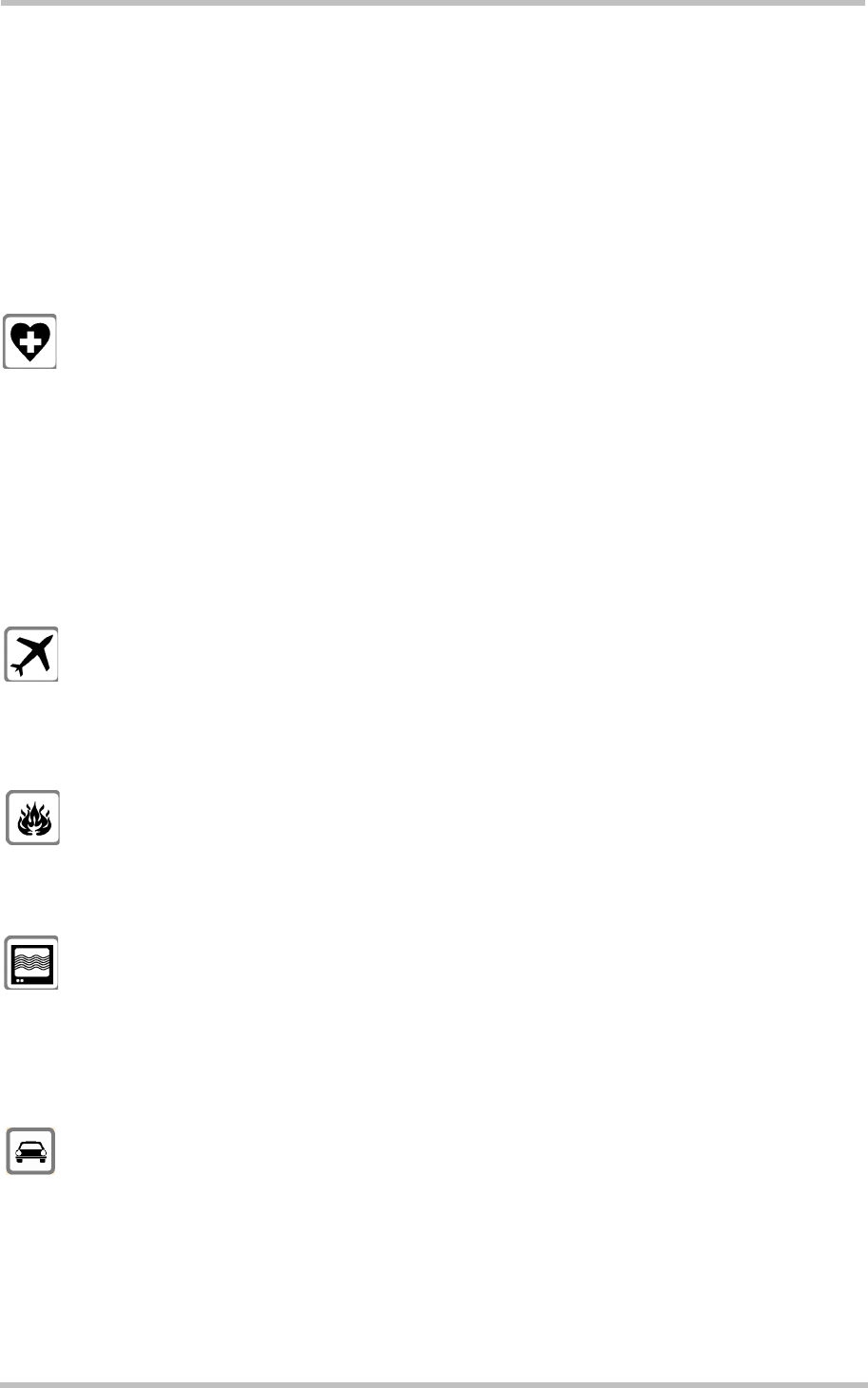
AC65/AC75 Hardware Interface Description
Confidential / Preliminary s
AC65/AC75_hd_v00.372 Page 16 of 118 2006-08-03
1.4 Safety Precautions
The following safety precautions must be observed during all phases of the operation, usage,
service or repair of any cellular terminal or mobile incorporating AC65/AC75. Manufacturers
of the cellular terminal are advised to convey the following safety information to users and
operating personnel and to incorporate these guidelines into all manuals supplied with the
product. Failure to comply with these precautions violates safety standards of design,
manufacture and intended use of the product. Siemens AG assumes no liability for
customer’s failure to comply with these precautions.
When in a hospital or other health care facility, observe the restrictions on the
use of mobiles. Switch the cellular terminal or mobile off, if instructed to do so
by the guidelines posted in sensitive areas. Medical equipment may be
sensitive to RF energy.
The operation of cardiac pacemakers, other implanted medical equipment
and hearing aids can be affected by interference from cellular terminals or
mobiles placed close to the device. If in doubt about potential danger, contact
the physician or the manufacturer of the device to verify that the equipment is
properly shielded. Pacemaker patients are advised to keep their hand-held
mobile away from the pacemaker, while it is on.
Switch off the cellular terminal or mobile before boarding an aircraft. Make
sure it cannot be switched on inadvertently. The operation of wireless
appliances in an aircraft is forbidden to prevent interference with
communications systems. Failure to observe these instructions may lead to
the suspension or denial of cellular services to the offender, legal action, or
both.
Do not operate the cellular terminal or mobile in the presence of flammable
gases or fumes. Switch off the cellular terminal when you are near petrol
stations, fuel depots, chemical plants or where blasting operations are in
progress. Operation of any electrical equipment in potentially explosive
atmospheres can constitute a safety hazard.
Your cellular terminal or mobile receives and transmits radio frequency
energy while switched on. Remember that interference can occur if it is used
close to TV sets, radios, computers or inadequately shielded equipment.
Follow any special regulations and always switch off the cellular terminal or
mobile wherever forbidden, or when you suspect that it may cause
interference or danger.
Road safety comes first! Do not use a hand-held cellular terminal or mobile
when driving a vehicle, unless it is securely mounted in a holder for
speakerphone operation. Before making a call with a hand-held terminal or
mobile, park the vehicle.
Speakerphones must be installed by qualified personnel. Faulty installation or
operation can constitute a safety hazard.

AC65/AC75 Hardware Interface Description
Confidential / Preliminary s
AC65/AC75_hd_v00.372 Page 17 of 118 2006-08-03
SOS
IMPORTANT!
Cellular terminals or mobiles operate using radio signals and cellular
networks. Because of this, connection cannot be guaranteed at all times
under all conditions. Therefore, you should never rely solely upon any
wireless device for essential communications, for example emergency calls.
Remember, in order to make or receive calls, the cellular terminal or mobile
must be switched on and in a service area with adequate cellular signal
strength.
Some networks do not allow for emergency calls if certain network services or
phone features are in use (e.g. lock functions, fixed dialing etc.). You may
need to deactivate those features before you can make an emergency call.
Some networks require that a valid SIM card be properly inserted in the
cellular terminal or mobile.
Bear in mind that exposure to excessive levels of noise can cause physical
damage to users! With regard to acoustic shock, the cellular application must
be designed to avoid unintentional increase of amplification, e.g. for a highly
sensitive earpiece. A protection circuit should be implemented in the cellular
application.

AC65/AC75 Hardware Interface Description
Confidential / Preliminary s
AC65/AC75_hd_v00.372 Page 18 of 118 2006-08-03
2 Product Concept
2.1 Key Features at a Glance
Feature Implementation
General
Frequency bands Quad band: GSM 850/900/1800/1900MHz
GSM class Small MS
Output power
(according to
Release 99, V5)
Class 4 (+33dBm ±2dB) for EGSM850
Class 4 (+33dBm ±2dB) for EGSM900
Class 1 (+30dBm ±2dB) for GSM1800
Class 1 (+30dBm ±2dB) for GSM1900
AC75 only:
Class E2 (+27dBm ± 3dB) for GSM 850 8-PSK
Class E2 (+27dBm ± 3dB) for GSM 900 8-PSK
Class E2 (+26dBm +3 /-4dB) for GSM 1800 8-PSK
Class E2 (+26dBm +3 /-4dB) for GSM 1900 8-PSK
The values stated above are maximum limits. According to
Release 99, Version 5, the maximum output power in a multislot
configuration may be lower. The nominal reduction of maximum
output power varies with the number of uplink timeslots used and
amounts to 3.0dB for 2Tx, 4.8dB for 3Tx and 6.0dB for 4Tx.
Power supply 3.3V to 4.5V
Ambient operating
temperature according
to IEC 60068-2
Normal operation -30°C to +75°C
Restricted operation -30°C / +85°C
Physical Dimensions: 33.9mm x 55mm x max. 4mm
Weight: approx. 8.5g
RoHS All hardware components fully compliant with EU RoHS Directive
GSM / GPRS / EGPRS features
Data transfer GPRS
• Multislot Class 12
• Full PBCCH support
• Mobile Station Class B
• Coding Scheme 1 – 4
EGPRS (AC75 only)
• Multislot Class 10
• Mobile Station Class B
• Modulation and Coding Scheme MCS 1 – 9

AC65/AC75 Hardware Interface Description
Confidential / Preliminary s
AC65/AC75_hd_v00.372 Page 19 of 118 2006-08-03
Feature Implementation
CSD
• V.110, RLP, non-transparent
• 2.4, 4.8, 9.6, 14.4kbps
• USSD
PPP-stack for GPRS data transfer
SMS • Point-to-point MT and MO
• Cell broadcast
• Text and PDU mode
• Storage: SIM card plus 25 SMS locations in mobile equipment
• Transmission of SMS alternatively over CSD or GPRS.
Preferred mode can be user defined.
Fax Group 3; Class 1
Audio Speech codecs:
• Half rate HR (ETS 06.20)
• Full rate FR (ETS 06.10)
• Enhanced full rate EFR (ETS 06.50/06.60/06.80)
• Adaptive Multi Rate AMR
Speakerphone operation (VDA), echo cancellation, noise
suppression, DTMF, 7 ringing tones
Software
AT commands AT-Hayes GSM 07.05 and 07.07, Siemens
AT commands for RIL compatibility (NDIS/RIL)
MicrosoftTM compatibility RIL / NDIS for Pocket PC and Smartphone
Java platform
JDK Version: 1.4.2_09
Java Virtual Machine with APIs for AT Parser, Serial Interface,
FlashFileSystem and TCP/IP Stack.
Major benefits: seamless integration into Java applications, ease
of programming, no need for application microcontroller,
extremely cost-efficient hardware and software design – ideal
platform for industrial GSM applications.
The memory space available for Java programs is around 1.7 MB
in the flash file system and around 400k RAM. Application code
and data share the space in the flash file system and in RAM.
SIM Application Toolkit SAT Release 99
TCP/IP stack Access by AT commands
IP addresses IP version 6
Remote SIM Access AC65/AC75 supports Remote SIM Access. RSA enables
AC65/AC75 to use a remote SIM card via its serial interface and
an external application, in addition to the SIM card locally
attached to the dedicated lines of the application interface. The
connection between the external application and the remote SIM
card can be a Bluetooth wireless link or a serial link.
The necessary protocols and procedures are implemented
according to the “SIM Access Profile Interoperability Specification
of the Bluetooth Special Interest Group”.

AC65/AC75 Hardware Interface Description
Confidential / Preliminary s
AC65/AC75_hd_v00.372 Page 20 of 118 2006-08-03
Feature Implementation
Firmware update Generic update from host application over ASC0, ASC1 or USB.
Over-the-air (OTA) firmware update is possible via SPI interface.
Interfaces
2 serial interfaces
ASC0:
• 8-wire modem interface with status and control lines,
unbalanced, asynchronous
• Fixed bit rates: 300 bps to 460,800 bps
• Autobauding: 1,200 bps to 460,800 bps
• RTS0/CTS0 and XON/XOFF flow control.
• Multiplex ability according to GSM 07.10 Multiplexer Protocol.
ASC1:
• 4-wire, unbalanced asynchronous interface
• Fixed bit rates: 300 bps to 460,800 bps
• RTS1/CTS1 and software XON/XOFF flow control
USB Supports a USB 2.0 Full Speed (12Mbit/s) slave interface.
I2C I2C bus for 7-bit addressing and transmission rates up to 400kbps.
Programmable with AT^SSPI command.
Alternatively, all pins of the I²C interface are configurable as SPI.
SPI Serial Peripheral Interface for transmission rates up to 6.5 Mbps.
Programmable with AT^SSPI command.
If the SPI is active the I²C interface is not available.
Audio • 2 analog interfaces (2 microphone inputs and 2 headphone
outputs with microphone power supply)
• 1 digital interface (PCM)
SIM interface Supported SIM cards: 3V, 1.8V
Antenna • 50Ohms. External antenna can be connected via antenna
connector.
• Antenna diagnostic
Module interface 80-pin board-to-board connector
Power on/off, Reset
Power on/off • Switch-on by hardware pin IGT
• Switch-off by AT command (AT^SMSO)
• Automatic switch-off in case of critical temperature and
voltage conditions.
Reset • Orderly shutdown and reset by AT command
• Emergency reset by hardware pin EMERG_RST and IGT.
Special features
Charging Supports management of rechargeable Lithium Ion and Lithium
Polymer batteries
Real time clock Timer functions via AT commands
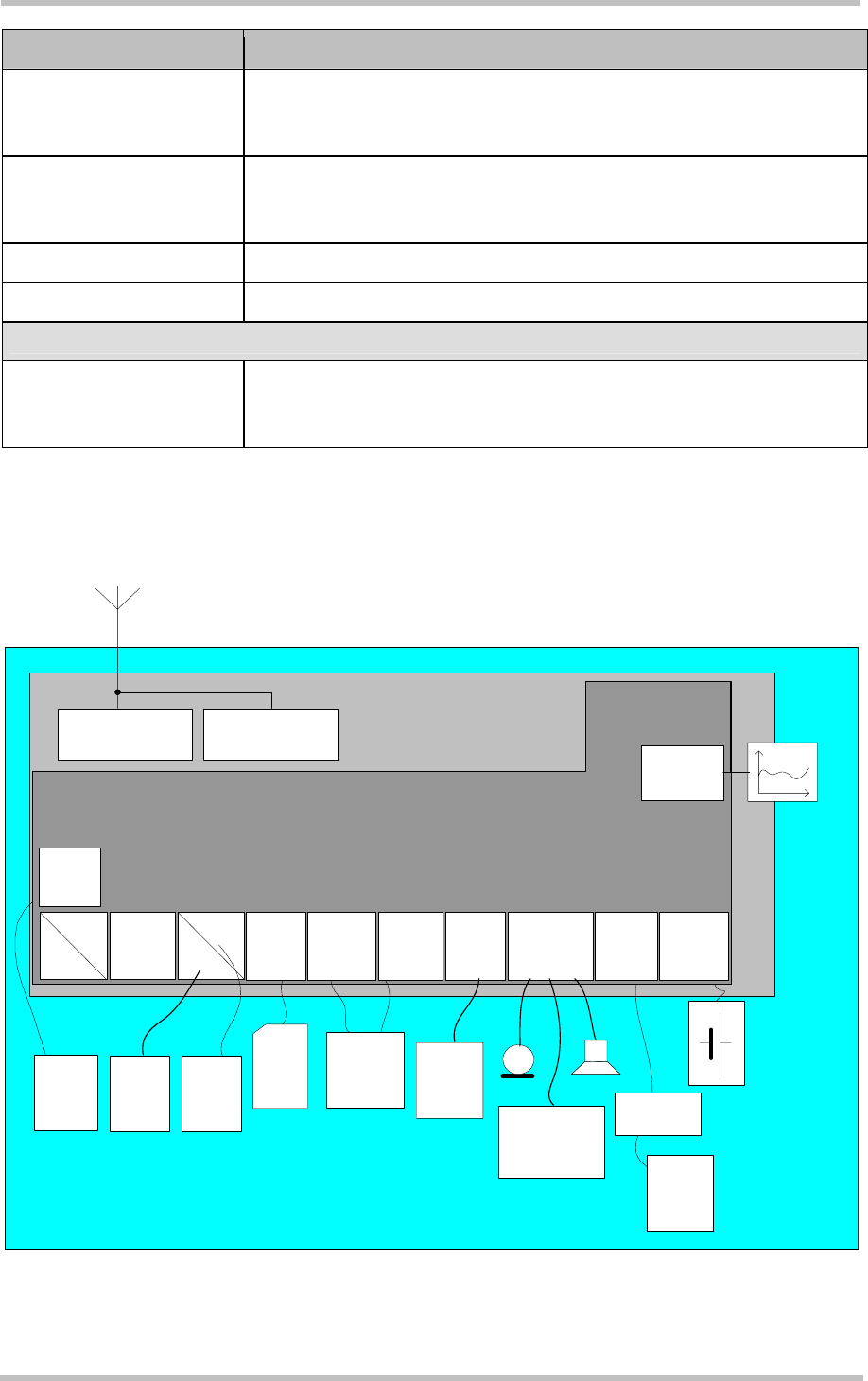
AC65/AC75 Hardware Interface Description
Confidential / Preliminary s
AC65/AC75_hd_v00.372 Page 21 of 118 2006-08-03
Feature Implementation
GPIO 10 I/O pins of the application interface programmable as GPIO.
Programming is done via AT commands.
Alternatively, GPIO pin10 is configurable as pulse counter.
Pulse counter Pulse counter for measuring pulse rates from 0 to 1000 pulses
per second.
If the pulse counter is active the GPIO10 pin is not available.
DAC output Digital-to-Analog Converter which can provide a PWM signal.
Phonebook SIM and phone
Evaluation kit
DSB75 DSB75 Evaluation Board designed to test and type approve
Siemens cellular engines and provide a sample configuration for
application engineering.
2.2 AC65/AC75 System Overview
User Application
AC65 / AC75
Application Interface
Charger
Charging
circuit
UART
Antenna
Interface
SPI
USB
DAC
USB
Host
ASC0
(modem) ASC1
SIM Digital
Audio Charge Power
Supply
I2C
Slave
9 x
GPIO Analog
Audio
1x
GPIO
Pulse
Counter
Antenna
Diagnostic
I2C
Headphones
or Headsets
SIM
card
SPI
Slave
Audio
Codec
Figure 1: AC65/AC75 system overview
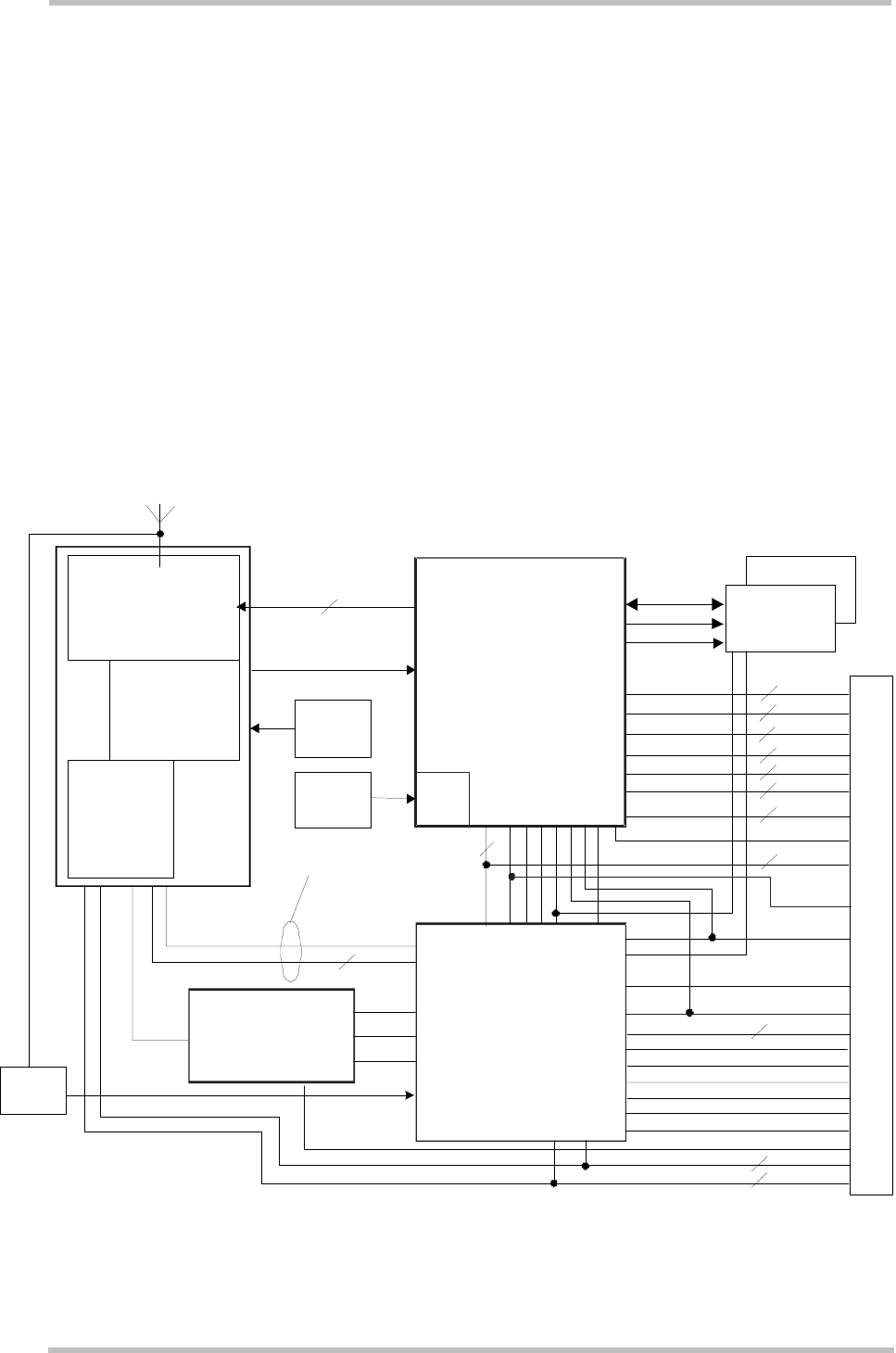
AC65/AC75 Hardware Interface Description
Confidential / Preliminary s
AC65/AC75_hd_v00.372 Page 22 of 118 2006-08-03
2.3 Circuit Concept
Figure 1 shows a block diagram of the AC65/AC75 module and illustrates the major
functional components:
Baseband block:
• Digital baseband processor with DSP
• Analog processor with power supply unit (PSU)
• Flash / SRAM (stacked)
• Application interface (board-to-board connector)
• Antenna diagnostic
RF section:
• RF transceiver
• RF power amplifier
• RF front end
• Antenna connector
Digital Baseband
Processer with DSP
BATT+
GND
IGT
EMERG_RST
ASC(0)
5SIM Interface
CCIN
CCRST
CCIO
CCCLK
CCVCC
D(0:15)
A(0:24)
RD; WR; CS; WAIT
RF Control Bus
Interface
RF - Baseband
NTC
BATT_TEMP
VDDLP
SYNC
Transceiver
RF Power
Amplifier
SRAM
Flash
6
5
8
8
AC65/AC75
I / Q
4
Audio analog
DAC_OUT
10
USB
GPIO
3
10
I2C/SPI
SPI
2
2
VEXT
ISENSE
VSENSE
VCHARGE
CHARGEGATE
3
RESET
BATTYPE
TEMP2
REFCHG
ASC(1)
4
26MHz
Front End
DAI
7
PWR_IND
Measuring
Network
32.768kHz
26MHz
RTC
Application Interface (80 pin)
RF-Part
Analog
Controller
with PSU
Reset
Antenna
Diagnostic
ADC
Figure 2: AC65/AC75 block diagram

AC65/AC75 Hardware Interface Description
Confidential / Preliminary s
AC65/AC75_hd_v00.372 Page 23 of 118 2006-08-03
3 Application Interface
AC65/AC75 is equipped with an 80-pin board-to-board connector that connects to the
external application. The host interface incorporates several sub-interfaces described in the
following chapters:
• Power supply - see Chapter 3.1
• Charger interface – see Chapter 3.5
• SIM interface - see Chapter 3.9
• Serial interface ASC0 - see Chapter 3.10
• Serial interface ASC1 - see Chapter 3.11
• Serial interface USB - see Chapter 3.12
• Serial interface I²C/SPI - see Chapter 3.13 and 3.14
• Two analog audio interfaces - see Chapter 3.15
• Digital audio interface (DAI) - see Chapter 3.15 and 3.15.4
• 10 lines GPIO interface – see Chapter 3.16
• Status and control lines: IGT, EMERG_RST, PWR_IND, SYNC - see Table 26

AC65/AC75 Hardware Interface Description
Confidential / Preliminary s
AC65/AC75_hd_v00.372 Page 24 of 118 2006-08-03
3.1 Operating Modes
The table below briefly summarizes the various operating modes referred to in the following
chapters.
Table 5: Overview of operating modes
GSM / GPRS SLEEP Various power save modes set with AT+CFUN
command.
Software is active to minimum extent. If the module was
registered to the GSM network in IDLE mode, it is
registered and paging with the BTS in SLEEP mode,
too. Power saving can be chosen at different levels:
The NON-CYCLIC SLEEP mode (AT+CFUN=0)
disables the AT interface. The CYCLIC SLEEP modes
AT+CFUN=7 and 9 alternatingly activate and deactivate
the AT interfaces to allow permanent access to all AT
commands.
GSM IDLE Software is active. Once registered to the GSM
network, paging with BTS is carried out. The module is
ready to send and receive.
GSM TALK Connection between two subscribers is in progress.
Power consumption depends on network coverage
individual settings, such as DTX off/on, FR/EFR/HR,
hopping sequences, antenna.
GPRS IDLE
EGPRS IDLE
Module is ready for GPRS/EGPRS data transfer, but no
data is currently sent or received. Power consumption
depends on network settings and GPRS/EGPRS
configuration (e.g. multislot settings).
Normal operation
GPRS DATA
EGPRS DATA
GPRS/EGPRS data transfer in progress. Power
consumption depends on network settings (e.g. power
control level), uplink / downlink data rates, GPRS
configuration (e.g. used multislot settings) and
reduction of maximum output power.
POWER DOWN Normal shutdown after sending the AT^SMSO command.
Only a voltage regulator is active for powering the RTC. Software is not active.
Interfaces are not accessible. Operating voltage (connected to BATT+) remains
applied.

AC65/AC75 Hardware Interface Description
Confidential / Preliminary s
AC65/AC75_hd_v00.372 Page 25 of 118 2006-08-03
Airplane mode Airplane mode shuts down the radio part of the module, causes the module to
log off from the GSM/GPRS network and disables all AT commands whose
execution requires a radio connection.
Airplane mode can be controlled by using the AT commands AT^SCFG and
AT+CALA:
• With AT^SCFG=MEopMode/Airplane/OnStart the module can be configured
to enter the Airplane mode each time when switched on or reset.
• The parameter AT^SCFG=MEopMode/Airplane can be used to switch back
and forth between Normal mode and Airplane mode any time during
operation.
• Setting an alarm time with AT+CALA followed by AT^SMSO wakes the
module up into Airplane mode at the scheduled time.
Charge-only mode Limited operation for battery powered applications. Enables charging while
module is detached from GSM network. Limited number of AT commands is
accessible. Charge-only mode applies when the charger is connected if the
module was powered down with AT^SMSO.
Charge mode
during normal
operation
Normal operation (SLEEP, IDLE, TALK, GPRS/EGPRS IDLE, GPRS/EGPRS
DATA) and charging running in parallel. Charge mode changes to Charge-only
mode when the module is powered down before charging has been completed.
See Table 11 for the various options proceeding from one mode to another.

AC65/AC75 Hardware Interface Description
Confidential / Preliminary s
AC65/AC75_hd_v00.372 Page 26 of 118 2006-08-03
3.2 Power Supply
AC65/AC75 needs to be connected to a power supply at the B2B connector (5 pins each
BATT+ and GND).
The power supply of AC65/AC75 has to be a single voltage source at BATT+. It must be able
to provide the peak current during the uplink transmission.
All the key functions for supplying power to the device are handled by the power
management section of the analog controller. This IC provides the following features:
• Stabilizes the supply voltages for the GSM baseband using low drop linear voltage
regulators.
• Switches the module's power voltages for the power-up and -down procedures.
• Delivers, across the VEXT pin, a regulated voltage for an external application. This
voltage is not available in Power-down mode.
• SIM switch to provide SIM power supply.
3.2.1 Minimizing Power Losses
When designing the power supply for your application please pay specific attention to power
losses. Ensure that the input voltage VBATT+ never drops below 3.3V on the AC65/AC75
board, not even in a transmit burst where current consumption can rise to typical peaks of
2A. It should be noted that AC65/AC75 switches off when exceeding these limits. Any
voltage drops that may occur in a transmit burst should not exceed 400mV.
The measurement network monitors outburst and inburst values. The drop is the difference
of both values. The maximum drop (Dmax) since the last start of the module will be saved. In
IDLE and SLEEP mode, the module switches off if the minimum battery voltage (Vbattmin) is
reached.
Example:
VImin = 3.3V
Dmax = 0.4V
Vbattmin = VImin + Dmax
Vbattmin = 3.3V + 0.4V = 3.7V
The best approach to reducing voltage drops is to use a board-to-board connection as
recommended, and a low impedance power source. The resistance of the power supply lines
on the host board and of a battery pack should also be considered.
Note: If the application design requires an adapter cable between both board-to-board
connectors, use a flex cable as short as possible in order to minimize power
losses.
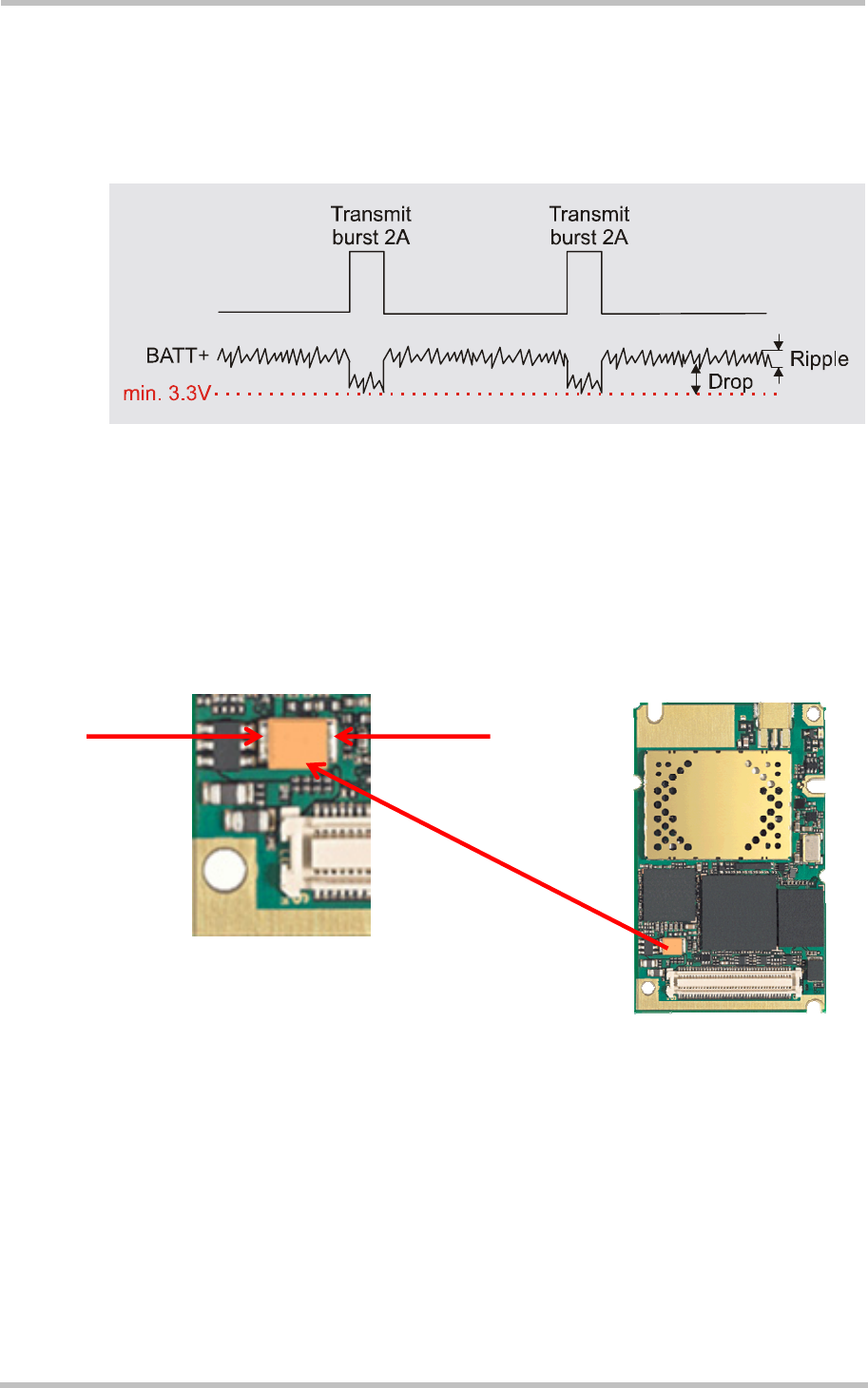
AC65/AC75 Hardware Interface Description
Confidential / Preliminary s
AC65/AC75_hd_v00.372 Page 27 of 118 2006-08-03
Example: If the length of the flex cable reaches the maximum length of 100mm, this
connection may cause, for example, a resistance of 30m in the BATT+ line and
30m in the GND line. As a result, a 2A transmit burst would add up to a total
voltage drop of 120mV. Plus, if a battery pack is involved, further losses may
occur due to the resistance across the battery lines and the internal resistance of
the battery including its protection circuit.
Figure 3: Power supply limits during transmit burst
3.2.2 Measuring the Supply Voltage VBATT+
The reference points for measuring the supply voltage VBATT+ on the module are BATT+ and
GND, both accessible at a capacitor located close to the board-to-board connector of the
module.
Figure 4: Position of the reference points BATT+ and GND
3.2.3 Monitoring Power Supply by AT Command
To monitor the supply voltage you can also use the AT^SBV command which returns the
value related to the reference points BATT+ and GND.
The module continuously measures the voltage at intervals depending on the operating
mode of the RF interface. The duration of measuring ranges from 0.5s in TALK/DATA mode
to 50s when AC65/AC75 is in IDLE mode or Limited Service (deregistered). The displayed
voltage (in mV) is averaged over the last measuring period before the AT^SBV command
was executed.
Reference
point
BATT+
Reference
point GND

AC65/AC75 Hardware Interface Description
Confidential / Preliminary s
AC65/AC75_hd_v00.372 Page 28 of 118 2006-08-03
3.3 Power-Up / Power-Down Scenarios
In general, be sure not to turn on AC65/AC75 while it is beyond the safety limits of voltage
and temperature stated in Chapter 5.1. AC65/AC75 would immediately switch off after having
started and detected these inappropriate conditions. In extreme cases this can cause
permanent damage to the module.
3.3.1 Turn on AC65/AC75
AC65/AC75 can be started in a variety of ways as described in the following sections:
• Hardware driven start-up by IGT line: starts Normal mode or Airplane mode (see Section
3.3.1.1)
• Software controlled reset by AT+CFUN command: starts Normal mode or Airplane mode
(see Section 3.3.1.4)
• Hardware driven start-up by VCHARGE line: starts charging algorithm and Charge-only
mode (see Section 3.3.1.3)
• Wake-up from Power-down mode by using RTC interrupt: starts Airplane mode
The option whether to start into Normal mode or Airplane mode depends on the settings
made with the AT^SCFG command or AT+CALA. With AT+CALA, followed by AT^SMSO the
module can be configured to restart into Airplane mode at a scheduled alarm time. Switching
back and forth between Normal mode and Airplane mode is possible any time during
operation by using the AT^SCFG command.
After startup or mode change the following URCs indicate the module’s ready state:
• “SYSSTART” indicates that the module has entered Normal mode.
• “^SYSSTART AIRPLANE MODE” indicates that the module has entered Airplane mode.
• “^SYSSTART CHARGE ONLY MODE” indicates that the module has entered the
Charge-only mode.
These URCs are indicated only if the module is set to a fixed bit rate, i.e. they do not appear
if autobauding is enabled (AT+IPR0).
Detailed explanations on AT^SCFG, AT+CFUN, AT+CALA, Airplane mode and AT+IPR can
be found in [1].
3.3.1.1 Turn on AC65/AC75 Using Ignition Line IGT
When AC65/AC75 is in Power-down mode or Charge-only mode, it can be started to Normal
mode or Airplane mode by driving the IGT (ignition) line to ground. This must be
accomplished with an open drain/collector driver to avoid current flowing into this pin.
The module will start up when both of the following two conditions are met:
• The supply voltage applied at BATT+ must be in the operating range.
• The IGT line needs to be driven low for at least 400ms in Power-down mode or at least
2s in Charge-only mode. When released IGT goes high and causes the module to start.
Considering different strategies of host application design the figures below show two
approaches to meet this requirement: The example in Figure 5 assumes that IGT is activated
after BATT+ has already been applied. The example in Figure 6 assumes that IGT is held
low before BATT+ is switched on. In either case, to power on the module, ensure that low
state of IGT takes at least 400ms (Power-down mode) or 2s (Charge-only mode) from the
moment the voltage at BATT+ is available. For Charge-only mode see also Chapter 3.5.6.
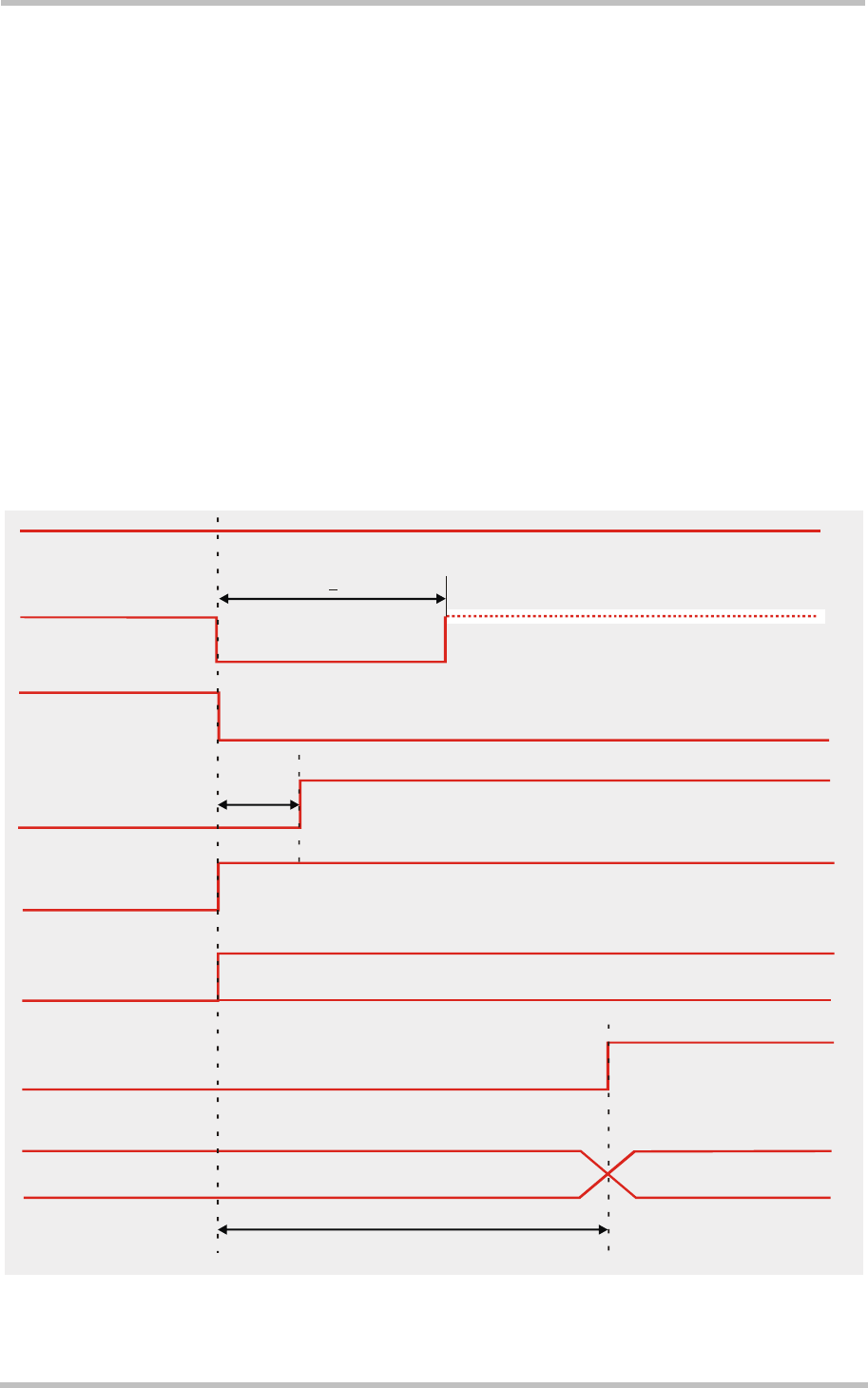
AC65/AC75 Hardware Interface Description
Confidential / Preliminary s
AC65/AC75_hd_v00.372 Page 29 of 118 2006-08-03
Assertion of CTS indicates that the module is ready to receive data from the host application.
In addition, if configured to a fixed bit rate (AT+IPR0), the module will send the URC
“^SYSSTART” or “^SYSSTART AIRPLANE MODE” which notifies the host application that
the first AT command can be sent to the module. The duration until this URC is output varies
with the SIM card and may take a couple of seconds.
Please note that no “^SYSSTART” or “^SYSSTART AIRPLANE MODE” URC will be
generated if autobauding (AT+IPR=0) is enabled.
To allow the application to detect the ready state of the module we recommend using
hardware flow control which can be set with AT\Q or AT+ICF (see [1] for details). The default
setting of AC65/AC75 is AT\Q0 (no flow control) which shall be altered to AT\Q3 (RTS/CTS
handshake). If the application design does not integrate RTS/CTS lines the host application
shall wait at least for the “^SYSSTART” or “^SYSSTART AIRPLANE MODE” URC. However,
if the URCs are neither used (due to autobauding) then the only way of checking the
module’s ready state is polling. To do so, try to send characters (e.g. “at”) until the module is
responding.
See also Chapter 3.3.2 “Signal States after Startup”
EMERG_RST
VEXT
TXD0/TXD1/RTS0/RST1/DTR0 (driven by the application)
CTS0/CTS1/DSR0/DCD0
ca. 500 ms
Interface pins
Undefined Defined
PWR_IND
t = 400ms
min
>
120ms
BATT+
IGT
HiZ
Figure 5: Power-on with operating voltage at BATT+ applied before activating IGT
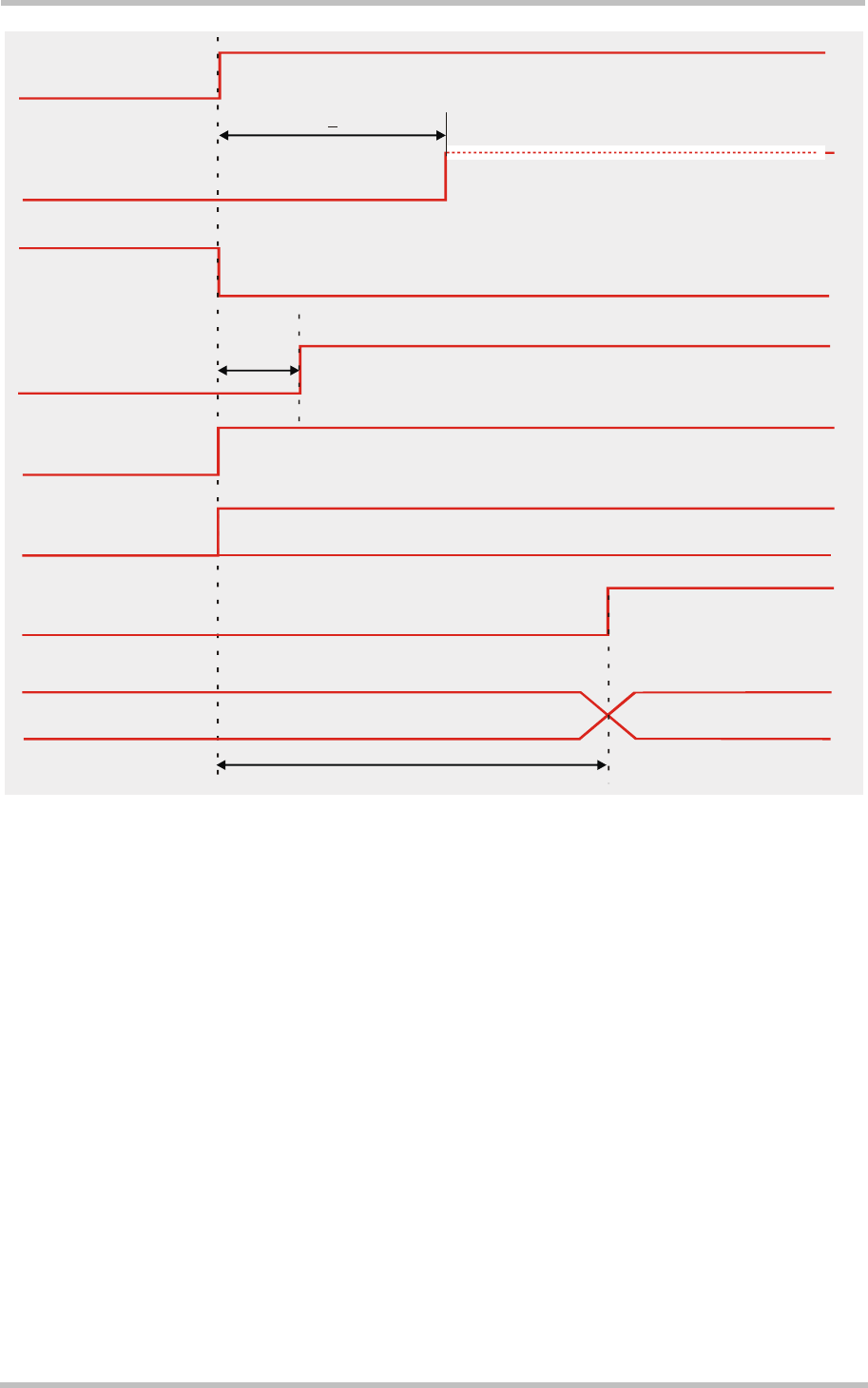
AC65/AC75 Hardware Interface Description
Confidential / Preliminary s
AC65/AC75_hd_v00.372 Page 30 of 118 2006-08-03
EMERG_RST
PWR_IND
t = 400ms
min
>
120ms
BATT+
IGT
HiZ
VEXT
TXD0/TXD1/RTS0/RST1/DTR0 (driven by the application)
CTS0/CTS1/DSR0/DCD0
Interface pins
Undefined Defined
ca. 500 ms
Figure 6: Power-on with IGT held low before switching on operating voltage at BATT+
If the IGT line is driven low for less than 400ms the module will, instead of starting up, send
only the alert message “SHUTDOWN after Illegal PowerUp” to the host application. The alert
message appears on the serial interfaces ASC0 and ASC1 at a fixed bit rate of 115200bps. If
other fixed bit rates or autobauding are set, the URC delivers only undefined characters. The
message will not be indicated on the USB interface.

AC65/AC75 Hardware Interface Description
Confidential / Preliminary s
AC65/AC75_hd_v00.372 Page 31 of 118 2006-08-03
3.3.1.2 Configuring the IGT Line for Use as ON/OFF Switch
The IGT line can be configured for use in two different switching modes: You can set the IGT
line to switch on the module only, or to switch it on and off. The switching mode is
determined by the parameter “MEShutdown/OnIgnition” of the AT^SCFG command. This
approach is useful for application manufacturers who wish to have an ON/OFF switch
installed on the host device.
By factory default, the ON/OFF switch mode of IGT is disabled:
at^scfg=meshutdown/onignition
^SCFG: "MEShutdown/OnIgnition","off"
OK
# Query the current status of IGT.
# IGT can be used only to switch on
AC65/AC75.
IGT works as described in Section 3.3.1.1.
To configure IGT for use as ON/OFF switch:
at^scfg=meshutdown/onignition,on
^SCFG: "MEShutdown/OnIgnition","on"
OK
# Enable the ON/OFF switch mode of IGT.
# IGT can be used to switch on and off
AC65/AC75.
We strongly recommend taking great care before changing the switching mode of the IGT
line. To ensure that the IGT line works properly as ON/OFF switch it is of vital importance
that the following conditions are met.
Switch-on condition: If the AC65/AC75 is off, the IGT line must be asserted for at least
400ms before being released. The module switches on after 400ms.
Switch-off condition: If the AC65/AC75 is on, the IGT line must be asserted for at least 1s
before being released. The module switches off after the line is
released.
The switch-off routine is identical with the procedure initiated by
AT^SMSO, i.e. the software performs an orderly shutdown as
described in Section 3.3.3.1.
Before switching off the module wait at least 2 seconds after startup.
ON OFF
~~~~|________|~~~~~~~~~~~~~|________|~~~~
| 0.4s | 2s | 1s |
Figure 7: Timing of IGT if used as ON/OFF switch

AC65/AC75 Hardware Interface Description
Confidential / Preliminary s
AC65/AC75_hd_v00.372 Page 32 of 118 2006-08-03
3.3.1.3 Turn on AC65/AC75 Using the VCHARGE Signal
As detailed in Section 3.5.6, the charging adapter can be connected regardless of the
module’s operating mode.
If the charger is connected to the charger input of the external charging circuit and the
module’s VCHARGE pin while AC65/AC75 is off, and the battery voltage is above the
undervoltage lockout threshold, processor controlled fast charging starts (see Section 3.5.5).
AC65/AC75 enters a restricted mode, referred to as Charge-only mode where only the
charging algorithm will be launched.
During the Charge-only mode AC65/AC75 is neither logged on to the GSM network nor are
the serial interfaces fully accessible. To switch from Charge-only mode to Normal mode the
ignition line (IGT) must be pulled low for at least 2 seconds. When released, the IGT line
goes high and causes the module to enter the Normal mode. See also Section 3.5.6.
3.3.1.4 Reset AC65/AC75 via AT+CFUN Command
To reset and restart the AC65/AC75 module use the command AT+CFUN. You can enter
AT+CFUN=,1 or AT+CFUN=x,1, where x may be in the range from 0 to 9. See [1] for details.
If configured to a fix baud rate (AT+IPR0), the module will send the URC “^SYSSTART” or
“^SYSSTART AIRPLANE MODE” to notify that it is ready to operate. If autobauding is
enabled (AT+IPR=0) there will be no notification. To register to the network SIM PIN
authentication is necessary after restart.

AC65/AC75 Hardware Interface Description
Confidential / Preliminary s
AC65/AC75_hd_v00.372 Page 33 of 118 2006-08-03
3.3.1.5 Reset or Turn off AC65/AC75 in Case of Emergency
Caution: Use the EMERG_RST pin only when, due to serious problems, the software is not
responding for more than 5 seconds. Pulling the EMERG_RST pin causes the loss of all
information stored in the volatile memory. Therefore, this procedure is intended only for use
in case of emergency, e.g. if AC65/AC75 does not respond, if reset or shutdown via AT
command fails.
The EMERG_RST signal is available on the application interface. To control the
EMERG_RST line it is recommended to use an open drain / collector driver.
The EMERG_RST line can be used to switch off or to reset the module. In any case the
EMERG_RST line must be pulled to ground for ≥10ms. Then, after releasing the
EMERG_RST line the module restarts if IGT is held low for at least 400ms. Otherwise, if IGT
is not low the module switches off. In this case, it can be restarted any time as described in
Section 3.3.1.1.
After hardware driven restart, notification via “^SYSSTART” or “^SYSSTART AIRPLANE”
URC is the same as in case of restart by IGT or AT command. To register to the network SIM
PIN authentication is necessary after restart.
3.3.1.6 Using EMERG_RST to Reset Application(s) or External Device(s)
When the module starts up, while IGT is held low for 400ms, the EMERG_RST signal goes
low for 120ms as shown in Figure 5 and Figure 6. During this 120ms period, EMERG_RST
becomes an output which can be used to reset application(s) or external device(s) connected
to the module.
After the 120ms period, i.e. during operation of the module, the EMERG_RST is an input.
Specifications of the input and output mode of EMERG_RST can be found in Table 26.

AC65/AC75 Hardware Interface Description
Confidential / Preliminary s
AC65/AC75_hd_v00.372 Page 34 of 118 2006-08-03
3.3.2 Signal States after Startup
Table 6 describes the various states each interface pin passes through after startup and
during operation.
As shown in Figure 5 and Figure 6 the pins are in undefined state while the module is
initializing. Once the startup initialization has completed, i.e. when CTS is high and the
software is running, all pins are in defined state. The state of several pins will change again
once the respective interface is activated or configured by AT command.
Table 6: Signal states
Active state after configuration by AT command Signal name Undefined state
during startup
Defined state after
initialization GPIO SPI I2C DAI
SYNC L O
CCIN I, PU(100k) I, PU(100k)
CCRST L O
CCIO L O
CCCLK L O
CCVCC L 2.9V
RXD0 I, PU O
TXD0 I, PU I, PD(330k)
CTS0 L O
RTS0 I, PU I, PD(330k)
DTR0 I, PU I
DCD0 L O
DSR0 L O
RING0 I, PU O
RXD1 H O
TXD1 I, PD(330k) I, PD(330k)
CTS1 L O
RTS1 I, PD(330k) I, PD(330k)
SPIDI I Tristate I Tristate
SPICS I Tristate O Tristate
I2CDAT_SPIDO I O O IO
I2CCLK_SPICLK I O O O
GPIO1 I, PU Tristate IO
GPIO2 I, PU Tristate IO
GPIO3 I, PU Tristate IO
GPIO4 I, PD Tristate IO
GPIO5 L Tristate IO
GPIO6 I Tristate IO
GPIO7 I, PU Tristate IO
GPIO8 L Tristate IO
GPIO9 I Tristate IO
GPIO10 I Tristate IO
DAC_OUT L O
DAI0 I Tristate O
DAI1 I Tristate I
DAI2 I Tristate O
DAI3 I Tristate O
DAI4 I Tristate I
DAI5 I Tristate I
DAI6 I Tristate I
For abbreviations, see below.

AC65/AC75 Hardware Interface Description
Confidential / Preliminary s
AC65/AC75_hd_v00.372 Page 35 of 118 2006-08-03
Abbreviations used in Table 6:
L = Low output level
H = High output level
I = Input
O = Output
PD = Pull down with min +15µA and max. +100µA
PD(…k) = Fix pull down resistor
PU = Pull up with min -15µA and max. -100µA
PU(…k) = Fix pull up resistor

AC65/AC75 Hardware Interface Description
Confidential / Preliminary s
AC65/AC75_hd_v00.372 Page 36 of 118 2006-08-03
3.3.3 Turn off AC65/AC75
AC65/AC75 can be turned off as follows:
• Normal shutdown: Software controlled by AT^SMSO command
• Automatic shutdown: Takes effect if board or battery temperature is out of range or if
undervoltage or overvoltage conditions occur.
3.3.3.1 Turn off AC65/AC75 Using AT Command
The best and safest approach to powering down AC65/AC75 is to issue the AT^SMSO
command. This procedure lets AC65/AC75 log off from the network and allows the software
to enter into a secure state and safe data before disconnecting the power supply. The mode
is referred to as Power-down mode. In this mode, only the RTC stays active.
Before switching off the device sends the following response:
^SMSO: MS OFF
OK
^SHUTDOWN
After sending AT^SMSO do not enter any other AT commands. There are two ways to verify
when the module turns off:
• Wait for the URC “^SHUTDOWN”. It indicates that data have been stored non-volatile
and the module turns off in less than 1 second.
• Also, you can monitor the PWR_IND pin. High state of PWR_IND definitely indicates that
the module is switched off.
Be sure not to disconnect the supply voltage VBATT+ before the URC “^SHUTDOWN” has
been issued and the PWR_IND signal has gone high. Otherwise you run the risk of losing
data. Signal states during turn-off are shown in Figure 8.
While AC65/AC75 is in Power-down mode the application interface is switched off and must
not be fed from any other source. Therefore, your application must be designed to avoid any
current flow into any digital pins of the application interface, especially of the serial
interfaces. No special care is required for the USB interface which is protected from reverse
current.
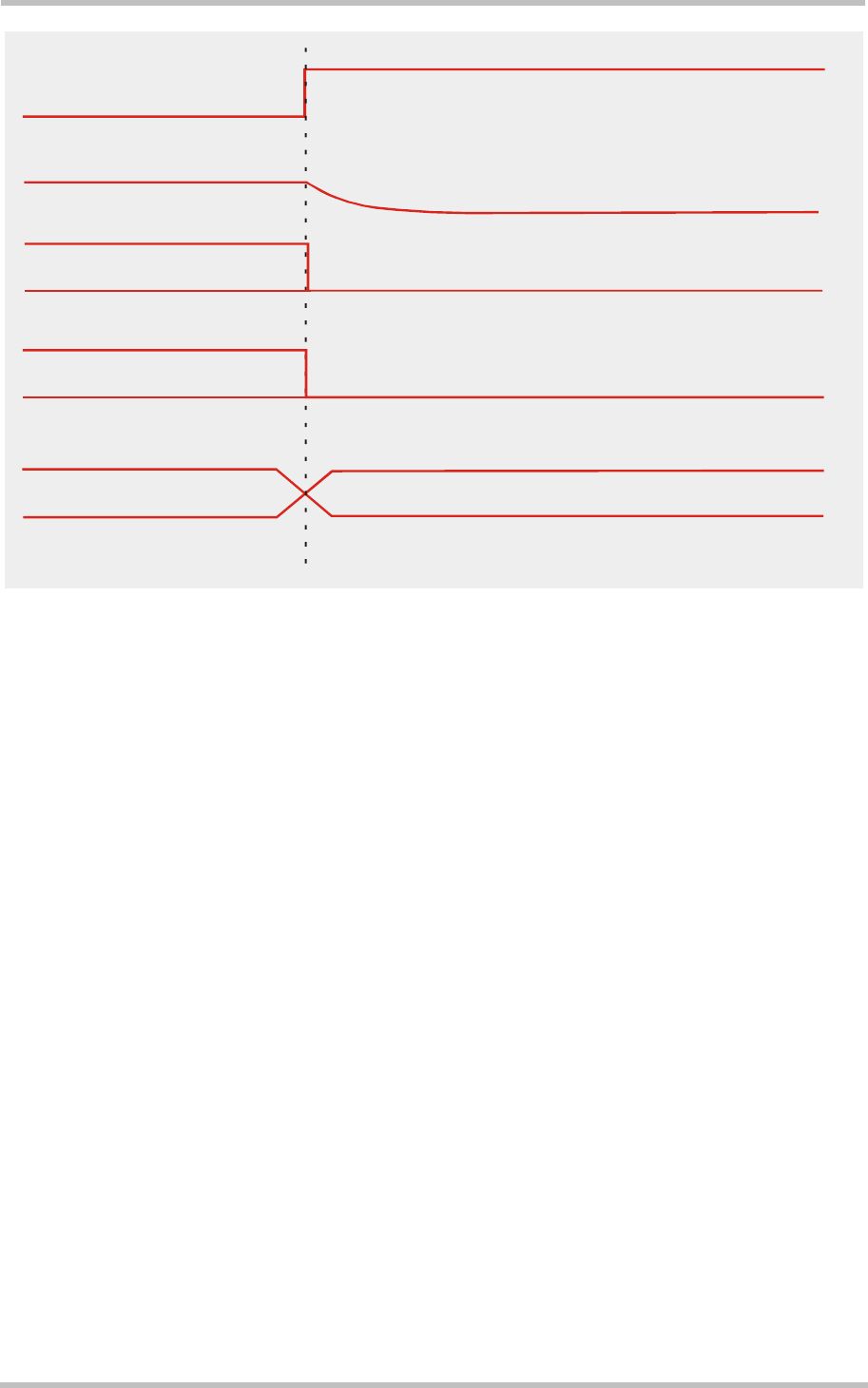
AC65/AC75 Hardware Interface Description
Confidential / Preliminary s
AC65/AC75_hd_v00.372 Page 37 of 118 2006-08-03
VEXT See note 1
TXD0/TXD1/RTS0/RTS1/DTR0 (driven by the application)
Interface pins
Undefined
Defined
PWR_IND
CTS0/CTS1/DSR0/DTR0
Figure 8: Signal states during turn-off procedure
Note 1: Depending on capacitance load from host application
3.3.3.2 Leakage Current in Power-Down Mode
The leakage current in Power-down mode varies depending on the following conditions:
• If the supply voltage at BATT+ was disconnected and then applied again without starting
up the AC65/AC75 module, the leakage current ranges between 90µA and 100µA.
• If the AC65/AC75 module is started and afterwards powered down with AT^SMSO, then
the leakage current is only 50µA.
Therefore, in order to minimize the leakage current take care to start up the module at least
once before it is powered down.

AC65/AC75 Hardware Interface Description
Confidential / Preliminary s
AC65/AC75_hd_v00.372 Page 38 of 118 2006-08-03
3.3.3.3 Turn on/off AC65/AC75 Applications with Integrated USB
In a Windows environment, the USB COM port emulation causes the USB port of
AC65/AC75 to appear as a virtual COM port (VCOM port). The VCOM port emulation is only
present when Windows can communicate with the module, and is lost when the module
shuts down. Therefore, the host application or Terminal program must be disconnected from
the USB VCOM port each time the module is restarted.
Restart after shutdown with AT^SMSO:
After entering the power-down command AT^SMSO on one of the interfaces (ASC0, ASC1,
USB) the host application or Terminal program used on the USB VCOM port must be closed
before the module is restarted by activating the IGT line.
Software reset with AT+CFUN=x,1:
Likewise, when using the reset command AT+CFUN=x,1 on one of the interfaces (ASC0,
ASC1, USB) ensure that the host application or Terminal program on the USB VCOM port be
closed down before the module restarts.
Note that if AT+CFUN=x,1 is entered on the USB interface the application or Terminal
program on the USB VCOM port must be closed immediately after the response OK is
returned.

AC65/AC75 Hardware Interface Description
Confidential / Preliminary s
AC65/AC75_hd_v00.372 Page 39 of 118 2006-08-03
3.3.4 Automatic Shutdown
Automatic shutdown takes effect if:
• the AC65/AC75 board is exceeding the critical limits of overtemperature or
undertemperature
• the battery is exceeding the critical limits of overtemperature or undertemperature
• undervoltage or overvoltage is detected
See Charge-only mode described in Section 3.5.6 for exceptions.
The automatic shutdown procedure is equivalent to the Power-down initiated with the
AT^SMSO command, i.e. AC65/AC75 logs off from the network and the software enters a
secure state avoiding loss of data.
Alert messages transmitted before the device switches off are implemented as Unsolicited
Result Codes (URCs). The URC presentation mode varies with the condition, please see
Chapters 3.3.4.1 to 3.3.4.5 for details. For further instructions on AT commands refer to [1].
3.3.4.1 Thermal Shutdown
The board temperature is constantly monitored by an internal NTC resistor located on the
PCB. The NTC that detects the battery temperature must be part of the battery pack circuit
as described in 3.5.3 The values detected by either NTC resistor are measured directly on
the board or the battery and therefore, are not fully identical with the ambient temperature.
Each time the board or battery temperature goes out of range or back to normal, AC65/AC75
instantly displays an alert (if enabled).
• URCs indicating the level "1" or "-1" allow the user to take appropriate precautions, such
as protecting the module from exposure to extreme conditions. The presentation of the
URCs depends on the settings selected with the AT^SCTM write command:
AT^SCTM=1: Presentation of URCs is always enabled.
AT^SCTM=0 (default): Presentation of URCs is enabled for 15 seconds time after
start-up of AC65/AC75. After 15 seconds operation, the presentation will be disabled,
i.e. no alert messages can be generated.
• URCs indicating the level "2" or "-2" are instantly followed by an orderly shutdown. The
presentation of these URCs is always enabled, i.e. they will be output even though the
factory setting AT^SCTM=0 was never changed.
The maximum temperature ratings are stated in Chapter 5.2. Refer to Table 7 for the
associated URCs.

AC65/AC75 Hardware Interface Description
Confidential / Preliminary s
AC65/AC75_hd_v00.372 Page 40 of 118 2006-08-03
Table 7: Temperature dependent behavior
Sending temperature alert (2min after AC65/AC75 start-up, otherwise only if URC presentation
enabled)
^SCTM_A: 1 Caution: Battery close to overtemperature limit.
^SCTM_B: 1 Caution: Bboard close to overtemperature limit.
^SCTM_A: -1 Caution: Battery close to undertemperature limit.
^SCTM_B: -1 Caution: Board close to undertemperature limit.
^SCTM_A: 0 Battery back to uncritical temperature range.
^SCTM_B: 0 Board back to uncritical temperature range.
Automatic shutdown (URC appears no matter whether or not presentation was enabled)
^SCTM_A: 2 Alert: Battery equal or beyond overtemperature limit. AC65/AC75 switches off.
^SCTM_B: 2 Alert: Board equal or beyond overtemperature limit. AC65/AC75 switches off.
^SCTM_A: -2 Alert: Battery equal or below undertemperature limit. AC65/AC75 switches off.
^SCTM_B: -2 Alert: Board equal or below undertemperature limit. AC65/AC75 switches off.
3.3.4.2 Deferred Shutdown at Extreme Temperature Conditions
In the following cases, shutdown will be deferred if a critical temperature limit is exceeded:
• while an emergency call is in progress
• during a two minute guard period after power-up. This guard period has been introduced
in order to allow the user to make an emergency call. The start of an emergency call
extends the guard period until the end of the call. Any other network activity may be
terminated by shutdown upon expiry of the guard time. The guard period starts again
when the module registers to the GSM network the first time after power-up.
If the temperature is still out of range after the guard period expires or the call ends, the
module switches off immediately (without another alert message).
CAUTION! Automatic shutdown is a safety feature intended to prevent damage to the
module. Extended usage of the deferred shutdown functionality may result in damage to the
module, and possibly other severe consequences.
3.3.4.3 Monitoring the Board Temperature of AC65/AC75
The AT^SCTM command can also be used to check the present status of the board.
Depending on the selected mode, the read command returns the current board temperature
in degrees Celsius or only a value that indicates whether the board is within the safe or
critical temperature range. See [1] for further instructions.
3.3.4.4 Undervoltage Shutdown if Battery NTC is Present
In applications where the module’s charging technique is used and an NTC is connected to
the BATT_TEMP terminal, the software constantly monitors the applied voltage. If the
measured battery voltage is no more sufficient to set up a call the following URC will be
presented:
^SBC: Undervoltage.

AC65/AC75 Hardware Interface Description
Confidential / Preliminary s
AC65/AC75_hd_v00.372 Page 41 of 118 2006-08-03
The message will be reported, for example, when you attempt to make a call while the
voltage is close to the shutdown threshold of 3.2V and further power loss is caused during
the transmit burst. In IDLE mode, the shutdown threshold is the sum of the module’s
minimum supply voltage (3.2V) and the value of the maximum voltage drop resulting from
earlier calls. This means that in IDLE mode the actual shutdown threshold may be higher
than 3.2V. Therefore, to properly calculate the actual shutdown threshold application
manufacturers are advised to measure the maximum voltage drops that may occur during
transmit bursts.
To remind you that the battery needs to be charged soon, the URC appears several times
before the module switches off.
This type of URC does not need to be activated by the user. It will be output automatically
when fault conditions occur.
3.3.4.5 Undervoltage Shutdown if no Battery NTC is Present
The undervoltage protection is also effective in applications, where no NTC connects to the
BATT_TEMP terminal. Thus, you can take advantage of this feature even though the
application handles the charging process or AC65/AC75 is fed by a fixed supply voltage.
Whenever the supply voltage falls below the value of 3.2V the URC
^SBC: Undervoltage
appears several times before the module switches off.
This type of URC does not need to be activated by the user. It will be output automatically
when fault conditions occur.
3.3.4.6 Overvoltage Shutdown
The overvoltage shutdown threshold is 100mV above the maximum supply voltage VBATT+
specified in Table 27.
When the supply voltage approaches the overvoltage shutdown threshold the module will
send the URC
^SBC: Overvoltage warning.
This alert is sent once.
When the overvoltage shutdown threshold is exceeded the module will send the URC
^SBC: Overvoltage shutdown,
before it shuts down cleanly.
This type of URC does not need to be activated by the user. It will be output automatically
when fault conditions occur.
Keep in mind that several AC65/AC75 components are directly linked to BATT+ and,
therefore, the supply voltage remains applied at major parts of AC65/AC75, even if the
module is switched off. Especially the power amplifier is very sensitive to high voltage and
might even be destroyed.

AC65/AC75 Hardware Interface Description
Confidential / Preliminary s
AC65/AC75_hd_v00.372 Page 42 of 118 2006-08-03
3.4 Automatic EGPRS/GPRS Multislot Class Change
Temperature control is also effective for operation in EGPRS Multislot Class 10 (AC75 only),
GPRS Multislot Class 10 and GPRS Multislot Class 12. If the board temperature rises close
to the limit specified for normal operation1 while data are transmitted over EGPRS or GPRS,
the module automatically reverts
• from EGPRS Multislot Class 10 (2Tx slots) to EGPRS Multislot Class 8 (1Tx),
• from GPRS Multislot Class 12 (4Tx slots) to GPRS Multislot Class 8 (1Tx),
• from GPRS Multislot Class 10 (2Tx slots) to GPRS Multislot Class 8 (1Tx)
This reduces the power consumption and, consequently, causes the board’s temperature to
decrease. Once the temperature drops by 5 degrees, AC65/AC75 returns to the higher
Multislot Class. If the temperature stays at the critical level or even continues to rise,
AC65/AC75 will not switch back to the higher class.
After a transition from EGPRS Multislot Class 10 to EGPRS Multislot Class 8 a possible
switchback to EGPRS Multislot Class 10 is blocked for one minute. The same applies when
a transition occurs from GPRS Multislot Class 12 or 10 to GPRS Multislot Class 8.
Please note that there is not one single cause of switching over to a lower Multislot Class.
Rather it is the result of an interaction of several factors, such as the board temperature that
depends largely on the ambient temperature, the operating mode and the transmit power.
Furthermore, take into account that there is a delay until the network proceeds to a lower or,
accordingly, higher Multislot Class. The delay time is network dependent. In extreme cases,
if it takes too much time for the network and the temperature cannot drop due to this delay,
the module may even switch off as described in Section 3.3.4.1.
1 See Chapter 5.2 for temperature limits.

AC65/AC75 Hardware Interface Description
Confidential / Preliminary s
AC65/AC75_hd_v00.372 Page 43 of 118 2006-08-03
3.5 Charging Control
AC65/AC75 integrates a charging management for rechargeable Lithium Ion and Lithium
Polymer batteries. You can skip this chapter if charging is not your concern, or if you are not
using the implemented charging algorithm.
The following sections contain an overview of charging and battery specifications. Please
refer to [4] for greater detail, especially regarding requirements for batteries and chargers,
appropriate charging circuits, recommended batteries and an analysis of operational issues
typical of battery powered GSM/GPRS applications.
3.5.1 Hardware Requirements
AC65/AC75 has no on-board charging circuit. To benefit from the implemented charging
management you are required to install a charging circuit within your application according to
the Figure 46.
3.5.2 Software Requirements
Use the command AT^SBC, parameter <current>, to enter the current consumption of the
host application. This information enables the AC65/AC75 module to correctly determine the
end of charging and terminate charging automatically when the battery is fully charged. If the
<current> value is inaccurate and the application draws a current higher than the final charge
current, either charging will not be terminated or the battery fails to reach its maximum
voltage. Therefore, the termination condition is defined as: current consumption dependent
on the operating mode of the ME plus current consumption of the external application. If
used the current flowing over the VEXT pin of the application interface must be added, too.
The parameter <current> is volatile, meaning that the factory default (0mA) is restored each
time the module is powered down or reset. Therefore, for better control of charging, it is
recommended to enter the value every time the module is started.
See [1] for details on AT^SBC.

AC65/AC75 Hardware Interface Description
Confidential / Preliminary s
AC65/AC75_hd_v00.372 Page 44 of 118 2006-08-03
3.5.3 Battery Pack Requirements
The charging algorithm has been optimized for rechargeable Lithium batteries that meet the
characteristics listed below and in Table 8. It is recommended that the battery pack you want
to integrate into your AC65/AC75 application is compliant with these specifications. This
ensures reliable operation, proper charging and, particularly, allows you to monitor the
battery capacity using the AT^SBC command. Failure to comply with these specifications
might cause AT^SBC to deliver incorrect battery capacity values.
• Li-Ion or Lithium Polymer battery pack specified for a maximum charging voltage of 4.2V
and a recommended capacity of 1000 to 1200mAh.
• Since charging and discharging largely depend on the battery temperature, the battery
pack should include an NTC resistor. If the NTC is not inside the battery it must be in
thermal contact with the battery. The NTC resistor must be connected between
BATT_TEMP and GND.
The B value of the NTC should be in the range: 10kΩ +5% @ 25°C, B25/85 = 3423K to B
=3435K ± 3% (alternatively acceptable: 10kΩ +2% @ 25°C, B25/50 = 3370K +3%). Please
note that the NTC is indispensable for proper charging, i.e. the charging process will not
start if no NTC is present.
• Ensure that the pack incorporates a protection circuit capable of detecting overvoltage
(protection against overcharging), undervoltage (protection against deep discharging)
and overcurrent. Due to the discharge current profile typical of GSM applications, the
circuit must be insensitive to pulsed current.
• On the AC65/AC75 module, a built-in measuring circuit constantly monitors the supply
voltage. In the event of undervoltage, it causes AC65/AC75 to power down. Undervoltage
thresholds are specific to the battery pack and must be evaluated for the intended model.
When you evaluate undervoltage thresholds, consider both the current consumption of
AC65/AC75 and of the application circuit.
• The internal resistance of the battery and the protection should be as low as possible. It
is recommended not to exceed 150m, even in extreme conditions at low temperature.
The battery cell must be insensitive to rupture, fire and gassing under extreme conditions
of temperature and charging (voltage, current).
• The battery pack must be protected from reverse pole connection. For example, the
casing should be designed to prevent the user from mounting the battery in reverse
orientation.
• It is recommended that the battery pack be approved to satisfy the requirements of CE
conformity.
Figure 9 shows the circuit diagram of a typical
battery pack design that includes the protection
elements described above.
Figure 9: Battery pack circuit diagram
to BATT_TEMP to GND
NTC
Polyfuse
ϑ
Protection Circuit
+-
Battery cell
to BATT+

AC65/AC75 Hardware Interface Description
Confidential / Preliminary s
AC65/AC75_hd_v00.372 Page 45 of 118 2006-08-03
Table 8: Specifications of battery packs suitable for use with AC65/AC75
Battery type Rechargeable Lithium Ion or Lithium Polymer battery
Nominal voltage 3.6V / 3.7V
Capacity Recommended: 1000mAh to 1200mAh
Minimum: 500mAh
NTC 10k ± 5% @ 25°C
approx. 5k @ 45°C
approx. 26.2k @ 0°C
B value range: B (25/85)=3423K to B =3435K ± 3%
Overcharge detection voltage 4.325 ± 0.025V
Overdischarge detection voltage 2.5V
Overdischarge release voltage 2.6V
Overcurrent detection 3 ± 0.5A
Overcurrent detection delay time 4 ~ 16ms
Short detection delay time 50µs
Internal resistance <130m
Note: A maximum internal resistance of 150m should not
be exceeded even after 500 cycles and under extreme
conditions.
3.5.4 Charger Requirements
For using the implemented charging algorithm and the reference charging circuit
recommended in [4] and in Figure 46, the charger has to meet the following requirements:
Output voltage: 5.2Volts ±0.2V (stabilized voltage)
Output current: 500mA
Chargers with a higher output current are acceptable, but please
consider that only 500mA will be applied when a 0.3Ohms shunt
resistor is connected between VSENSE and ISENSE. See [4] for
further details.

AC65/AC75 Hardware Interface Description
Confidential / Preliminary s
AC65/AC75_hd_v00.372 Page 46 of 118 2006-08-03
3.5.5 Implemented Charging Technique
If all requirements listed above are met (appropriate external charging circuit of application,
battery pack, charger, AT^SBC settings) then charging is enabled in various stages
depending on the battery condition:
Trickle charging:
• Trickle charge current flows over the VCHARGE line.
• Trickle charging is done when a charger is present (connected to VCHARGE) and the
battery is deeply discharged or has undervoltage. If deeply discharged (Deep Discharge
Lockout at VBATT+= <2.5V) the battery is charged with 5mA, in case of undervoltage
(Undervoltage Lockout at VBATT+= 2.5…3.2V) it is charged with 30mA.
Software controlled charging:
• Controlled over the CHARGEGATE.
• Temperature conditions: 0°C to 45°C
• Software controlled charging is done when the charger is present (connected to
VCHARGE) and the battery voltage is at least above the undervoltage threshold.
Software controlled charging passes the following stages:
- Power ramp: Depending on the discharge level of the battery (i.e. the measured battery
voltage VBATT+) the software adjusts the maximum charge current for charging the
battery. The duration of power ramp charging is very short (less than 30 seconds).
- Fast charging: Battery is charged with constant current (approx. 500mA) until the
battery voltage reaches 4.2V (approx. 80% of the battery capacity).
- Top-up charging: The battery is charged with constant voltage of 4.2V at stepwise
reducing charge current until full battery capacity is reached.
Duration of charging:
• AC65/AC75 provides two charging timers: a software controlled timer set to 4 hours and
a hardware controlled timer set to 4.66 hours.
- The duration of software controlled charging depends on the battery capacity and the
level of discharge. Normally, charging stops when the battery is fully charged or, at the
latest, when the software timer expires after 4 hours.
- The hardware timer is provided to prevent runaway charging and to stop charging if the
software is not responding. The hardware timer will start each time the charger is
plugged to the VCHARGE line.

AC65/AC75 Hardware Interface Description
Confidential / Preliminary s
AC65/AC75_hd_v00.372 Page 47 of 118 2006-08-03
3.5.6 Operating Modes during Charging
Of course, the battery can be charged regardless of the engine's operating mode. When the
GSM module is in Normal mode (SLEEP, IDLE, TALK, GPRS IDLE or GPRS DATA mode), it
remains operational while charging is in progress (provided that sufficient voltage is applied).
The charging process during the Normal mode is referred to as Charge mode.
If the charger is connected to the charger input of the external charging circuit and the
module’s VCHARGE pin while AC65/AC75 is in Power-down mode, AC65/AC75 goes into
Charge-only mode.
While the charger remains connected it is not possible to switch the module off by using the
AT^SMSO command or the automatic shutdown mechanism. Instead the following applies:
• If the module is in Normal mode and the charger is connected (Charge mode) the
AT^SMSO command causes the module to shut down shortly and then start into the
Charge-only mode.
• In Charge-only mode the AT^SMSO command is not usable.
• In Charge-only mode the module neither switches off when the battery or the module
exceeds the critical limits of overtemperature or undertemperature.
In these cases you can only switch the module off by disconnecting the charger.
To proceed from Charge-only mode to another operating mode you have the following
options, provided that the battery voltage is at least above the undervoltage threshold.
• To switch from Charge-only mode to Normal mode you have two ways:
- Hardware driven: The ignition line (IGT) must be pulled low for at least 2 seconds.
When released, the IGT line goes high and causes the module to enter the Normal
mode.
- AT command driven: Set the command AT^SCFG=MEopMode/Airplane,off (please do
so although the current status of Airplane mode is already “off”). The module will enter
the Normal mode, indicated by the “^SYSSTART” URC.
• To switch from Charge-only mode to Airplane mode set the command
AT^SCFG=MEopMode/Airplane,on. The mode is indicated by the URC “^SYSSTART
AIRPLANE MODE”.
• If
AT^SCFG=MEopMode/Airplane/OnStart,on is set, driving the ignition line (IGT)
activates the Airplane mode. The mode is indicated by the URC “^SYSSTART
AIRPLANE MODE”.
Table 9: AT commands available in Charge-only mode
AT command Use
AT+CALA Set alarm time, configure Airplane mode.
AT+CCLK Set date and time of RTC.
AT^SBC Query status of charger connection.
AT^SBV Monitor supply voltage.
AT^SCTM Query temperature range, enable/disable URCs to report critical temperature
ranges
AT^SCFG Enable/disable parameters MEopMode/Airplane or MEopMode/Airplane/OnStart

AC65/AC75 Hardware Interface Description
Confidential / Preliminary s
AC65/AC75_hd_v00.372 Page 48 of 118 2006-08-03
Table 10: Comparison Charge-only and Charge mode
How to activate mode
Description of mode
Charge mode
Connect charger to charger input of host
application charging circuit and module’s
VCHARGE pin while AC65/AC75 is
• operating, e.g. in IDLE or TALK mode
• in SLEEP mode
• Battery can be charged while GSM module
remains operational and registered to the
GSM network.
• In IDLE and TALK mode, the serial interfaces
are accessible. All AT commands can be
used to full extent.
NOTE: If the module operates at maximum
power level (PCL5) and GPRS Class 12 at the
same time the current consumption is higher than
the current supplied by the charger.
Charge-only mode
Connect charger to charger input of host
application charging circuit and module’s
VCHARGE pin while AC65/AC75 is
• in Power-down mode
• in Normal mode: Connect charger to
the VCHARGE pin, then enter
AT^SMSO.
NOTE: While trickle charging is in
progress, be sure that the host
application is switched off. If the
application is fed from the trickle charge
current the module might be prevented
from proceeding to software controlled
charging since the current would not be
sufficient.
• Battery can be charged while GSM engine is
deregistered from GSM network.
• Charging runs smoothly due to constant
current consumption.
• The AT interface is accessible and allows to
use the commands listed below.

AC65/AC75 Hardware Interface Description
Confidential / Preliminary s
AC65/AC75_hd_v00.372 Page 49 of 118 2006-08-03
3.6 Power Saving
Intended for power saving, SLEEP mode reduces the functionality of the AC65/AC75 to a
minimum and thus minimizes the current consumption. Settings can be made using the
AT+CFUN command. For details see [1]. SLEEP mode falls in two categories:
• NON-CYCLIC SLEEP mode: AT+CFUN = 0
• CYCLIC SLEEP modes, AT+CFUN = 7 or 9.
The functionality level AT+CFUN=1 is where power saving is switched off. This is the default
after startup.
NON-CYCLIC SLEEP mode permanently blocks the serial interface. The benefit of the
CYCLIC SLEEP mode is that the serial interface remains accessible and that, in intermittent
wake-up periods, characters can be sent or received without terminating the selected mode.
This allows the AC65/AC75 to wake up for the duration of an event and, afterwards, to
resume power saving. Please refer to [1] for a summary of all SLEEP modes and the
different ways of waking up the module.
For CYCLIC SLEEP mode both the AC65/AC75 and the application must be configured to
use hardware flow control. This is necessary since the CTSx signal is set/reset every 0.9-2.7
seconds in order to indicate to the application when the UART is active. Please refer to [1] for
details on how to configure hardware flow control for the AC65/AC75.
Note: Although not explicitly stated, all explanations given in this section refer equally to
ASC0 and ASC1, and accordingly to CTS0 and CTS1 or RTS0 and RTS1.
3.6.1 Network Dependency of SLEEP Modes
The power saving possibilities of SLEEP modes depend on the network the module is
registered in. The paging timing cycle varies with the base station. The duration of a paging
interval can be calculated from the following formula:
t = 4.615 ms (TDMA frame duration) * 51 (number of frames) * DRX value.
DRX (Discontinuous Reception) is a value from 2 to 9, resulting in paging intervals from
0.47-2.12 seconds. The DRX value of the base station is assigned by the network operator.
In the pauses between listening to paging messages, the module resumes power saving, as
shown in Figure 10.
Figure 10: Power saving and paging
The varying pauses explain the different potential for power saving. The longer the pause the
less power is consumed.
0.47-2.12 s 0.47-2.12 s 0.47-2.12 s
Paging Paging Paging Paging
Power Saving Power Saving Power Saving
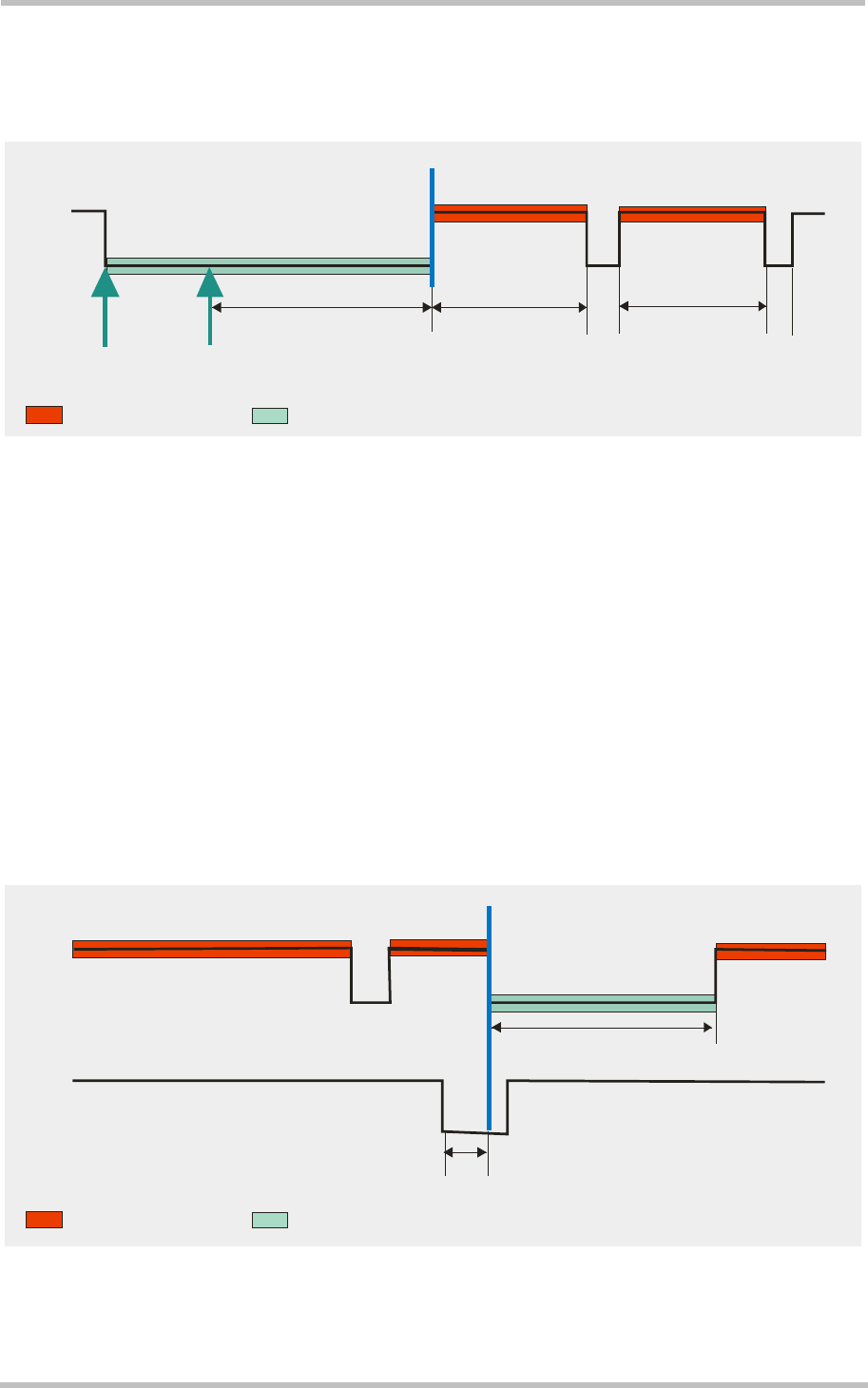
AC65/AC75 Hardware Interface Description
Confidential / Preliminary s
AC65/AC75_hd_v00.372 Page 50 of 118 2006-08-03
3.6.2 Timing of the CTSx Signal in CYCLIC SLEEP Mode 7
Figure 11 illustrates the CTSx signal timing in CYCLIC SLEEP mode 7 (CFUN=7).
Figure 11: Timing of CTSx signal (if CFUN= 7)
With regard to programming or using timeouts, the UART must take the varying CTS
inactivity periods into account.
3.6.3 Timing of the RTSx Signal in CYCLIC SLEEP Mode 9
In SLEEP mode 9 the falling edge of RTSx can be used to temporarily wake up the ME. In
this case the activity time is at least the time set with AT^SCFG="PowerSaver/Mode9/
Timeout",<psm9to> (default 2 seconds). RTSx has to be asserted for at least a dedicated
debounce time in order to wake up the ME. The debounce time specifies the minimum time
period an RTSx signal has to remain asserted for the signal to be recognized as wake up
signal and being processed. The debounce time is defined as 8*4.615 ms (TDMA frame
duration) and is used to prevent bouncing or other fluctuations from being recognized as
signals. Toggling RTSx while the ME is awake has no effect on the AT interface state, the
regular hardware flow control via CTS/RTS is unaffected by this RTSx behaviour.
Figure 12: Timing of RTSx signal (if CFUN = 9)
2 s
CTSx
AT interface disabled
1 character
st
Last character
Beginning of power saving
0.9...2.7 s
0.9...2.7 s
AT interface enabled
2 s
CTSx
AT interface disabled
Wake up of ME
AT interface enabled
RTSx
Debounce Time
37 ms
Power saving

AC65/AC75 Hardware Interface Description
Confidential / Preliminary s
AC65/AC75_hd_v00.372 Page 51 of 118 2006-08-03
3.7 Summary of State Transitions (Except SLEEP Mode)
Table 11: State transitions of AC65/AC75 (except SLEEP mode)
The table shows how to proceed from one mode to another (grey column = present mode, white columns = intended modes)
Further mode ÎÎÎ
Present mode
POWER DOWN Normal mode**) Charge-only mode*) Airplane mode
POWER DOWN
mode
--- If AT^SCFG=MeOpMode/
Airplane/OnStart,off:
IGT >400 ms at low level, then
release IGT
Connect charger to VCHARGE If AT^SCFG=MeOpMode/
Airplane/OnStart,on:
IGT >400 ms at low level, then
release IGT.
Regardless of AT^SCFG
configuration: scheduled wake-up set
with AT+CALA.
Normal mode**) AT^SMSO --- AT^SMSO if charger is
connected
AT^SCFG=MeOpMode/
Airplane,on.
If AT^SCFG=MeOpMode/
Airplane/OnStart,on:
AT+CFUN=x,1
or EMERG_RST + IGT >400 ms.
Charge-only mode *) Disconnect charger Hardware driven: If AT^SCFG=
MeOpMode/Airplane/OnStart,off:
IGT >2s at low level, then release
IGT
AT command driven: AT^SCFG=
MeOpMode/Airplane,off
--- AT^SCFG=MeOpMode/
Airplane,on.
If AT^SCFG=MeOpMode/
Airplane/OnStart,on: IGT >2s at low
level
Airplane mode AT^SMSO AT^SCFG=MeOpMode/
Airplane,off
AT^SMSO if charger is
connected
---
*) See Section 3.5.6 for details on the charging mode **) Normal mode covers TALK, DATA, GPRS/EGPRS, IDLE and SLEEP modes
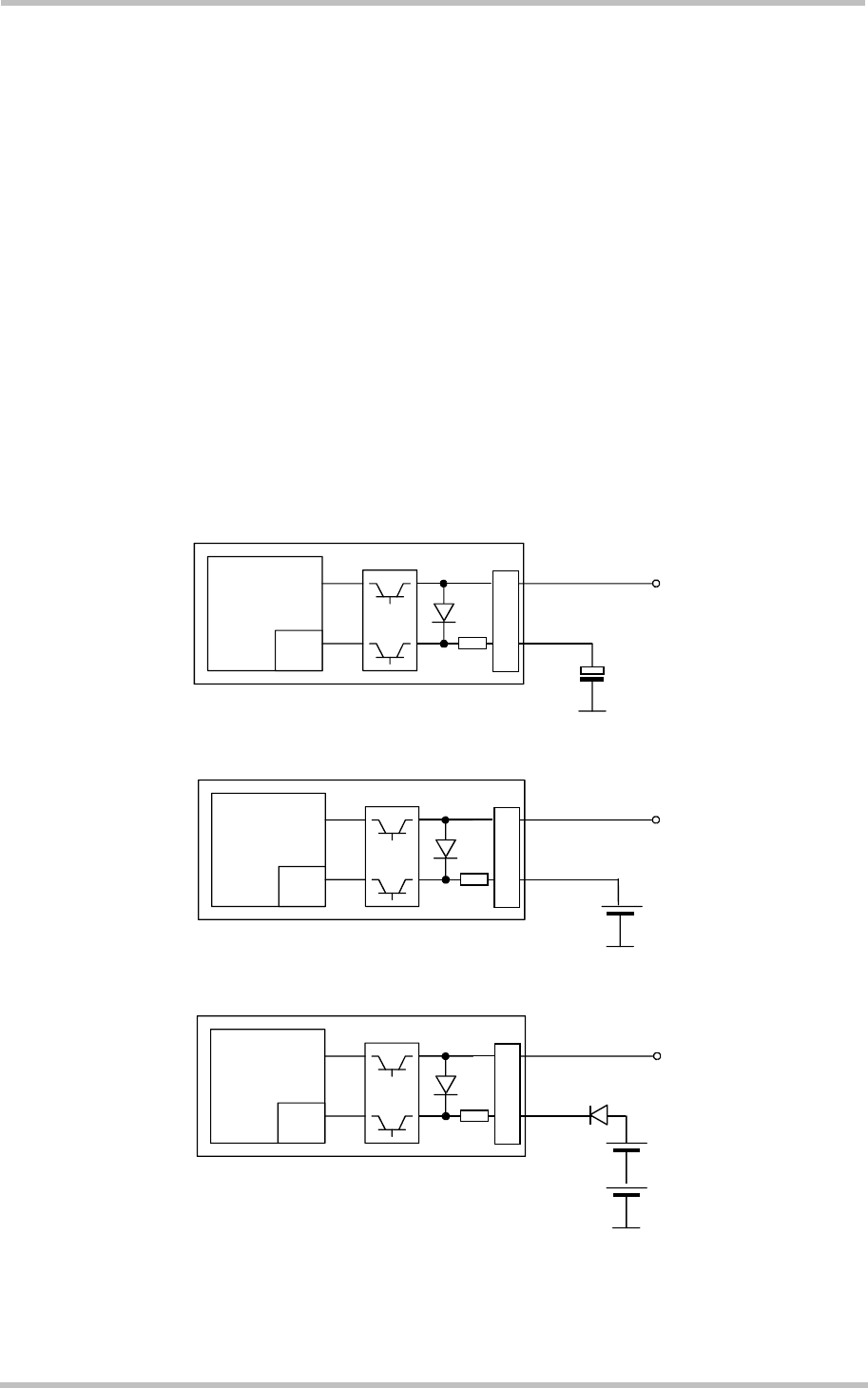
AC65/AC75 Hardware Interface Description
Confidential / Preliminary s
AC65/AC75_hd_v00.372 Page 52 of 118 2006-08-03
3.8 RTC Backup
The internal Real Time Clock of AC65/AC75 is supplied from a separate voltage regulator in
the analog controller which is also active when AC65/AC75 is in POWER DOWN status. An
alarm function is provided to wake up AC65/AC75 to Airplane mode without logging on to the
GSM network.
In addition, you can use the VDDLP pin on the board-to-board connector to backup the RTC
from an external capacitor or a battery (rechargeable or non-chargeable). The capacitor is
charged by the BATT+ line of AC65/AC75. If the voltage supply at BATT+ is disconnected
the RTC can be powered by the capacitor. The size of the capacitor determines the duration
of buffering when no voltage is applied to AC65/AC75, i.e. the larger the capacitor the longer
AC65/AC75 will save the date and time.
A serial 1k resistor placed on the board next to VDDLP limits the charge current of an
empty capacitor or battery.
The following figures show various sample configurations. Please refer to Table 26 for the
parameters required.
Baseband
processor
RTC
PSU
+
BATT+
1k
B2B
VDDLP
Figure 13: RTC supply from capacitor
RTC
+
BATT+
1k
B2B
VDDLP
Baseband
processor PSU
Figure 14: RTC supply from rechargeable battery
RTC
+
+
BATT+
1k
VDDLP
B2B
Baseband
processor
PSU
Figure 15: RTC supply from non-chargeable battery

AC65/AC75 Hardware Interface Description
Confidential / Preliminary s
AC65/AC75_hd_v00.372 Page 53 of 118 2006-08-03
3.9 SIM Interface
The baseband processor has an integrated SIM interface compatible with the ISO 7816 IC
Card standard. This is wired to the host interface (board-to-board connector) in order to be
connected to an external SIM card holder. Six pins on the board-to-board connector are
reserved for the SIM interface.
The SIM interface supports 3V and 1.8V SIM cards. Please refer to Table 26 for electrical
specifications of the SIM interface lines depending on whether a 3V or 1.8V SIM card is
used.
The CCIN pin serves to detect whether a tray (with SIM card) is present in the card holder.
Using the CCIN pin is mandatory for compliance with the GSM 11.11 recommendation if the
mechanical design of the host application allows the user to remove the SIM card during
operation. To take advantage of this feature, an appropriate SIM card detect switch is
required on the card holder. For example, this is true for the model supplied by Molex, which
has been tested to operate with AC65/AC75 and is part of the Siemens reference equipment
submitted for type approval. See Chapter 8 for Molex ordering numbers.
Table 12: Signals of the SIM interface (board-to-board connector)
Signal Description
CCGND Separate ground connection for SIM card to improve EMC.
Be sure to use this ground line for the SIM interface rather than any other ground pin or
plane on the module. A design example for grounding the SIM interface is shown in
Figure 46.
CCCLK Chipcard clock, various clock rates can be set in the baseband processor.
CCVCC SIM supply voltage.
CCIO Serial data line, input and output.
CCRST Chipcard reset, provided by baseband processor.
CCIN Input on the baseband processor for detecting a SIM card tray in the holder. If the SIM is
removed during operation the SIM interface is shut down immediately to prevent
destruction of the SIM. The CCIN pin is active low.
The CCIN pin is mandatory for applications that allow the user to remove the SIM card
during operation.
The CCIN pin is solely intended for use with a SIM card. It must not be used for any other
purposes. Failure to comply with this requirement may invalidate the type approval of
AC65/AC75.
Note: No guarantee can be given, nor any liability accepted, if loss of data is encountered
after removing the SIM card during operation.
Also, no guarantee can be given for properly initializing any SIM card that the user
inserts after having removed a SIM card during operation.

AC65/AC75 Hardware Interface Description
Confidential / Preliminary s
AC65/AC75_hd_v00.372 Page 54 of 118 2006-08-03
3.9.1 Installation Advice
The total cable length between the board-to-board connector pins on AC65/AC75 and the
pins of the external SIM card holder must not exceed 100mm in order to meet the
specifications of 3GPP TS 51.010-1 and to satisfy the requirements of EMC compliance.
To avoid possible cross-talk from the CCCLK signal to the CCIO signal be careful that both
lines are not placed closely next to each other. A useful approach is using the CCGND line to
shield the CCIO line from the CCCLK line.
To meet EMC requirements it is strongly recommended to add several capacitors as shown
in Figure 46. Take care to place the capacitors close to the SIM card holder.
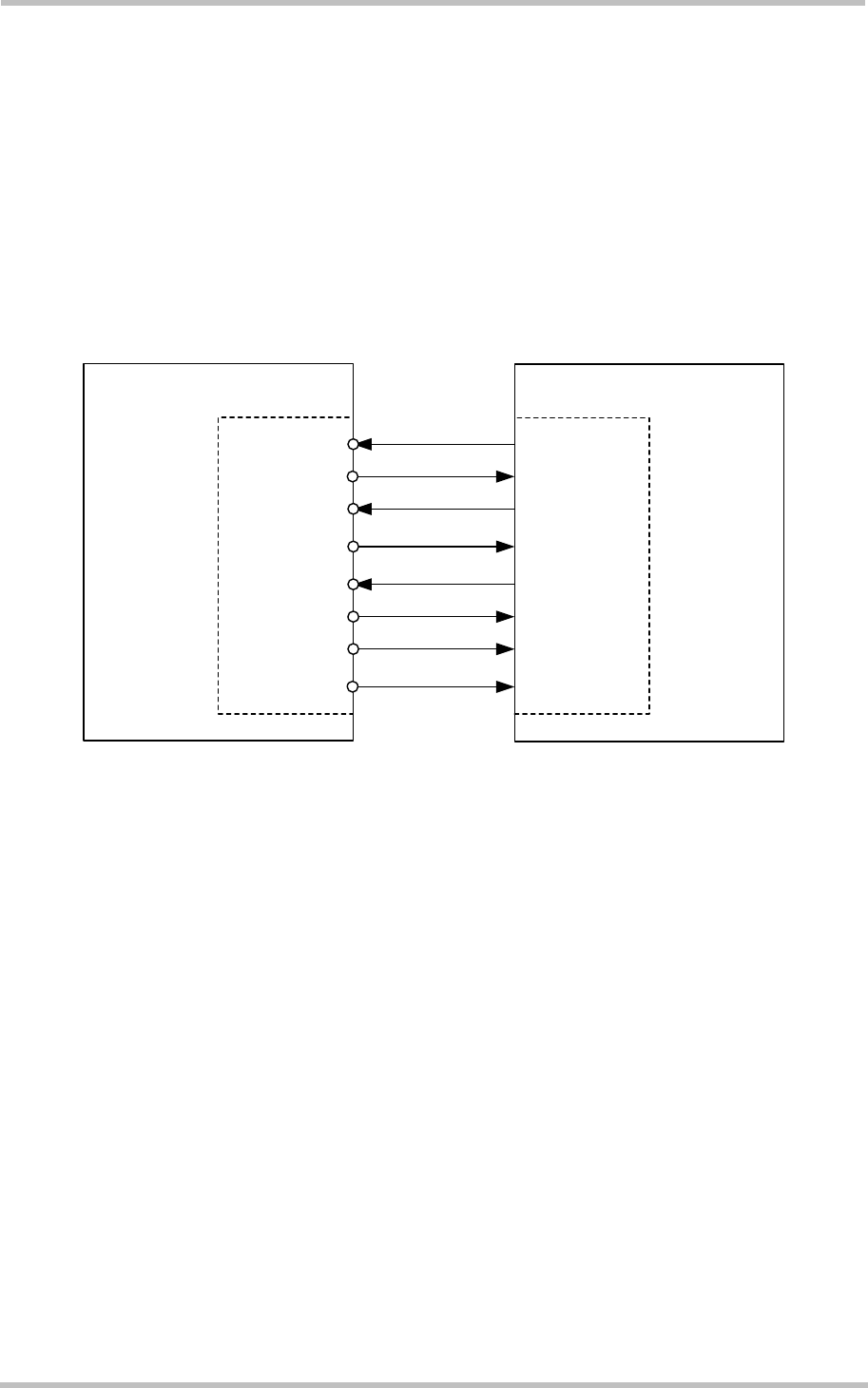
AC65/AC75 Hardware Interface Description
Confidential / Preliminary s
AC65/AC75_hd_v00.372 Page 55 of 118 2006-08-03
3.10 Serial Interface ASC0
AC65/AC75 offers an 8-wire unbalanced, asynchronous modem interface ASC0 conforming
to ITU-T V.24 protocol DCE signalling. The electrical characteristics do not comply with ITU-
T V.28. The significant levels are 0V (for low data bit or active state) and 2.9V (for high data
bit or inactive state). For electrical characteristics please refer to Table 26.
AC65/AC75 is designed for use as a DCE. Based on the conventions for DCE-DTE
connections it communicates with the customer application (DTE) using the following signals:
• Port TXD @ application sends data to the module’s TXD0 signal line
• Port RXD @ application receives data from the module’s RXD0 signal line
Figure 16: Serial interface ASC0
Features
• Includes the data lines TXD0 and RXD0, the status lines RTS0 and CTS0 and, in
addition, the modem control lines DTR0, DSR0, DCD0 and RING0.
• ASC0 is primarily designed for controlling voice calls, transferring CSD, fax and GPRS
data and for controlling the GSM engine with AT commands.
• Full Multiplex capability allows the interface to be partitioned into three virtual channels,
yet with CSD and fax services only available on the first logical channel. Please note that
when the ASC0 interface runs in Multiplex mode, ASC1 cannot be used. For more details
on Multiplex mode see [10].
• The DTR0 signal will only be polled once per second from the internal firmware of
AC65/AC75.
• The RING0 signal serves to indicate incoming calls and other types of URCs (Unsolicited
Result Code). It can also be used to send pulses to the host application, for example to
wake up the application from power saving state. See [1] for details on how to configure
the RING0 line by AT^SCFG.
• By default, configured for 8 data bits, no parity and 1 stop bit. The setting can be
changed using the AT command AT+ICF and, if required, AT^STPB. For details see [1].
• ASC0 can be operated at fixed bit rates from 300 bps to 460,800 bps.
• Autobauding supports bit rates from 1,200 to 460,800 bps.
• Autobauding is not compatible with multiplex mode.
• Supports RTS0/CTS0 hardware flow control and XON/XOFF software flow control.
TXD0
RXD0
RTS0
DCD0
CTS0
DTR0
DSR0
RING0
TXD
RXD
RTS
DCD
CTS
DTR
DSR
RING
GSM Module (DCE) Application (DTE)

AC65/AC75 Hardware Interface Description
Confidential / Preliminary s
AC65/AC75_hd_v00.372 Page 56 of 118 2006-08-03
Table 13: DCE-DTE wiring of ASC0
DCE DTE V.24
circuit Pin function Signal direction Pin function Signal direction
103 TXD0 Input TXD Output
104 RXD0 Output RXD Input
105 RTS0 Input RTS Output
106 CTS0 Output CTS Input
108/2 DTR0 Input DTR Output
107 DSR0 Output DSR Input
109 DCD0 Output DCD Input
125 RING0 Output RING Input
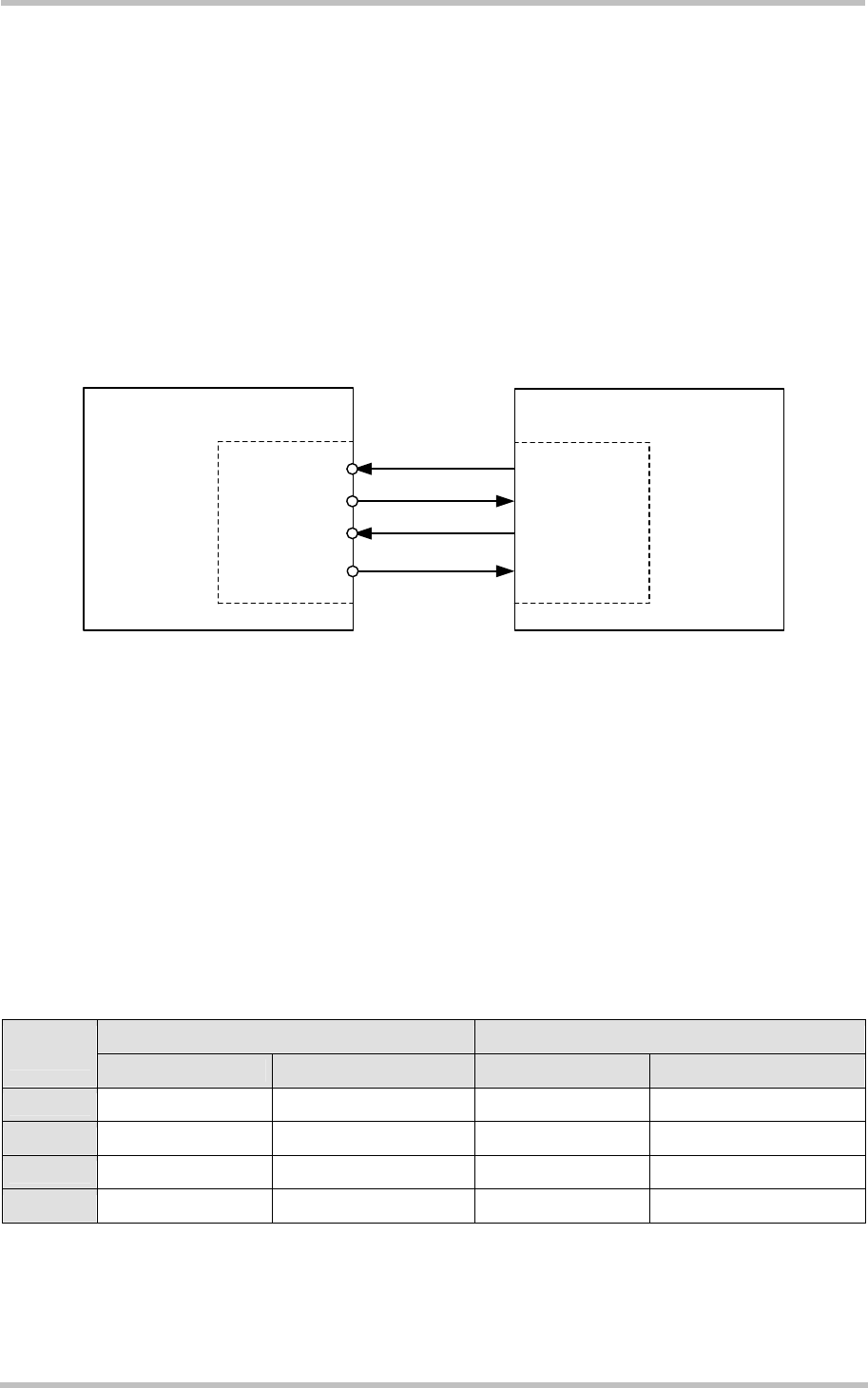
AC65/AC75 Hardware Interface Description
Confidential / Preliminary s
AC65/AC75_hd_v00.372 Page 57 of 118 2006-08-03
3.11 Serial Interface ASC1
The ASC1 interface is available as a 4-wire unbalanced, asynchronous modem interface
ASC1 conforming to ITU-T V.24 protocol DCE signalling. The electrical characteristics do not
comply with ITU-T V.28. The significant levels are 0V (for low data bit or active state) and
2.9V (for high data bit or inactive state). For electrical characteristics please refer to Table
26.
AC65/AC75 is designed for use as a DCE. Based on the conventions for DCE-DTE
connections it communicates with the customer application (DTE) using the following signals:
• Port TXD @ application sends data to module’s TXD1 signal line
• Port RXD @ application receives data from the module’s RXD1 signal line
Figure 17: Serial interface ASC1
Features
• Includes only the data lines TXD1 and RXD1 plus RTS1 and CTS1 for hardware
handshake.
• On ASC1 no RING line is available. The indication of URCs on the second interface
depends on the settings made with the AT^SCFG command. For details refer to [1].
• Configured for 8 data bits, no parity and 1 or 2 stop bits.
• ASC1 can be operated at fixed bit rates from 300 bps to 460,800 bps. Autobauding is not
supported on ASC1.
• Supports RTS1/CTS1 hardware flow control and XON/XOFF software flow control.
Table 14: DCE-DTE wiring of ASC1
DCE DTE V.24
circuit Pin function Signal direction Pin function Signal direction
103 TXD1 Input TXD Output
104 RXD1 Output RXD Input
105 RTS1 Input RTS Output
106 CTS1 Output CTS Input
TXD1
RXD1
RTS1
CTS1
TXD
RXD
RTS
CTS
GSM Module (DCE) Application (DTE)
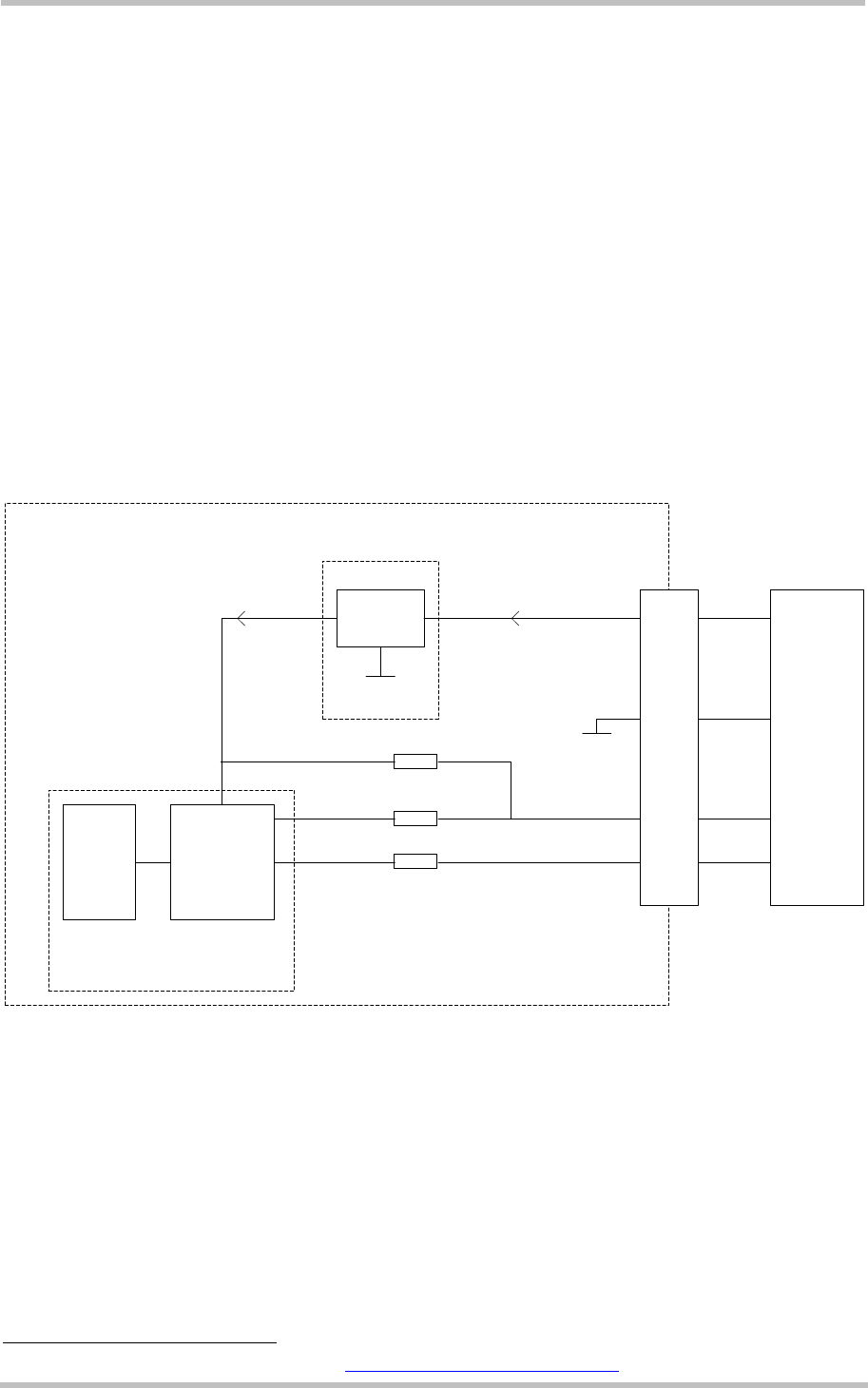
AC65/AC75 Hardware Interface Description
Confidential / Preliminary s
AC65/AC75_hd_v00.372 Page 58 of 118 2006-08-03
3.12 USB Interface
AC65/AC75 supports a USB 2.0 Full Speed (12Mbit/s) device interface. It can be operated
on a USB 2.0 Full Speed or High Speed root hub (a PC host), but not on a generic USB 2.0
High Speed hub which translates High Speed (480 Mbit/s/) to Full Speed (12 Mbit/s).
The USB port has different functions depending on whether or not Java is running. Under
Java, the lines may be used for debugging purposes (see [16] for further detail). If Java is not
used, the USB interface is available as a command and data interface and for downloading
firmware.
The USB I/O-pins are capable of driving the signal at min 3.0V. They are 5V I/O compliant.
The USB host is responsible for supplying, across the VUSB_IN line, power to the module’s
USB interface, but not to other AC65/AC75 interfaces. This is because AC65/AC75 is
designed as a self-powered device compliant with the “Universal Serial Bus Specification
Revision 2.0”2.
MCU USB
Transceiver
lin.
Regulator
PSU
Baseband controller GSM module
Host
22Ohms
22Ohms
1.5kOhms
USB_DP
USB_DN
VUSB_IN
5V3.2V
D+
D-
VBUS
GND
80 pole board-to-board connector
Figure 18: USB circuit
To properly connect the module’s USB interface to the host a USB 2.0 compatible connector
is required. For more information on how to install a USB modem driver and on how to
integrate USB into AC65/AC75 applications see [11].
2 The specification is ready for download on http://www.usb.org/developers/docs/
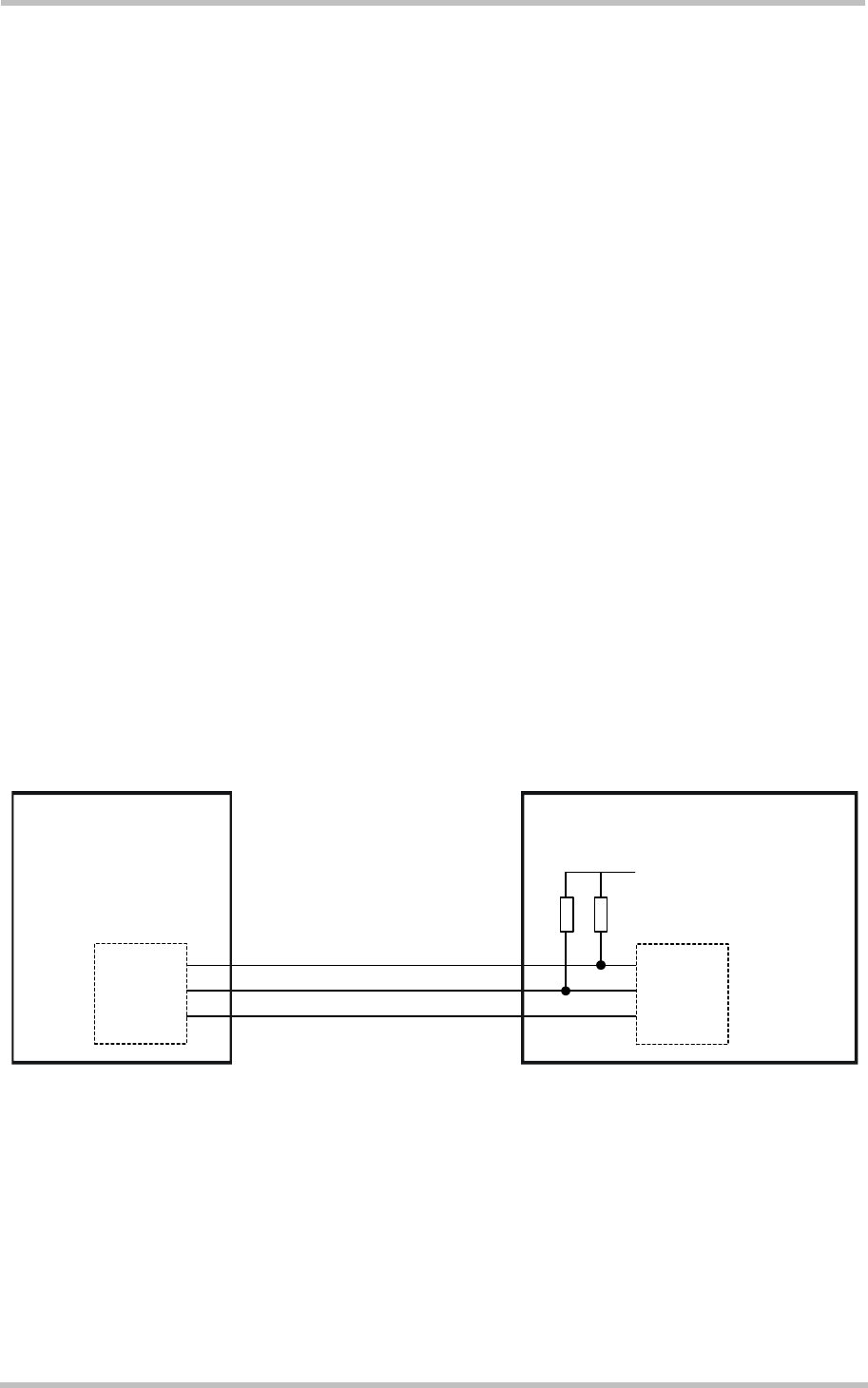
AC65/AC75 Hardware Interface Description
Confidential / Preliminary s
AC65/AC75_hd_v00.372 Page 59 of 118 2006-08-03
3.13 I2C Interface
I2C is a serial, 8-bit oriented data transfer bus for bit rates up to 400kbps in Fast mode. It
consists of two lines, the serial data line I2CDAT and the serial clock line I2CCLK.
The AC65/AC75 module acts as a single master device, e.g. the clock I2CCLK is driven by
module. I2CDAT is a bi-directional line.
Each device connected to the bus is software addressable by a unique 7-bit address, and
simple master/slave relationships exist at all times. The module operates as master-
transmitter or as master-receiver. The customer application transmits or receives data only
on request of the module.
To configure and activate the I2C bus use the AT^SSPI command. If the I2C bus is active the
two lines I2CCLK and I2DAT are locked for use as SPI lines. Vice versa, the activation of the
SPI locks both lines for I2C. Detailed information on the AT^SSPI command as well
explanations on the protocol and syntax required for data transmission can be found in [1].
The I2C interface can be powered from an external supply or via the VEXT line of
AC65/AC75. If connected to the VEXT line the I2C interface will be properly shut down when
the module enters the Power-down mode. If you prefer to connect the I2C interface to an
external power supply, take care that VCC of the application is in the range of VVEXT and that
the interface is shut down when the PWR_IND signal goes high. See figures below as well
as Section 7 and Figure 46.
In the application I2CDAT and I2CCLK lines need to be connected to a positive supply
voltage via a pull-up resistor.
For electrical characteristics please refer to Table 26.
GSM module
I2CDAT
I2CCLK
GND
I2CDAT
I2CCLK
GND
Application
VCC
R
p
R
p
wVEXT
Figure 19: I2C interface connected to VCC of application
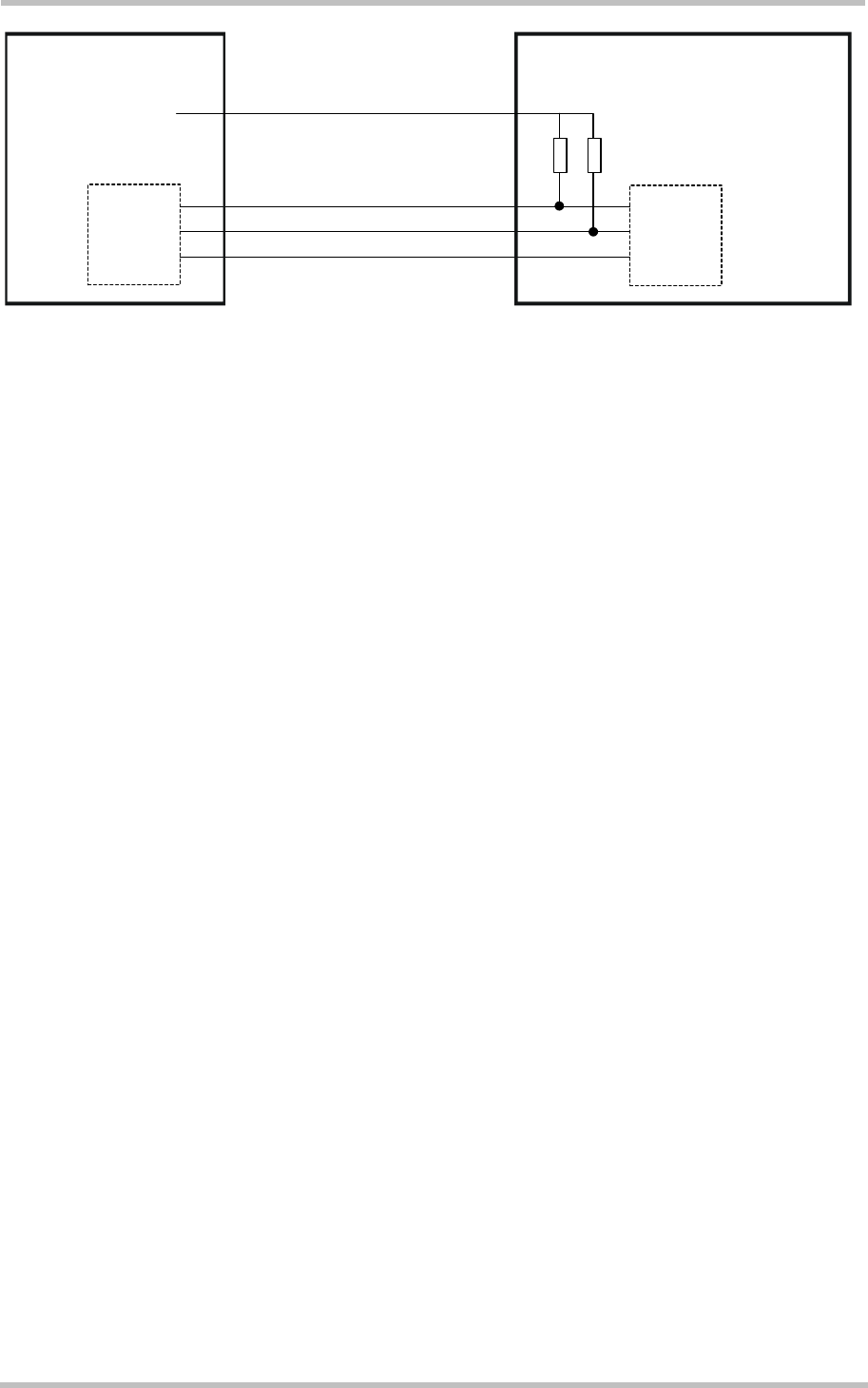
AC65/AC75 Hardware Interface Description
Confidential / Preliminary s
AC65/AC75_hd_v00.372 Page 60 of 118 2006-08-03
GSM module
I2CDAT
I2CCLK
GND
I2CDAT
I2CCLK
GND
Application
VEXT
R
p
R
p
Figure 20: I2C interface connected to VEXT line of AC65/AC75
Note: Good care should be taken when creating the PCB layout of the host application: The
traces of I2CCLK and I2CDAT should be equal in length and as short as possible.
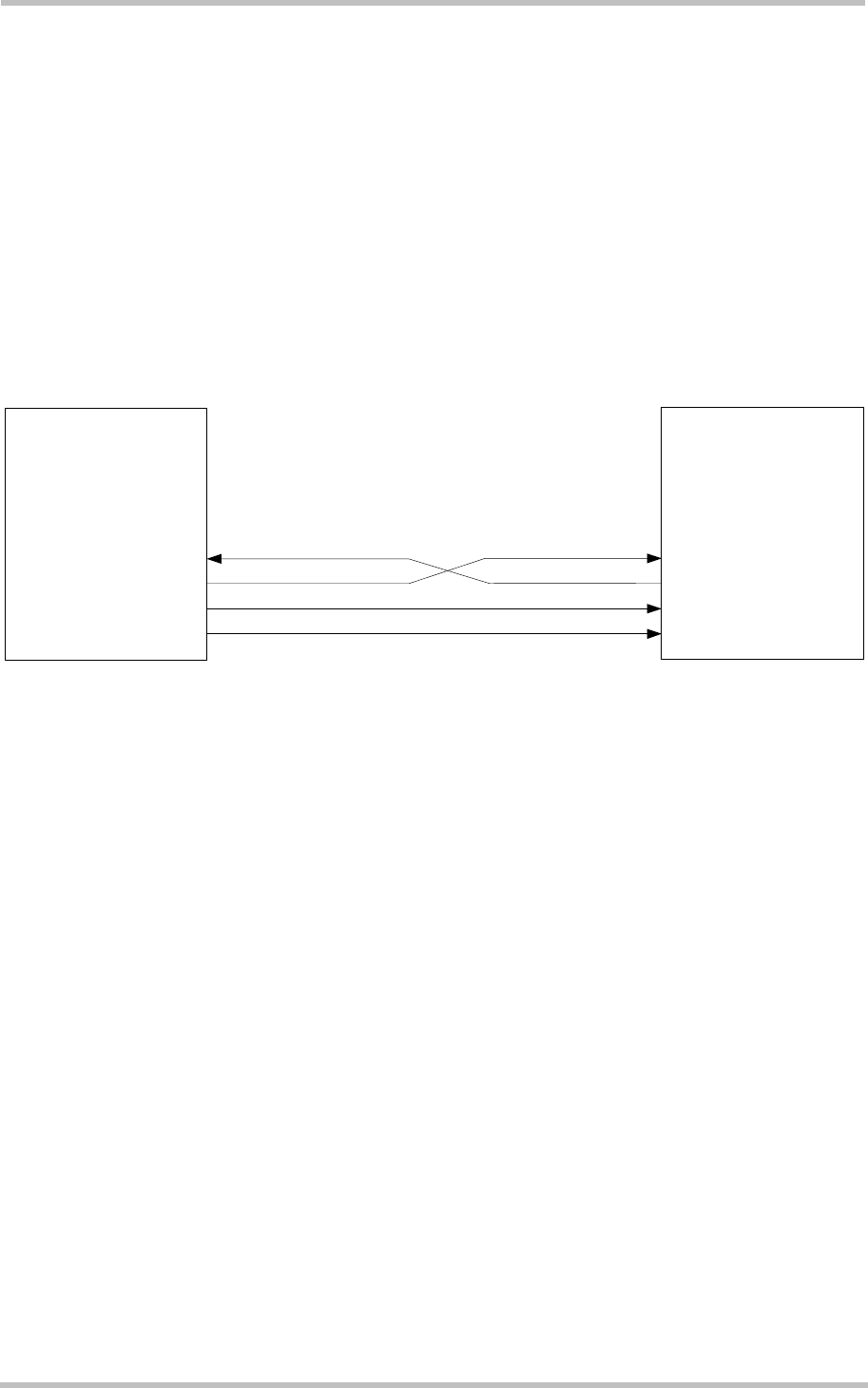
AC65/AC75 Hardware Interface Description
Confidential / Preliminary s
AC65/AC75_hd_v00.372 Page 61 of 118 2006-08-03
3.14 SPI Interface
The SPI (serial peripheral interface) is a synchronous serial interface for control and data
transfer between the AC65/AC75 module and the connected application. Only one
application can be connected to the module’s SPI. The interface supports transmission rates
up to 6.5Mbit/s. It consists of four lines, the two data lines SPIDI/SPIDO, the clock line
SPICLK and the chip select line SPICS.
The AC65/AC75 module acts as a single master device, e.g. the clock SPICLK is driven by
module. Whenever the SPICS pin is in a low state, the SPI bus is activated and data can be
transferred from the module and vice versa. The SPI interface uses two independent lines for
data input (SPIDI) and data output (SPIDO).
GSM module Application
SPICLK SPICLK
SPICS SPICS
SPIDO
SPIDI SPIDI
SPIDO
Figure 21: SPI interface
To configure and activate the SPI bus use the AT^SSPI command. If the SPI bus is active
the two lines I2CCLK and I2DAT are locked for use as I2C lines. Detailed information on the
AT^SSPI command as well explanations on the SPI modes required for data transmission
can be found in [1].
In general, SPI supports four operation modes. The modes are different in clock phase and
clock polarity. The module’s SPI mode can be configured by using the AT command
AT^SSPI. Make sure the module and the connected slave device works with the same SPI
mode.
Figure 22 shows the characteristics of the four SPI modes. The SPI modes 0 and 3 are the
most common used modes.
For electrical characteristics please refer to Table 26.
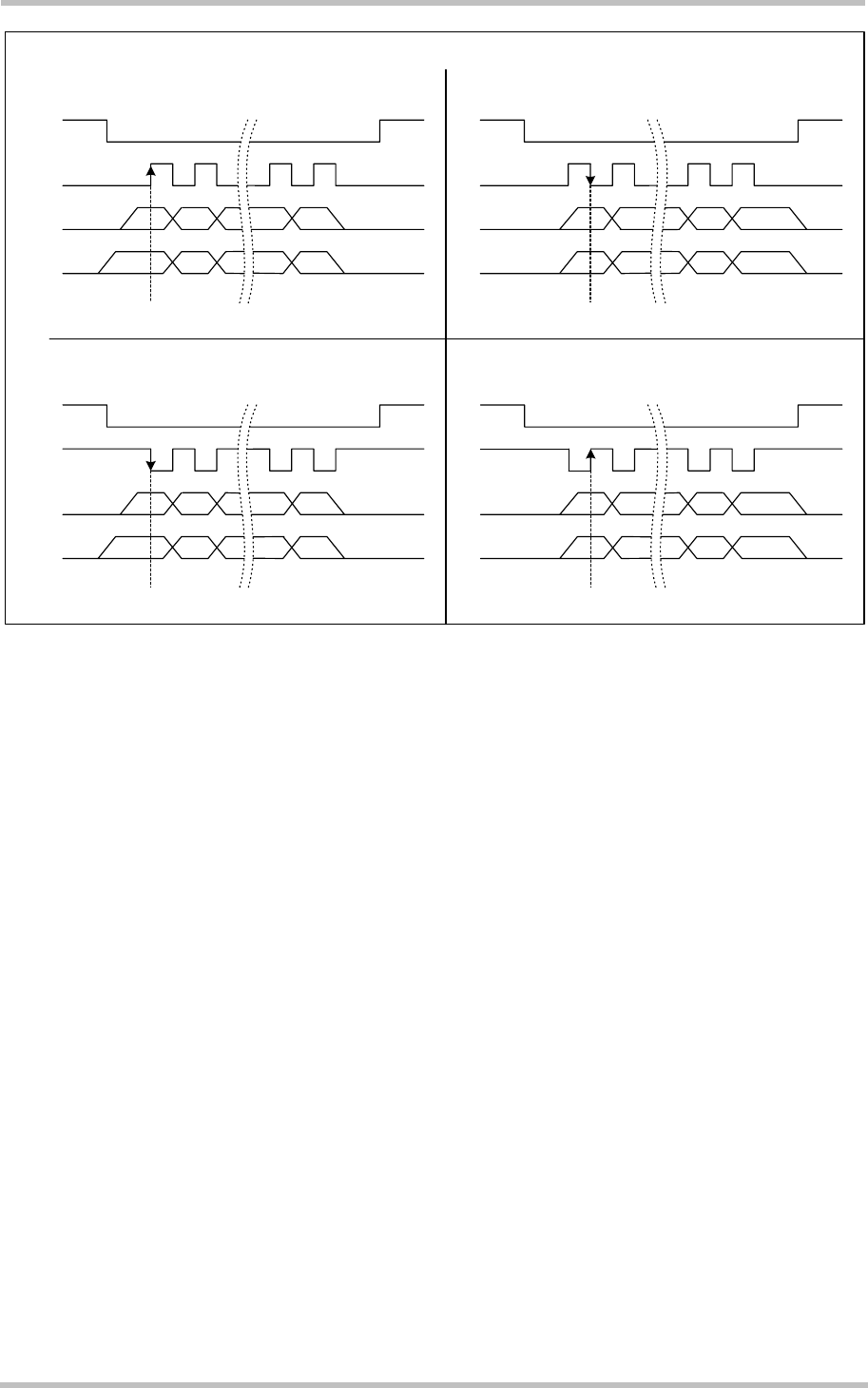
AC65/AC75 Hardware Interface Description
Confidential / Preliminary s
AC65/AC75_hd_v00.372 Page 62 of 118 2006-08-03
SPI MODE 0 SPI MODE 1
SPI MODE 2 SPI MODE 3
Clock phase
Clock polarity
SPICS
SPIDO
SPICLK
SPIDI
SPICS
SPIDO
SPICLK
SPIDI
SPICS
SPIDO
SPICLK
SPIDI
SPICS
SPIDO
SPICLK
SPIDI
Sample Sample
Sample Sample
Figure 22: Characteristics of SPI modes
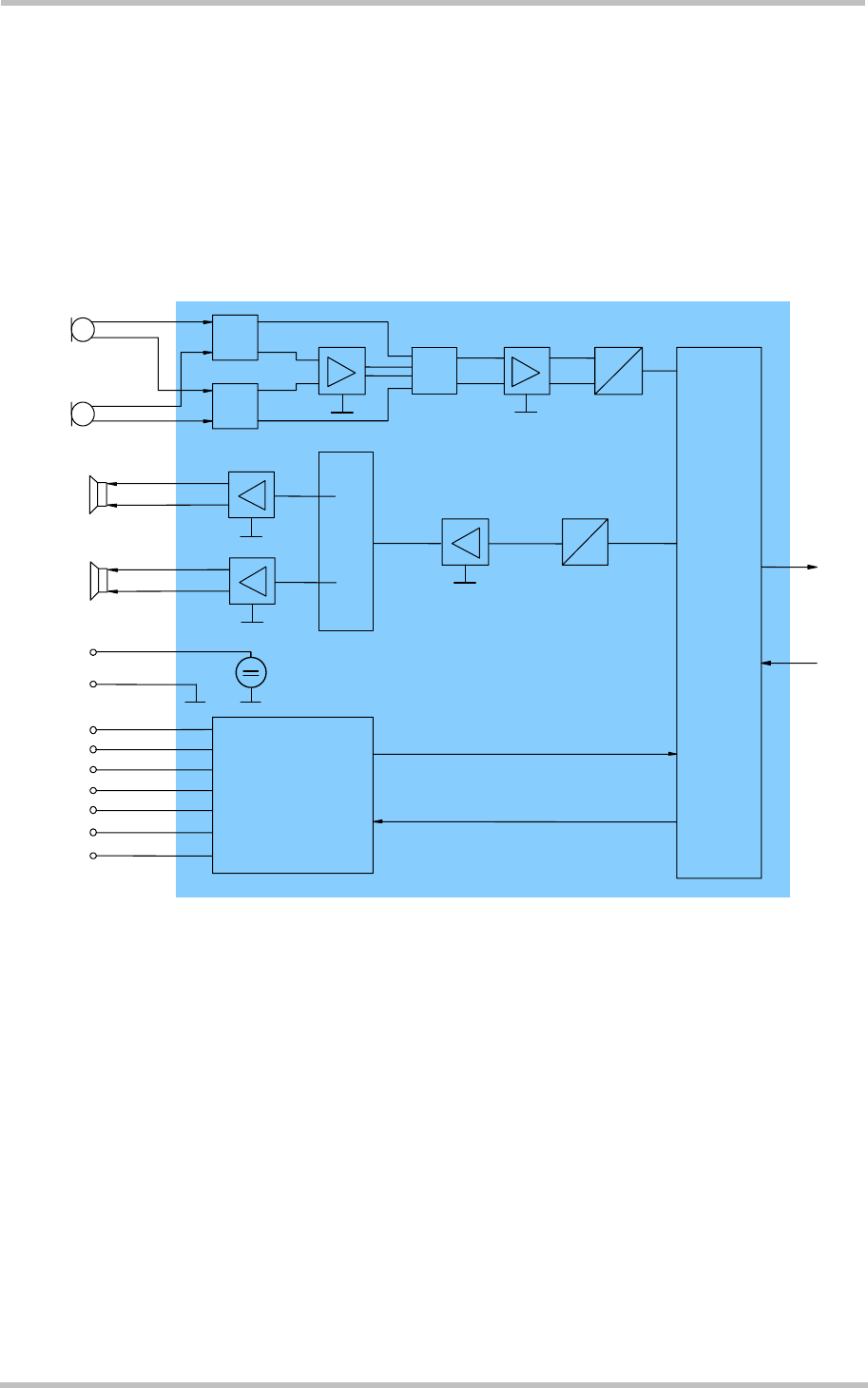
AC65/AC75 Hardware Interface Description
Confidential / Preliminary s
AC65/AC75_hd_v00.372 Page 63 of 118 2006-08-03
3.15 Audio Interfaces
AC65/AC75 comprises three audio interfaces available on the board-to-board connector:
• Two analog audio interfaces, both with balanced or single-ended inputs/outputs.
• Serial digital audio interface (DAI) designed for PCM (Pulse Code Modulation).
This means you can connect up to three different audio devices, although only one interface
can be operated at a time. Using the AT^SAIC command you can easily switch back and
forth.
Analog switch
Digital
Audio
Interface
Air
Interface
DSP
MUX
MU
X
D
A
MICN2
MICP2
MICN1
MICP1
DAI6
DAI5
DAI4
DAI3
DAI2
AGND
DAI0
DAI1
D
A
EPP2
EPN2
EPP1
EPN1
VMIC
MUX
Figure 23: Audio block diagram
To suit different types of accessories the audio interfaces can be configured for different
audio modes via the AT^SNFS command. The electrical characteristics of the voiceband part
vary with the audio mode. For example, sending and receiving amplification, sidetone paths,
noise suppression etc. depend on the selected mode and can be altered with AT commands
(except for mode 1).
Both analog audio interfaces can be used to connect headsets with microphones or
speakerphones. Headsets can be operated in audio mode 3, speakerphones in audio
mode 2. Audio mode 5 can be used for direct access to the speech coder without signal pre
or post processing.
When shipped from factory, all audio parameters of AC65/AC75 are set to interface 1 and
audio mode 1. This is the default configuration optimized for the Votronic HH-SI-30.3/V1.1/0
handset and used for type approving the Siemens reference configuration. Audio mode 1 has
fix parameters which cannot be modified. To adjust the settings of the Votronic handset
simply change to another audio mode.

AC65/AC75 Hardware Interface Description
Confidential / Preliminary s
AC65/AC75_hd_v00.372 Page 64 of 118 2006-08-03
3.15.1 Speech Processing
The speech samples from the ADC or DAI are handled by the DSP of the baseband
controller to calculate e.g. amplifications, sidetone, echo cancellation or noise suppression
depending on the configuration of the active audio mode. These processed samples are
passed to the speech encoder. Received samples from the speech decoder are passed to
the DAC or DAI after post processing (frequency response correction, adding sidetone etc.).
Full rate, half rate, enhanced full rate, adaptive multi rate (AMR), speech and channel
encoding including voice activity detection (VAD) and discontinuous transmission (DTX) and
digital GMSK modulation are also performed on the GSM baseband processor.
3.15.2 Microphone Circuit
AC65/AC75 has two identical analog microphone inputs. There is no on-board microphone
supply circuit, except for the internal voltage supply VMIC and the dedicated audio ground
line AGND. Both lines are well suited to feed a balanced audio application or a single-ended
audio application.
The AGND line on the AC65/AC75 board is especially provided to achieve best grounding
conditions for your audio application. As there is less current flowing than through other GND
lines of the module or the application, this solution will avoid hum and buzz problems.
While AC65/AC75 is in Power-down mode, the input voltage at any MIC pin must not exceed
±0.3V relative to AGND (see also Chapter 5.1). In any other operating state the voltage
applied to any MIC pin must be in the range of +2.7V to -0.3V, otherwise undervoltage
shutdown may be caused.
If VMIC is used to generate the MICP-pin bias voltage as shown in the following examples
consider that VMIC is switched off (0V) outside a call. Audio signals applied to MICP in this
case must not fall below -0.3V.
If higher input levels are used especially in the line input configuration the signal level must
be limited to 600mVpp outside a call, or AT^SNFM=,1 should be used to switch on VMIC
permanently.
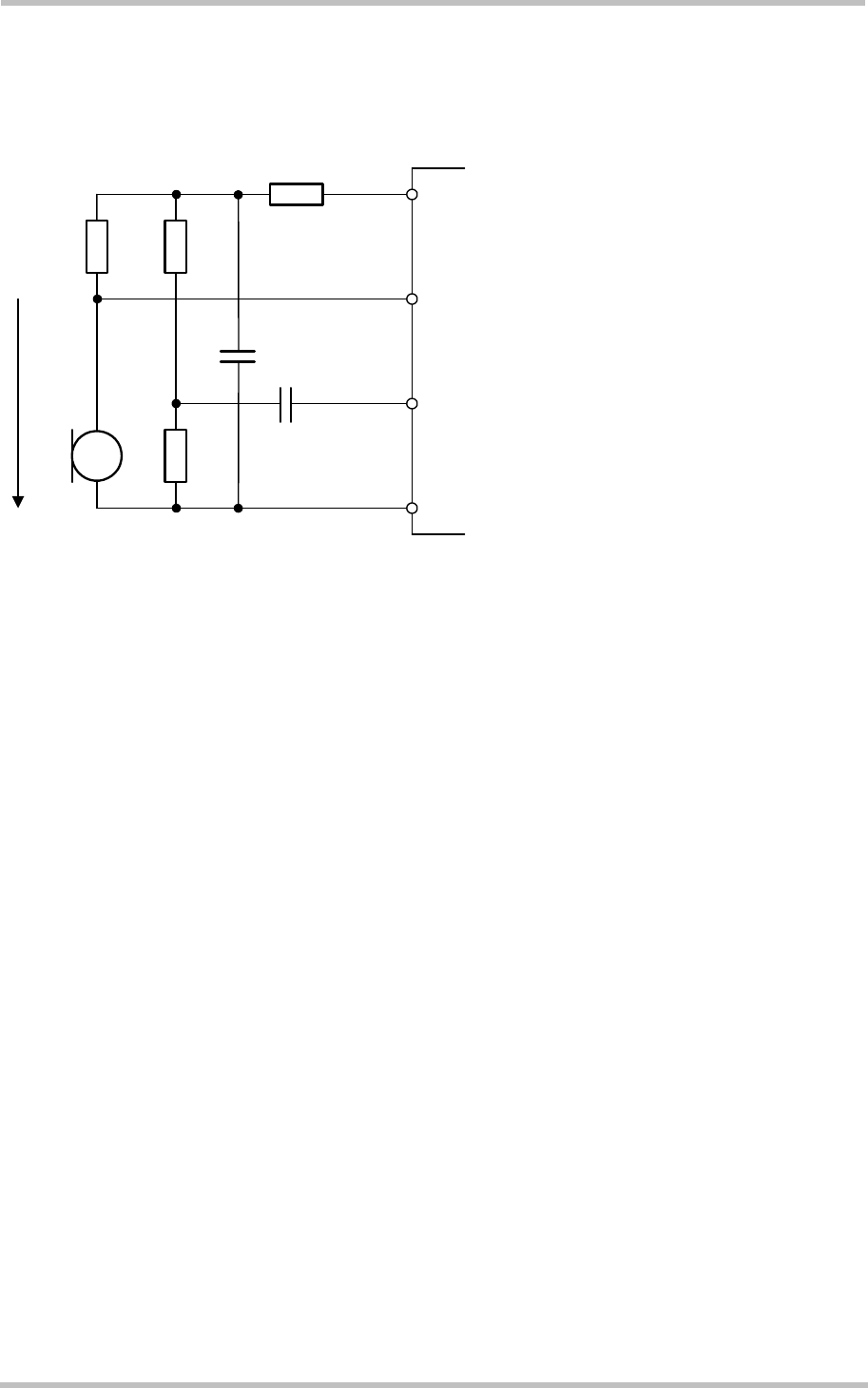
AC65/AC75 Hardware Interface Description
Confidential / Preliminary s
AC65/AC75_hd_v00.372 Page 65 of 118 2006-08-03
3.15.2.1 Single-ended Microphone Input
Figure 24 as well as Figure 46 show an example of how to integrate a single-ended
microphone input.
GSM module
R
B
V
Bias
C
K
AGND
MICNx
MICPx
VMIC
R
A
R
A
C
F
R
VMIC
RA = typ. 2k
RB = typ. 5k
RVMIC = typ. 470Ohm
Ck = typ. 100nF
CF = typ. 22µF
VMIC = typ. 2.5V
Vbias = 1.0V … 1.6V, typ. 1.5V
Figure 24: Single ended microphone input
RA has to be chosen so that the DC voltage across the microphone falls into the bias voltage
range of 1.0V to 1.6V and the microphone feeding current meets its specification.
The MICNx input is automatically self biased to the MICPx DC level. It is AC coupled via CK
to a resistive divider which is used to optimize supply noise cancellation by the differential
microphone amplifier in the module.
The VMIC voltage should be filtered if gains larger than 20dB are used. The filter can be
attached as a simple first order RC-network (RVMIC and CF).
This circuit is well suited if the distance between microphone and module is kept short. Due
to good grounding the microphone can be easily ESD protected as its housing usually
connects to the negative terminal.
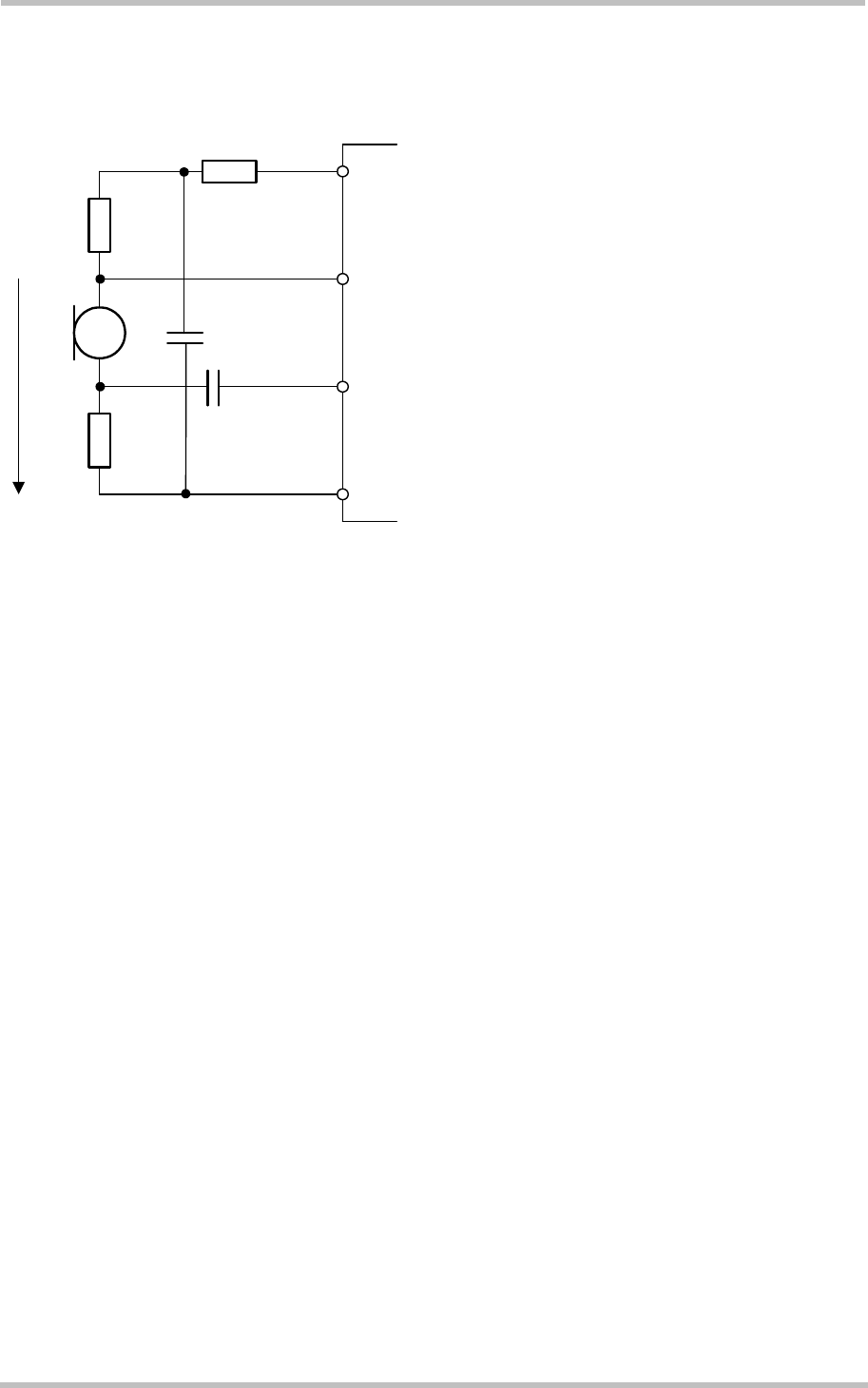
AC65/AC75 Hardware Interface Description
Confidential / Preliminary s
AC65/AC75_hd_v00.372 Page 66 of 118 2006-08-03
3.15.2.2 Differential Microphone Input
Figure 25 shows a differential solution for connecting an electret microphone.
GSM module
RA
RA
VBias CK
AGND
MICNx
MICPx
VMIC
CF
RVMIC
RA = typ. 1k
RVMIC = 470Ohm
CK = typ. 100nF
CF = typ. 22µF
VMIC = typ. 2.5V
Vbias = 1.0V … 1.6V, typ. 1.5V
Figure 25: Differential microphone input
The advantage of this circuit is that it can be used if the application involves longer lines
between microphone and module.
While VMIC is switched off, the input voltage at any MIC pin should not exceed ±0.25V
relative to AGND (see also Chapter 5.1). In this case no bias voltage has to be supplied from
the customer circuit to the MIC pin and any signal voltage should be smaller than Vpp = 0.5V.
VMIC can be used to generate the MICP-pin bias voltage as shown below. In this case the
bias voltage is only applied if VMIC is switched on.
Only if VMIC is switched on, can the voltage applied to any MIC pin be in the range of 2.4V
to 0V. If these limits are exceeded undervoltage shutdown may be caused.
Consider that the maximum full scale input voltage is Vpp = 1.6V.
The behavior of VMIC can be controlled with the parameter micVccCtl of the AT command
AT^SNFM (see [1]):
• micVccCtl=2 (default). VMIC is controlled automatically by the module. VMIC is always
switched on while the internal audio circuits of the module are active (e.g., during a call).
VMIC can be used as indicator for active audio in the module.
• micVccCtl=1. VMIC is switched on continuously. This setting can be used to supply the
microphone in order to use the signal in other customer circuits as well. However, this
setting leads to a higher current consumption in SLEEP modes.
• micVccCtl=0. VMIC is permanently switched off.
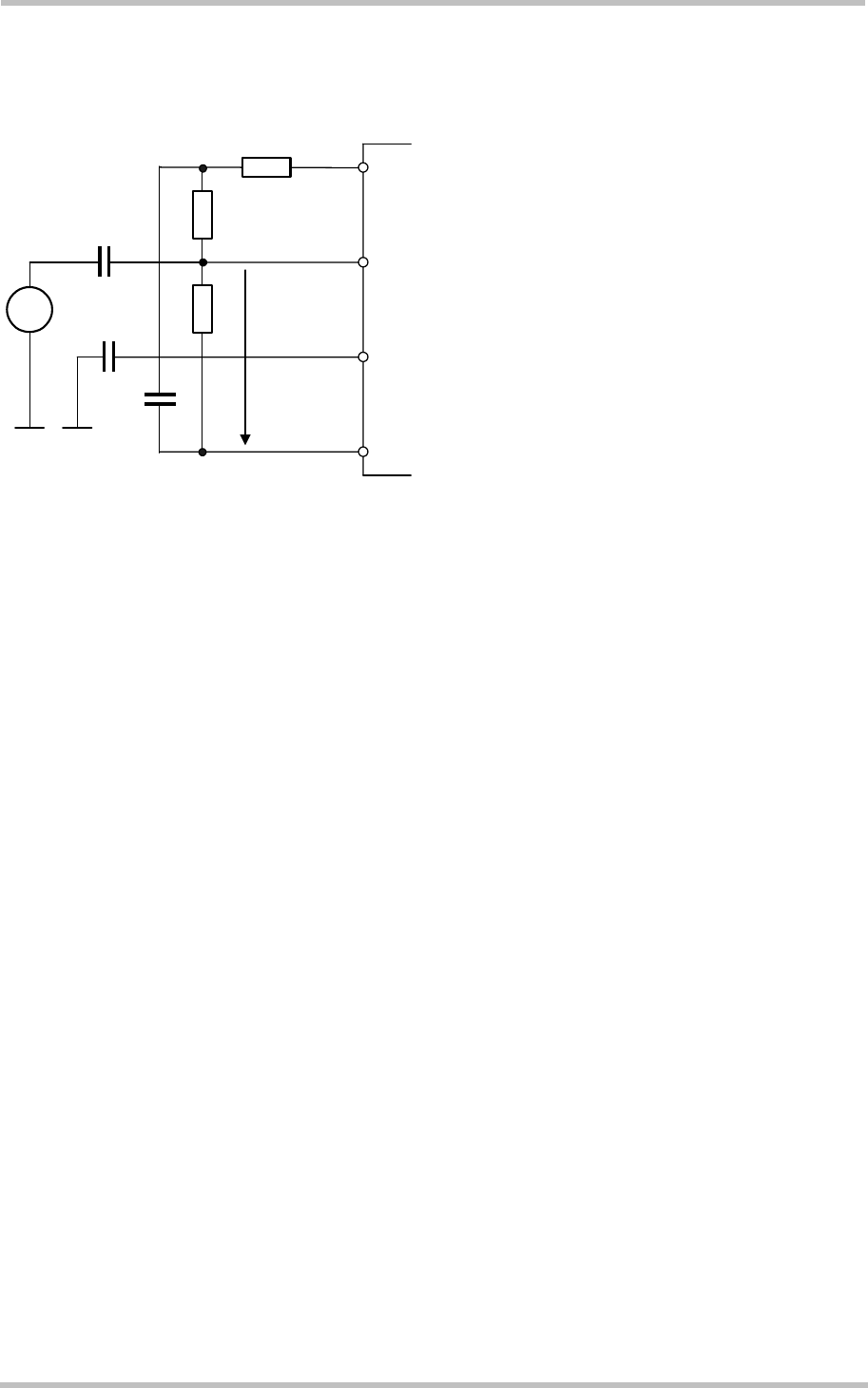
AC65/AC75 Hardware Interface Description
Confidential / Preliminary s
AC65/AC75_hd_v00.372 Page 67 of 118 2006-08-03
3.15.2.3 Line Input Configuration with OpAmp
Figure 26 shows an example of how to connect an opamp into the microphone circuit.
GSM module
R
A
V
Bias
C
K
AGND
MICNx
MICPx
VMIC
R
A
C
K
~
R
VMIC
C
F
RA = typ. 47k
RVMIC = 470Ohm
Ck = typ. 100nF
CF = typ. 22µF
VMIC = typ. 2.5V
Vbias = typ. ½ VMIC = 1.25V
Figure 26: Line input configuration with OpAmp
The AC source (e.g. an opamp) and its reference potential have to be AC coupled to the
MICPx resp. MICNx input terminals. The voltage divider between VMIC and AGND is
necessary to bias the input amplifier. MICNx is automatically self biased to the MICPx DC
level.
The VMIC voltage should be filtered if gains larger than 20dB are used. The filter can be
attached as a simple first order RC-network (RVMIC and CF). If a high input level and a lower
gain are applied the filter is not necessary.
Consider that if VMIC is switched off, the signal voltage should be limited to Vpp = 0.5V and
any bias voltage must not be applied. Otherwise VMIC can be switched on permanently by
using AT^SNFM=,1. In this case the current consumption in SLEEP modes is higher.
If desired, MICNx via CK can also be connected to the inverse output of the AC source
instead of connecting it to the reference potential for differential line input.

AC65/AC75 Hardware Interface Description
Confidential / Preliminary s
AC65/AC75_hd_v00.372 Page 68 of 118 2006-08-03
3.15.3 Loudspeaker Circuit
The GSM module comprises two analog speaker outputs: EP1 and EP2. Output EP1 is able
to drive a load of 8Ohms while the output EP2 can drive a load of 32Ohms. Each interface
can be connected in differential and in single ended configuration. Figure 27 shows an
example of a differential loudspeaker configuration.
GSM module
AGND
EPNx
EPPx
Figure 27: Differential loudspeaker configuration
Loudspeaker impedance
EPP1/EPN1
ZL = typ. 8Ohm
EPP2/EPN2
ZL = typ. 32Ohm
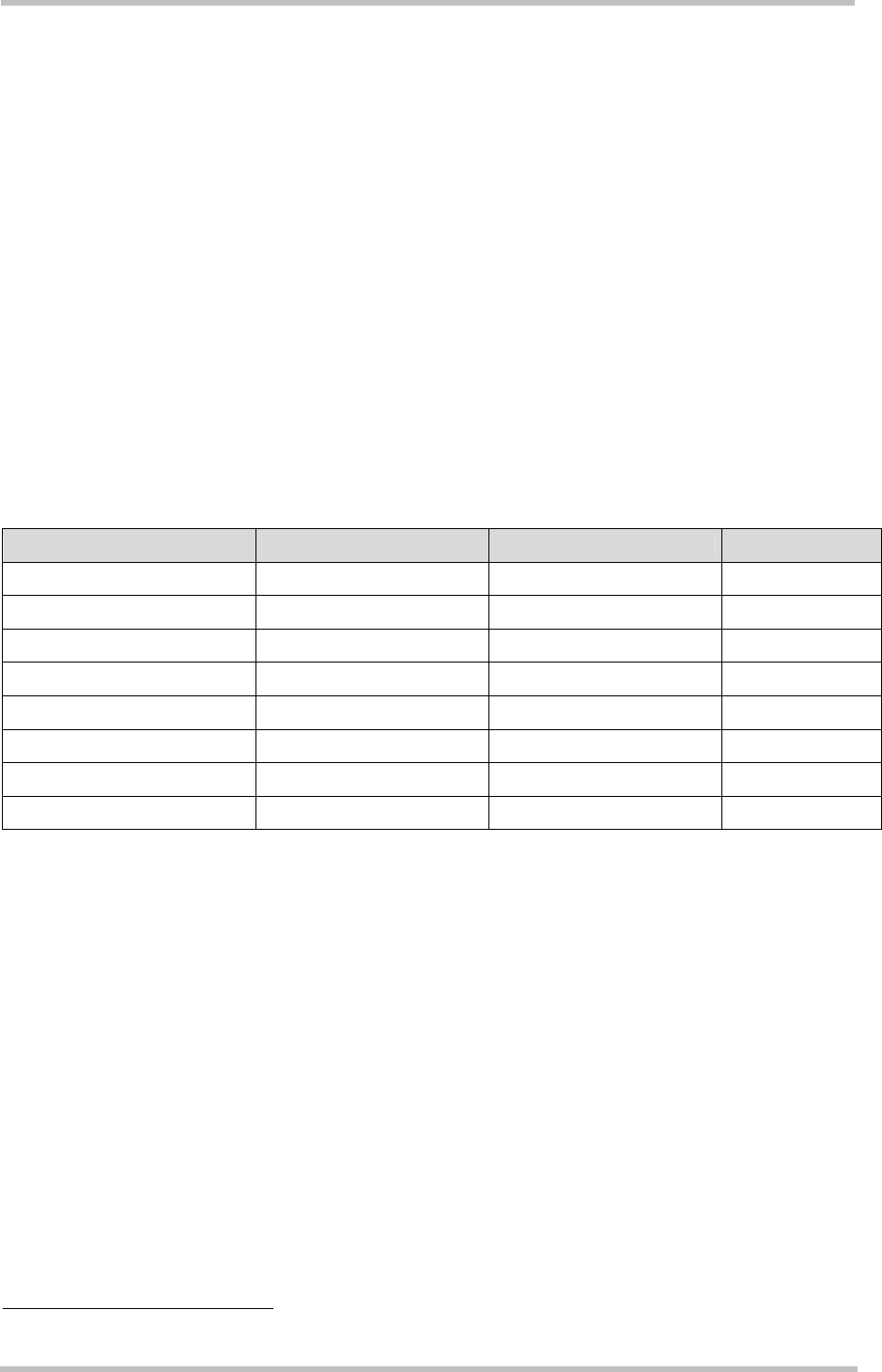
AC65/AC75 Hardware Interface Description
Confidential / Preliminary s
AC65/AC75_hd_v00.372 Page 69 of 118 2006-08-03
3.15.4 Digital Audio Interface (DAI)
The DAI can be used to connect audio devices capable of PCM (Pulse Code Modulation) or
for type approval. The following chapters describe the PCM interface functionality.
The PCM functionality allows the use of a codec like for example the MC145483. This codec
replaces the analog audio inputs and outputs during a call, if digital audio is selected by
AT^SAIC.
The PCM interface is configurable with the AT^SAIC command (see [1]) and supports the
following features:
- Master and slave mode
- Short frame and long frame synchronization
- 256 kHz or 512 kHz bit clock frequency
For the PCM interface configuration the parameters <clock>, <mode> and <framemode> of
the AT^SAIC command are used. The following table lists possible combinations:
Table 15: Configuration combinations for the PCM interface
Configuration <clock> <mode> <framemode>
Master, 256kHz, short frame 0 0 0
Master, 256kHz, long frame 0 0 1
Master, 512kHz, short frame 1 0 0
Master, 512kHz, long frame 1 0 1
Slave, 256kHz, short frame 0 or 13 1 0
Slave, 256kHz, long frame 0 or 1 1 1
Slave, 512kHz, short frame 0 or 1 1 0
Slave, 512kHz, long frame 0 or 1 1 1
In all configurations the PCM interface has the following common features:
- 16 Bit linear
- 8 kHz sample rate
- the most significant bit MSB is transferred first
- 125 µs frame duration
- common frame sync signal for transmit and receive
3 In slave mode the BCLKIN signal is directly used for data shifting. Therefore, the clock frequency setting is not
evaluated and may be either 0 or 1.
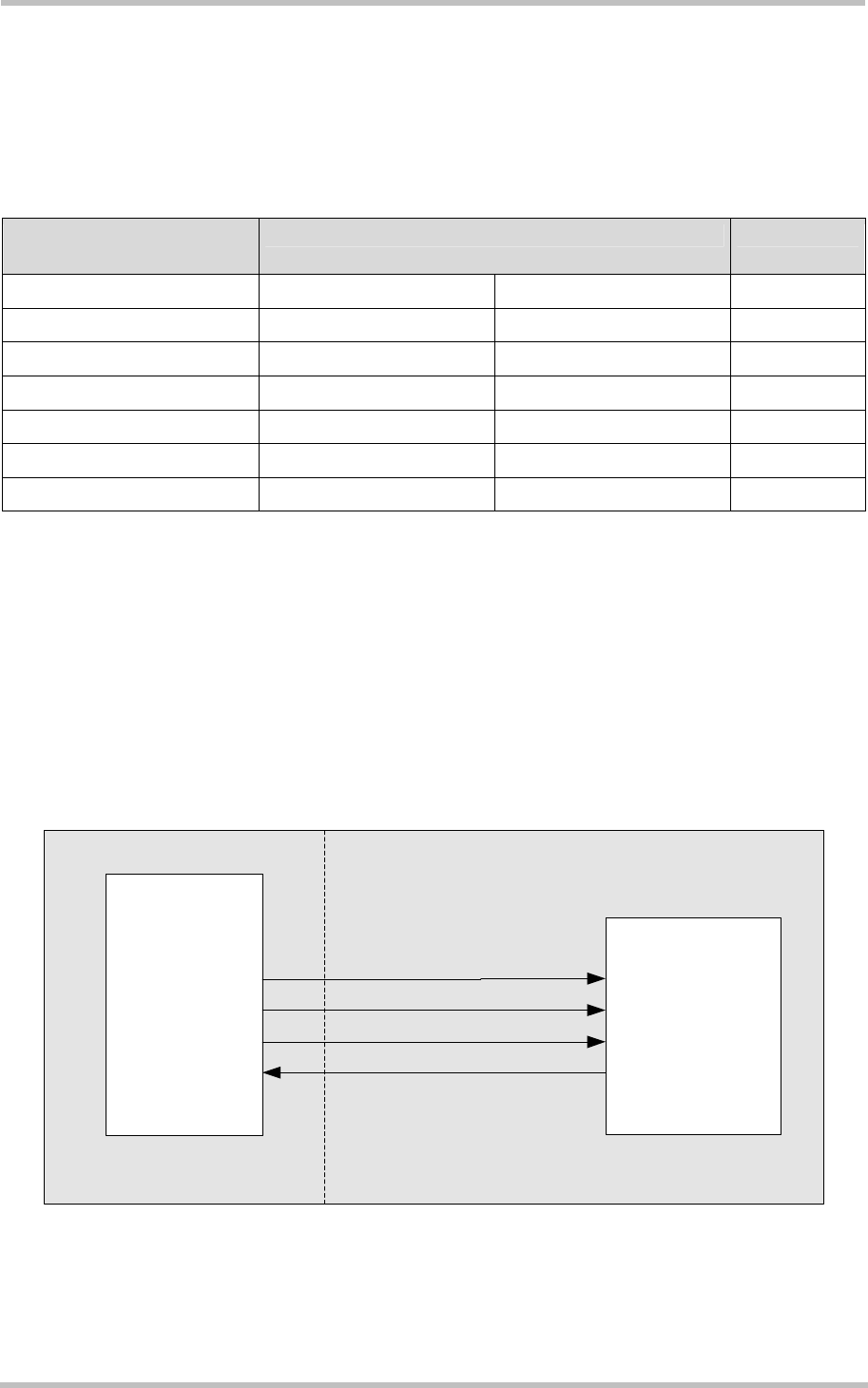
AC65/AC75 Hardware Interface Description
Confidential / Preliminary s
AC65/AC75_hd_v00.372 Page 70 of 118 2006-08-03
Table 16 shows the assignment of the DAI0…6 pins to the PCM interface signals. To avoid
hardware conflicts different pins are used as inputs and outputs for frame sync and clock
signals in master or slave operation. The table shows also which pin is used for master or
slave. The data pins (TXDAI and RXDAI) however are used in both modes. Unused inputs
have to be tied to GND, unused outputs must be left open.
Table 16: Overview of DAI pin functions
Signal name on
B2B connector
Function for PCM Interface Input/Output
DAI0 TXDAI Master/Slave O
DAI1 RXDAI Master/Slave I
DAI2 FS (Frame sync) Master O
DAI3 BITCLK Master O
DAI4 FSIN Slave I
DAI5 BCLKIN Slave I
DAI6 nc I
3.15.4.1 Master Mode
To clock input and output PCM samples the PCM interface delivers a bit clock (BITCLK)
which is synchronous to the GSM system clock. The frequency of the bit clock is 256kHz or
512kHz. Any edge of this clock deviates less than ±100ns (Jitter) from an ideal 256-kHz
clock respective 512-kHz-clock.
The frame sync signal (FS) has a frequency of 8 kHz and is high for one BITCLK period
before the data transmission starts if short frame is configured. If long frame is selected the
frame sync signal (FS) is high during the whole transfer of the 16 data bits. Each frame has a
duration of 125µs and contains 32 respectively 64 clock cycles.
BITCLK
FS
TXDAI
RXDAI
bitclk
frame sync
TX_data
RX_data
Codec
PCM interface of
the GSM module
Figure 28: Master PCM interface Application
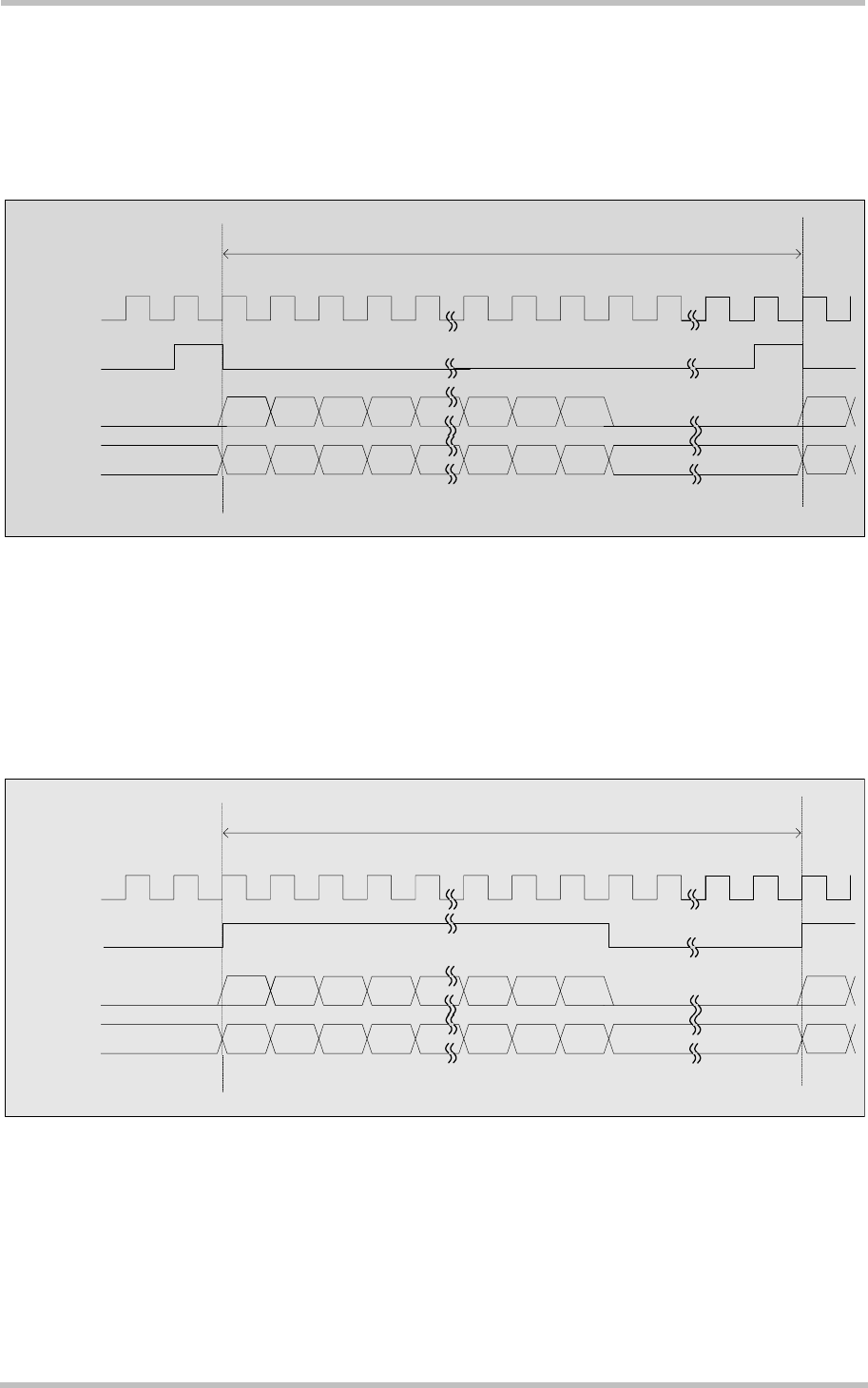
AC65/AC75 Hardware Interface Description
Confidential / Preliminary s
AC65/AC75_hd_v00.372 Page 71 of 118 2006-08-03
The timing of a PCM short frame is shown in Figure 29. The 16-bit TXDAI and RXDAI data
are transferred simultaneously in both directions during the first 16 clock cycles after the
frame sync pulse. The duration of a frame sync pulse is one BITCLK period, starting at the
rising edge of BITCLK. TXDAI data is shifted out at the next rising edge of BITCLK. RXDAI
data (i.e. data transmitted from the host application to the module’s RXDAI line) is sampled
at the falling edge of BITCLK.
BITCLK
TXDAI
RXDAI
FS
MSB
MSB
LSB
LSB
14 13
14 13
1
1
12
12
2
2
MSB
MSB
125 µs
Figure 29: Master PCM timing, short frame selected
The timing of a PCM long frame is shown in Figure 30. The 16-bit TXDAI and RXDAI data
are transferred simultaneously in both directions while the frame sync pulse FS is high. For
this reason the duration of a frame sync pulse is 16 BITCLK periods, starting at the rising
edge of BITCLK. TXDAI data is shifted out at the same rising edge of BITCLK. RXDAI data
(i.e. data transmitted from the host application to the module’s RXDAI line) is sampled at the
falling edge of BITCLK.
BITCLK
TXDAI
RXDAI
FS
MSB
MSB
LSB
LSB
14 13
14 13
1
1
12
12
2
2
MSB
MSB
125 µs
Figure 30: Master PCM timing, long frame selected
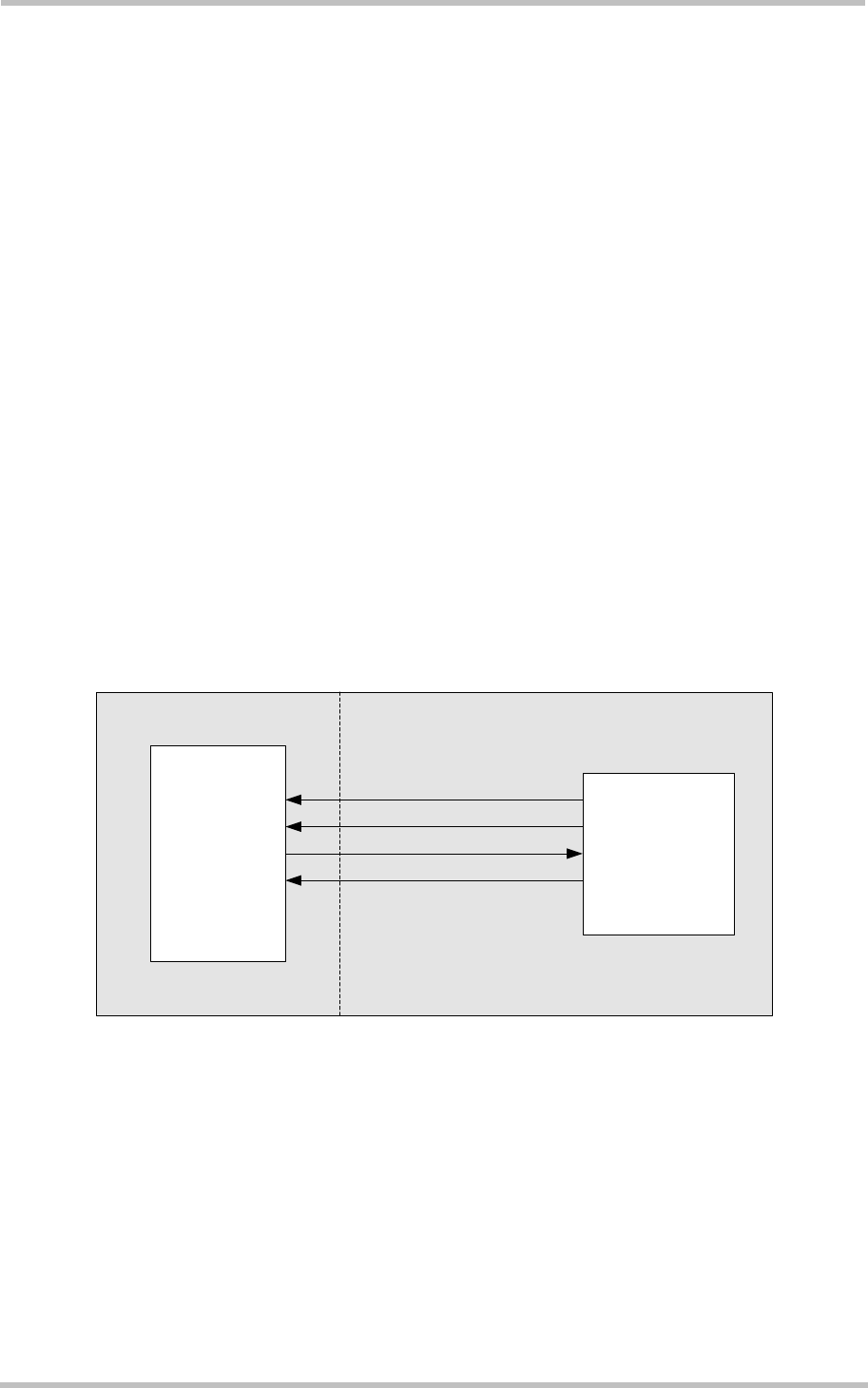
AC65/AC75 Hardware Interface Description
Confidential / Preliminary s
AC65/AC75_hd_v00.372 Page 72 of 118 2006-08-03
3.15.4.2 Slave Mode
In slave mode the PCM interface is controlled by an external bit clock and an external frame
sync signal applied to the BCLKIN and FSIN pins and delivered either by the connected
codec or another source. The bit clock frequency has to be in the range of 256kHz -125ppm
to 512kHz +125ppm.
Data transfer starts at the falling edge of FSIN if the short frame format is selected, and at
the rising edge of FSIN if long frame format is selected. With this edge control the frame sync
signal is independent of the frame sync pulse length.
TXDAI data is shifted out at the rising edge of BCLKIN. RXDAI data (i.e. data transmitted
from the host application to the module’s RXDAI line) is sampled at the falling edge of
BCLKIN.
The deviation of the external frame rate from the internal frame rate must not exceed
±125ppm. The internal frame rate of nominal 8kHz is synchronized to the GSM network.
The difference between the internal and the external frame rate is equalized by doubling or
skipping samples. This happens for example every second, if the difference is 125ppm.
The resulting distortion can be neglected in speech signals.
The pins BITCLK and FS remain low in slave mode.
Figure 31 shows the typical slave configuration. The external codec delivers the bit clock and
the frame sync signal. If the codec itself is not able to run in master mode as for example the
MC145483, a third party has to generate the clock and the frame sync signal.
BCLKIN
FSIN
TXDAI
RXDAI
bitclk
Frame Sync
TX_data
RX_data
CODEC
AC75
Figure 31: Slave PCM interface application
The following figures show the slave short and long frame timings. Because these are edge
controlled, frame sync signals may deviate from the ideal form as shown with the dotted
lines.
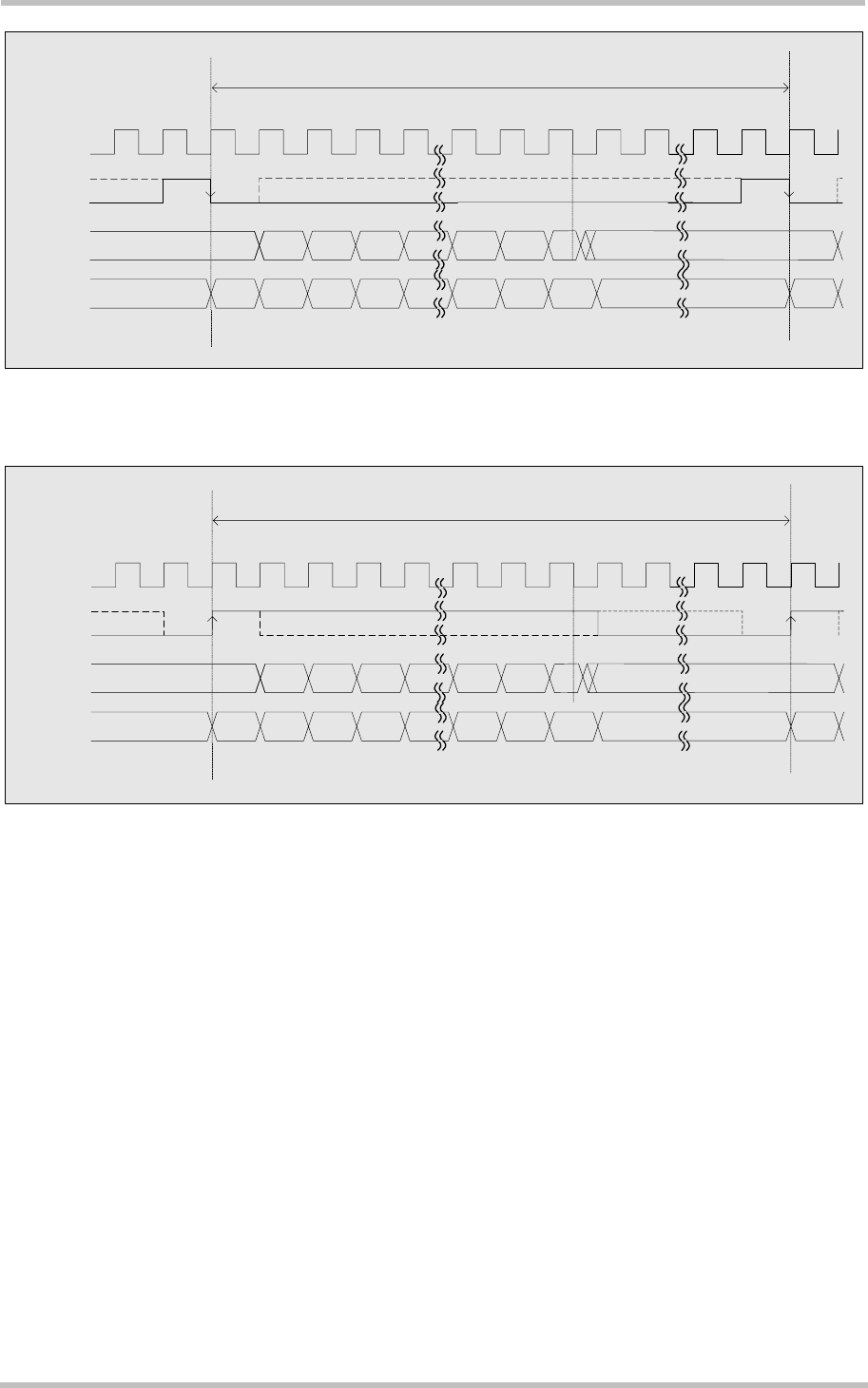
AC65/AC75 Hardware Interface Description
Confidential / Preliminary s
AC65/AC75_hd_v00.372 Page 73 of 118 2006-08-03
BCLKIN
TXDAI
RXDAI
FSIN
MSB
MSB
LSB
LSB
14 13
14 13
1
1
12
12
2
2MSB
125 µs
MSB
Figure 32: Slave PCM timing, short frame selected
MSB
BCLKIN
TXDAI
RXDAI
FSIN
MSB
MSB
LSB
LSB
14 13
14 13
1
1
12
12
2
2MSB
125 µs
Figure 33: Slave PCM timing, long frame selected

AC65/AC75 Hardware Interface Description
Confidential / Preliminary s
AC65/AC75_hd_v00.372 Page 74 of 118 2006-08-03
3.16 GPIO Interface
The AC65/AC75 has 10 GPIOs for external hardware devices. Each GPIO can be configured
for use as input or output. All settings are AT command controlled.
The GIPO related AT commands are the following: AT^SPIO, AT^SCPIN, AT^SCPOL,
AT^SCPORT, AT^SDPORT, AT^SGIO, AT^SSIO. A detailed description can be found in [1].
3.16.1 Using the GPIO10 Pin as Pulse Counter
The GPIO10 pin can be assigned two different functions selectable by AT command:
• The AT^SCPIN command configures the pin for use as GPIO.
• With AT^SCCNT and AT^SSCNT the pin can be configured and operated as pulse
counter.
Both functions exclude each other. The pulse counter disables the GPIO functionality, and
vice versa, the GPIO functionality disables the pulse counter. Detailed AT command
descriptions can be found in [1].
The pulse counter is designed to measure signals from 0 to 1000 pulses per second. It can
be operated either in Limit counter mode or Start-Stop mode. Depending on the selected
mode the counted value is either the number of pulses or the time (in milliseconds) taken to
generate a number of pulses specified with AT^SCCNT.
In Limit counter mode, the displayed measurement result (URC “^SSCNT: <count>”) implies
an inaccuracy <5ms. In Start-Stop mode, you can achieve 100% accuracy if you take care
that no pulses are transmitted before starting the pulse counter (AT^SSCNT=0 or 1) and
after closing the pulse counter (AT^SSCNT=3).
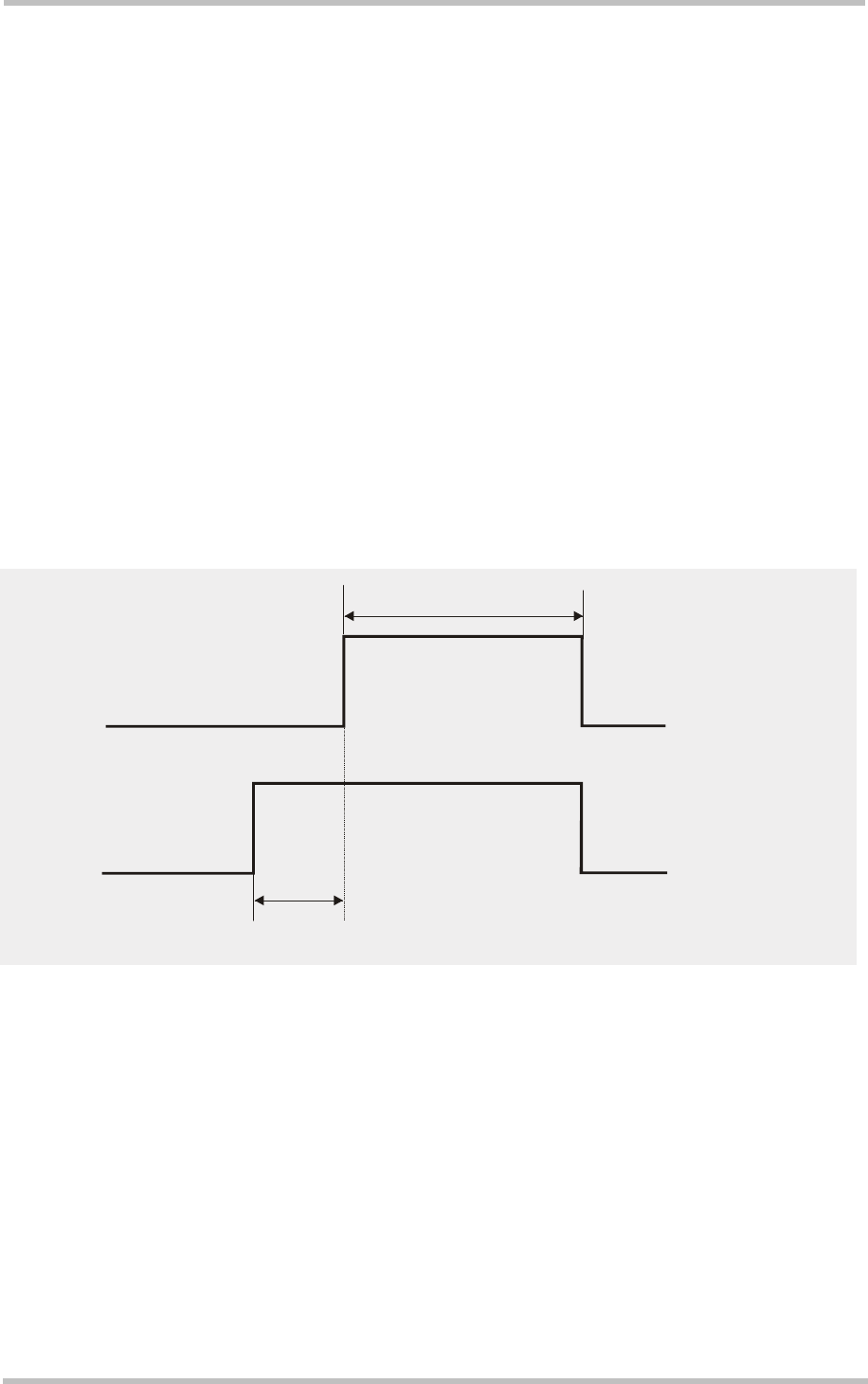
AC65/AC75 Hardware Interface Description
Confidential / Preliminary s
AC65/AC75_hd_v00.372 Page 75 of 118 2006-08-03
3.17 Control Signals
3.17.1 Synchronization Signal
The synchronization signal serves to indicate growing power consumption during the transmit
burst. The signal is generated by the SYNC pin. Please note that this pin can adopt three
different operating modes which you can select by using the AT^SSYNC command: the
mode AT^SSYNC=0 described below, and the two LED modes AT^SSYNC=1 or
AT^SSYNC=2 described in [1] and Section 3.17.2.
The first function (factory default AT^SSYNC=0) is recommended if you want your
application to use the synchronization signal for better power supply control. Your platform
design must be such that the incoming signal accommodates sufficient power supply to the
AC65/AC75 module if required. This can be achieved by lowering the current drawn from
other components installed in your application.
The timing of the synchronization signal is shown below. High level of the SYNC pin
indicates increased power consumption during transmission.
Figure 34: SYNC signal during transmit burst
*) The duration of the SYNC signal is always equal, no matter whether the traffic or the
access burst are active.
Transmit burst
1 Tx 577 µs every 4.616 ms
2 Tx 1154 µs every 4.616 ms
SYNC signal
*)
t = 180 sµ
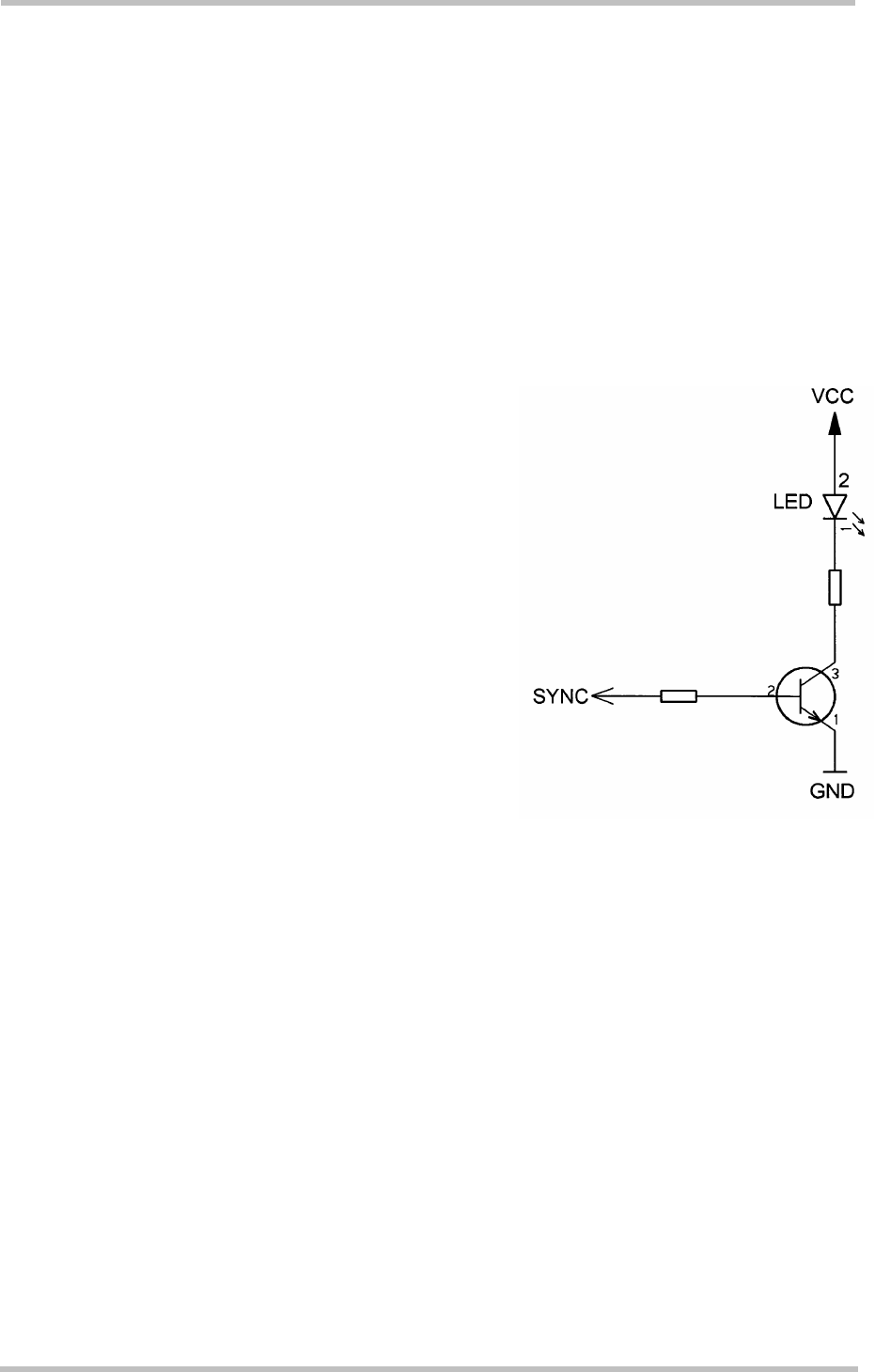
AC65/AC75 Hardware Interface Description
Confidential / Preliminary s
AC65/AC75_hd_v00.372 Page 76 of 118 2006-08-03
3.17.2 Using the SYNC Pin to Control a Status LED
As an alternative to generating the synchronization signal, the SYNC pin can be configured
to drive a status LED that indicates different operating modes of the AC65/AC75 module. To
take advantage of this function the LED mode must be activated with the AT^SSYNC
command and the LED must be connected to the host application. The connected LED can
be operated in two different display modes (AT^SSYNC=1 or AT^SSYNC=2). For details
please refer to [1].
Especially in the development and test phase of an application, system integrators are
advised to use the LED mode of the SYNC pin in order to evaluate their product design and
identify the source of errors.
To operate the LED a buffer, e.g. a transistor or gate,
must be included in your application. A sample circuit
is shown in Figure 35. Power consumption in the LED
mode is the same as for the synchronization signal
mode. For details see Table 26, SYNC pin.
Figure 35: LED Circuit (Example)
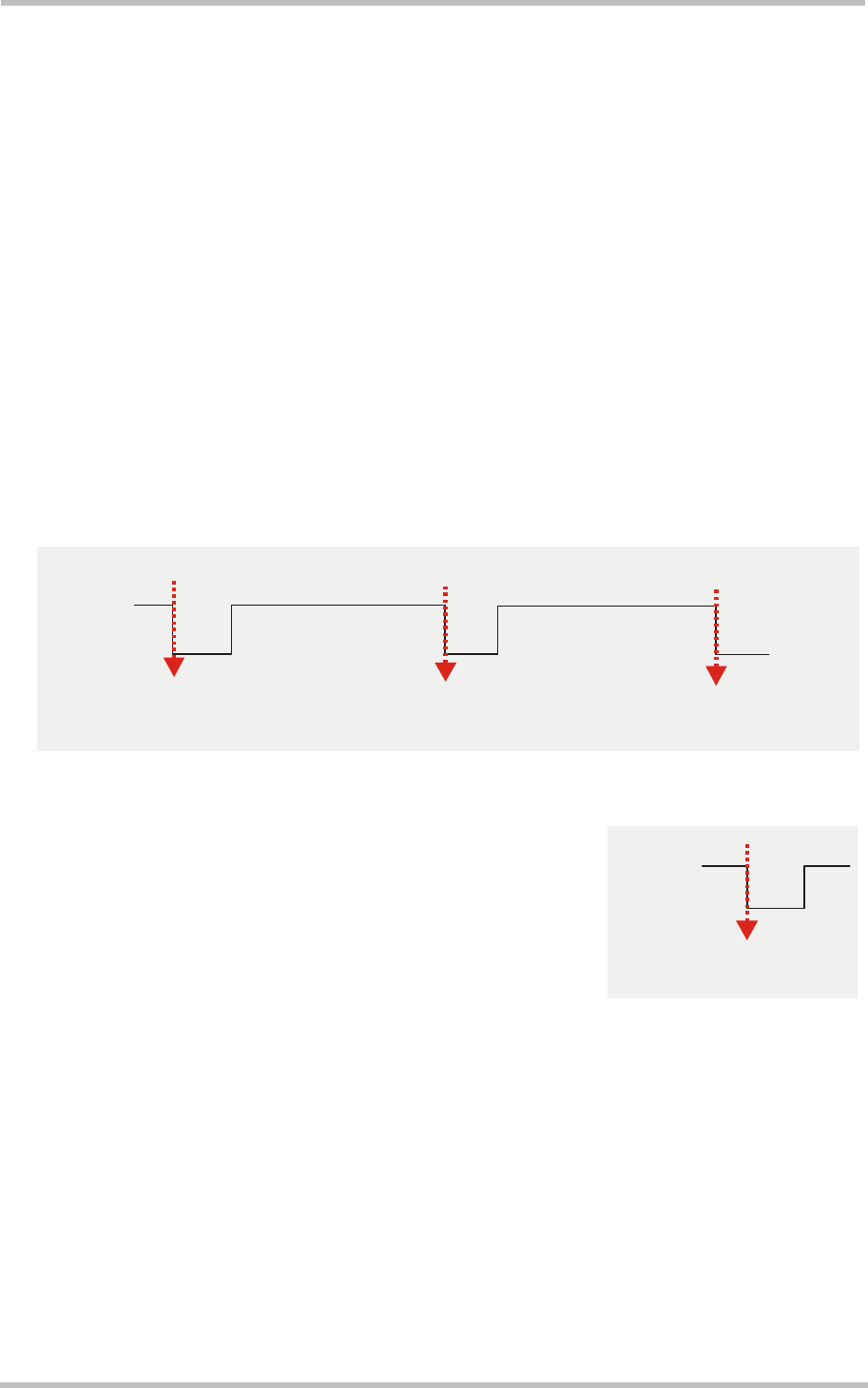
AC65/AC75 Hardware Interface Description
Confidential / Preliminary s
AC65/AC75_hd_v00.372 Page 77 of 118 2006-08-03
1s
RING0
URC
3.17.3 Behavior of the RING0 Line (ASC0 Interface only)
The RING0 line is available on the first serial interface ASC0 (see also Chapter 3.10). The
signal serves to indicate incoming calls and other types of URCs (Unsolicited Result Code).
Although not mandatory for use in a host application, it is strongly suggested that you
connect the RING0 line to an interrupt line of your application. In this case, the application
can be designed to receive an interrupt when a falling edge on RING0 occurs. This solution
is most effective, particularly, for waking up an application from power saving. Note that if the
RING0 line is not wired, the application would be required to permanently poll the data and
status lines of the serial interface at the expense of a higher current consumption. Therefore,
utilizing the RING0 line provides an option to significantly reduce the overall current
consumption of your application.
The behavior of the RING0 line varies with the type of event:
• When a voice/fax/data call comes in the RING0 line goes low for 1s and high for another
4s. Every 5 seconds the ring string is generated and sent over the /RXD0 line.
If there is a call in progress and call waiting is activated for a connected handset or
handsfree device, the RING0 line switches to ground in order to generate acoustic
signals that indicate the waiting call.
Figure 36: Incoming voice/fax/data call
• All other types of Unsolicited Result Codes (URCs) also
cause the RING0 line to go low, however for 1 second
only.
Figure 37: URC transmission
3.17.4 PWR_IND Signal
PWR_IND notifies the on/off state of the module. High state of PWR_IND indicates that the
module is switched off. The state of PWR_IND immediately changes to low when IGT is
pulled low. For state detection an external pull-up resistor is required.
4s
RING0
4s
1s 1s 1s
Ring
string
Ring
string
Ring
string
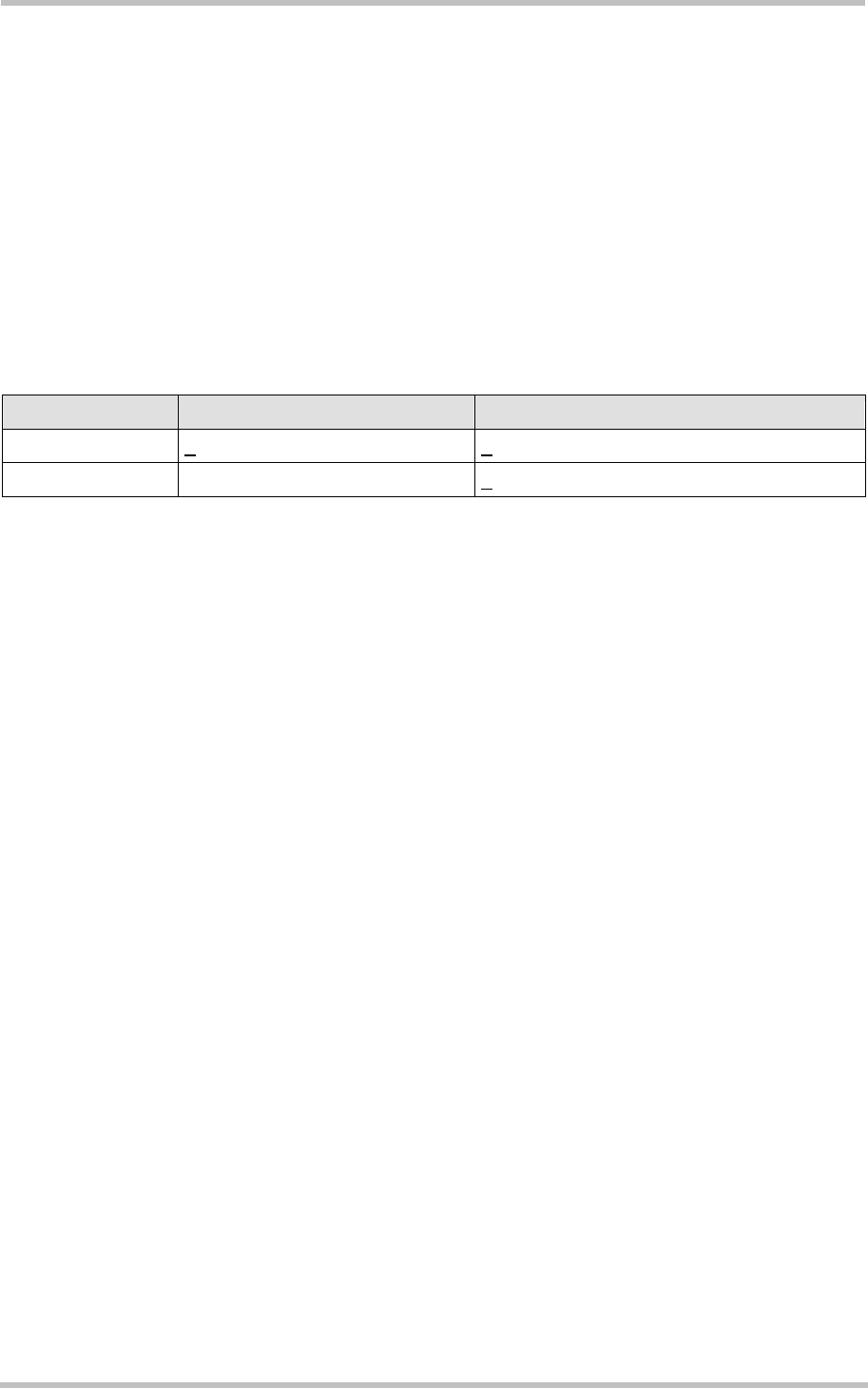
AC65/AC75 Hardware Interface Description
Confidential / Preliminary s
AC65/AC75_hd_v00.372 Page 78 of 118 2006-08-03
4 Antenna Interface
The RF interface has an impedance of 50. AC65/AC75 is capable of sustaining a total
mismatch at the antenna connector without any damage, even when transmitting at
maximum RF power.
The external antenna must be matched properly to achieve best performance regarding
radiated power, DC-power consumption, modulation accuracy and harmonic suppression.
Antenna matching networks are not included on the AC65/AC75 PCB and should be placed
in the host application.
Regarding the return loss AC65/AC75 provides the following values in the active band:
Table 17: Return loss in the active band
State of module Return loss of module Recommended return loss of application
Receive > 8dB > 12dB
Transmit not applicable > 12dB
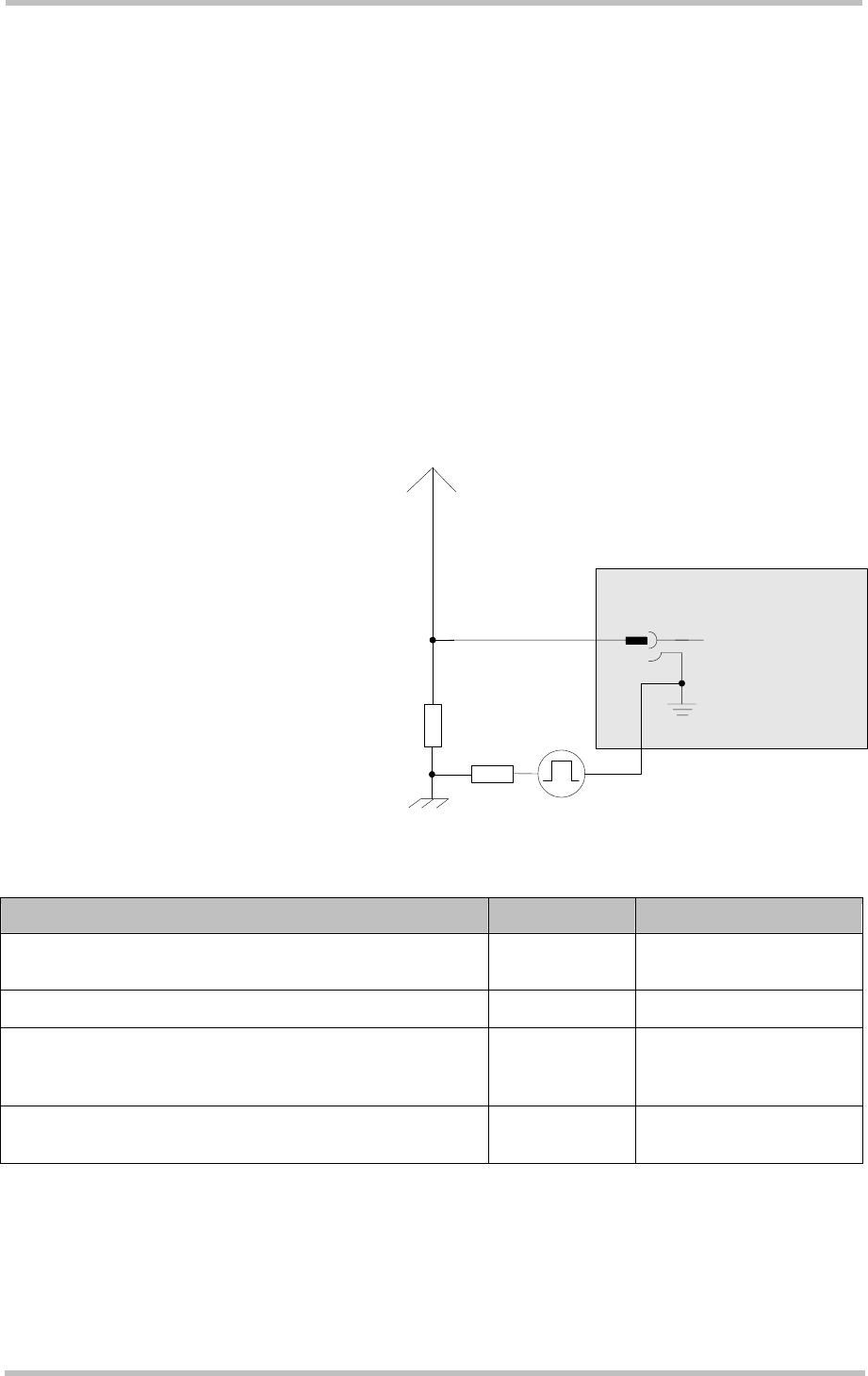
AC65/AC75 Hardware Interface Description
Confidential / Preliminary s
AC65/AC75_hd_v00.372 Page 79 of 118 2006-08-03
4.1 Antenna Diagnostic
The antenna diagnostic allows the customer to check the presence and the connection
status of the antenna by using the AT^SAD command. A description of the AT^SAD
command can be found in [1].
To properly detect the antenna and verify its connection status the antenna feed point must
have a DC resistance RANT of 9kΩ (±3kΩ). Any lower or higher resistance from 1kΩ to 6kΩ or
12kΩ to 40k gives an undefined result.
A positive or negative voltage drop (referred to as Vdisturb) on the ground line may occur
without having any impact on the measuring procedure and the measuring result. A peak
deviation (Vdisturb ) of ≤ 0.8V from ground is acceptable.
Vdisturb (peak) = ± 0.8V (maximum); fdisturb = 0Hz … 5kHz
Waveform: DC, sinus, square-pulse, peak-pulse (width = 100µs)
Rdisturb = 5
Figure 38: Resistor measurement used for
antenna detection
Table 18: Values of the AT^SAD parameter <diag> and their meaning
Antenna connection status indicated by AT^SAD <diag> Equivalent ranges
Normal operation, antenna connected (resistance at
feed point as required)
<diag>=0 RANT = 6kΩ…12kΩ
Antenna connector short-circuited to GND <diag>=1 RANT = 0...1kΩ
Antenna connector is short-circuited to the supply
voltage of the host application, for example the vehicle’s
on-board power supply voltage
<diag>=2 max. 36V
Antenna not properly connected, or resistance at
antenna feed point wrong or not present
<diag>=3 RANT = 40kΩ...Ω
Antenna connector
AC75
9k±3k
External antenna
V
disturb
5 Ohm

AC65/AC75 Hardware Interface Description
Confidential / Preliminary s
AC65/AC75_hd_v00.372 Page 80 of 118 2006-08-03
4.2 Antenna Connector
AC65/AC75 uses a subminiature coaxial antenna connector type SMP MIL-Std 348-A
supplied from Rosenberger.
Table 19: Product specifications of Rosenberger SMP connector
Item Specification Conditions
Material and finish
Center contact Brass
0.8 µm gold plating over 2-4 µm NiP
plating
Outer contact Brass
0.8 µm gold plating over 2-4 µm NiP
plating
Dielectric PTFE
Electrical ratings
Nominal Impedance 50 Ω
Operating frequency DC – 2 GHz
VSWR 1.10 DC to 2 GHz
Insertion loss ≤ 0.1 dB x √ f/GHz
Center contact resistance max. 6 mΩ
Outer contact resistance max. 2 mΩ
Insulation resistance 5 GΩ
Working voltage 335 V rms at sea level
Dielectric withstanding voltage 500 V rms at sea level
Mechanical ratings
Durability 30 mating cycles
Engagement force 20-35 N
Disengagement force 30-50 N
Center contact captivation
Axial retention force
7 N min.
Environmental ratings
Operating temperature -65°C to +155°C
Manufacturer
Rosenberger Hochfrequenztechnik GmbH & Co.
POB 1260
D-84526 Tittmoning
http://www.rosenberger.de
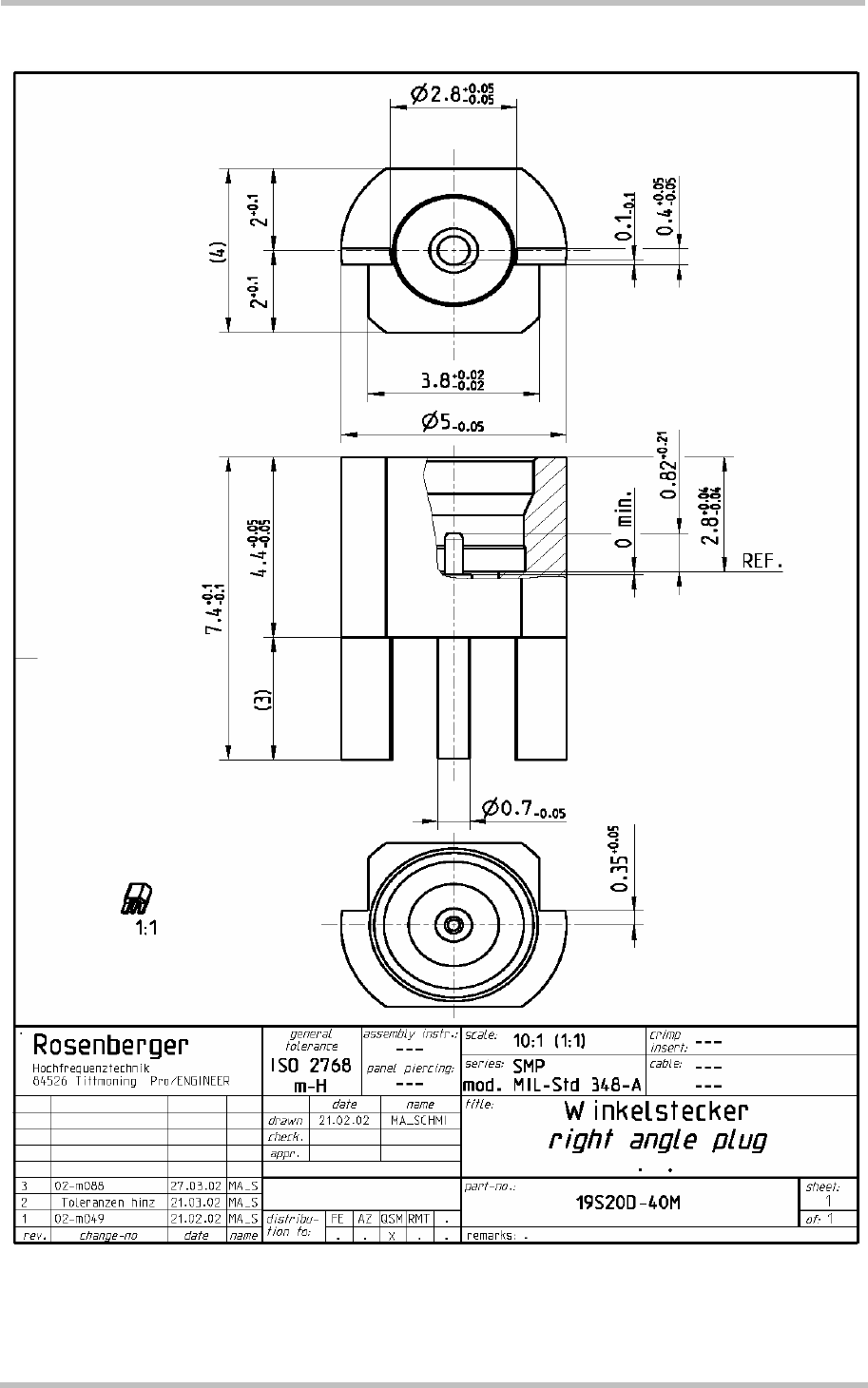
AC65/AC75 Hardware Interface Description
Confidential / Preliminary s
AC65/AC75_hd_v00.372 Page 81 of 118 2006-08-03
Figure 39: Datasheet of Rosenberger SMP MIL-Std 348-A connector

AC65/AC75 Hardware Interface Description
Confidential / Preliminary s
AC65/AC75_hd_v00.372 Page 82 of 118 2006-08-03
5 Electrical, Reliability and Radio Characteristics
5.1 Absolute Maximum Ratings
The absolute maximum ratings stated in Table 20 are stress ratings under any conditions.
Stresses beyond any of these limits will cause permanent damage to AC65/AC75. The
power supply shall be compliant with the SELV safety standard defined in EN60950. The
supply voltage must be limited according to Table 20.
Table 20: Absolute maximum ratings
Parameter Min Max Unit
Supply voltage BATT+ -0.3 5.5 V
Voltage at digital pins in POWER DOWN mode -0.3 0.3 V
Voltage at digital pins in normal operation -0.3 3.05
or
VEXT+0.3
V
Voltage at analog pins in POWER DOWN mode -0.3 0.3 V
Voltage at analog pins, VMIC on4 -0.3 2.75 V
Voltage at analog pins, VMIC off4 -0.3 0.3 V
Voltage at VCHARGE pin -0.3 5.5 V
Voltage at CHARGEGATE pin -0.3 5.5 V
VUSB_IN -0.3 5.5 V
USB_DP, USB_DN -0.3 3.5 V
VSENSE 5.5 V
ISENSE 5.5 V
PWR_IND -0.3 10 V
VDDLP -0.3 5.5 V
4 For normal operation the voltage at analog pins with VMIC on should be within the range of 0V to 2.4V and with
VMIC off within the range of -0.25V to 0.25V.
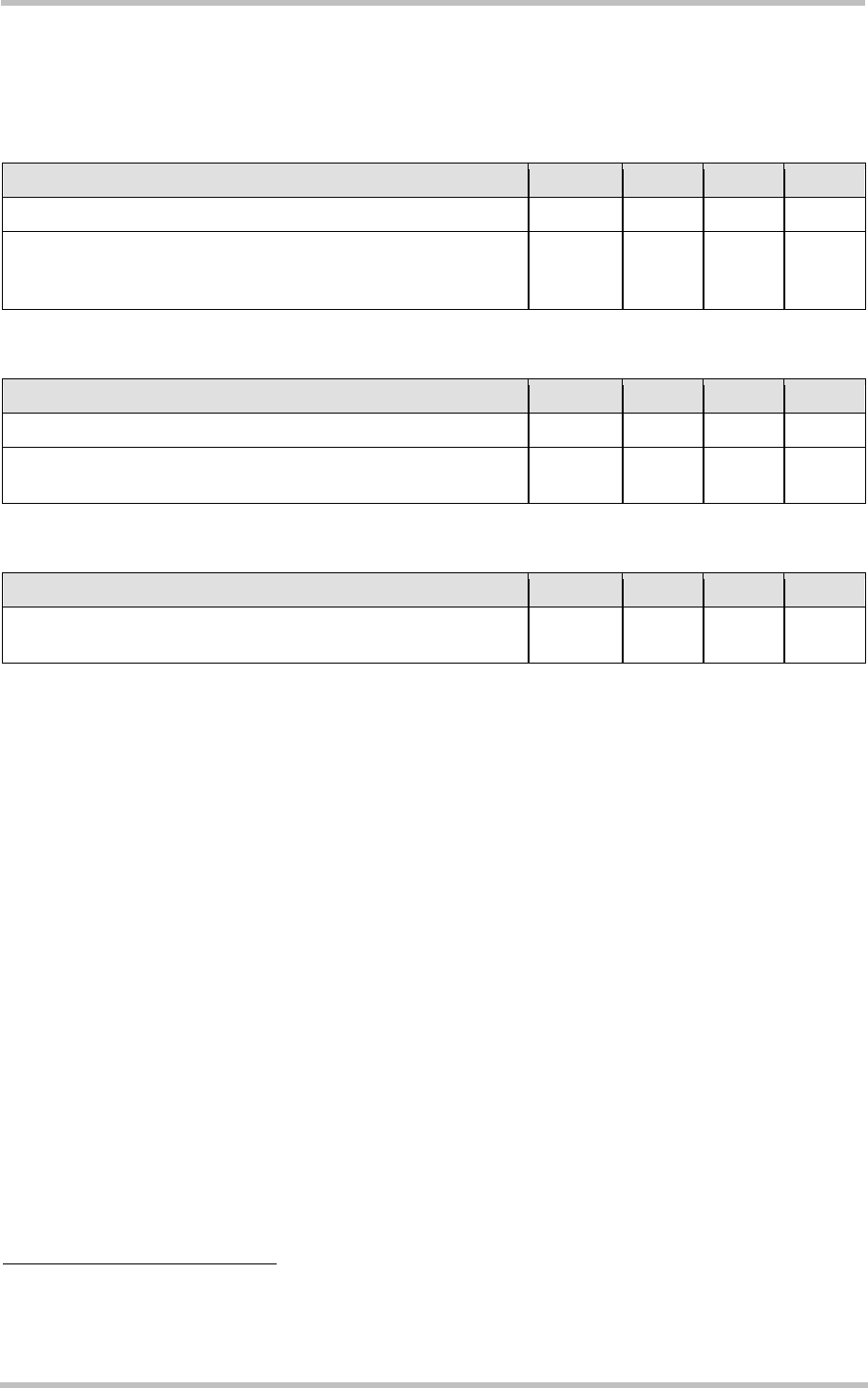
AC65/AC75 Hardware Interface Description
Confidential / Preliminary s
AC65/AC75_hd_v00.372 Page 83 of 118 2006-08-03
5.2 Operating Temperatures
Table 21: Board temperature
Parameter Min Typ Max Unit
Operating temperature range -30 +85 °C
Automatic shutdown5
Temperature measured on AC65/AC75 board
Temperature measured at battery NTC
-30
-20
---
---
+90
+60
°C
Table 22: Ambient temperature according to IEC 60068-2 (without forced air circulation)
Parameter Min Typ Max Unit
Operating temperature range -30 +25 +75 °C
Restricted operation6 --- +75 to
+85
°C
Table 23: Charging temperature
Parameter Min Typ Max Unit
Battery temperature for software controlled fast charging
(measured at battery NTC)
0 --- +45 °C
Note:
• See Chapter 3.3.4 for further information about the NTCs for on-board and battery
temperature measurement, automatic thermal shutdown and alert messages.
• When data are transmitted over EGPRS or GPRS the AC65/AC75 automatically reverts
to a lower Multislot Class if the temperature increases to the limit specified for normal
operation and, vice versa, returns to the higher Multislot Class if the temperature is back
to normal. For details see Chapter 3.4 “Automatic EGPRS/GPRS Multislot Class
Change”.
5 Due to temperature measurement uncertainty, a tolerance on the stated shutdown thresholds may occur. The
possible deviation is in the range of ± 3°C at the overtemperature limit and ± 5°C at the undertemperature limit.
6 Restricted operation allows normal mode speech calls or data transmission for limited time until automatic
thermal shutdown takes effect. The duration of emergency calls is unlimited because automatic thermal
shutdown is deferred until hang up.

AC65/AC75 Hardware Interface Description
Confidential / Preliminary s
AC65/AC75_hd_v00.372 Page 84 of 118 2006-08-03
5.3 Storage Conditions
The conditions stated below are only valid for modules in their original packed state in
weather protected, non-temperature-controlled storage locations. Normal storage time under
these conditions is 12 months maximum.
Table 24: Storage conditions
Type Condition Unit Reference
Air temperature: Low
High
-40
+85
°C ETS 300 019-2-1: T1.2, IEC 68-2-1 Ab
ETS 300 019-2-1: T1.2, IEC 68-2-2 Bb
Humidity relative: Low
High
Condens.
10
90 at 30°C
90-100 at 30°C
% ---
ETS 300 019-2-1: T1.2, IEC 68-2-56 Cb
ETS 300 019-2-1: T1.2, IEC 68-2-30 Db
Air pressure: Low
High
70
106
kPa IEC TR 60271-3-1: 1K4
IEC TR 60271-3-1: 1K4
Movement of surrounding air 1.0 m/s IEC TR 60271-3-1: 1K4
Water: rain, dripping, icing and
frosting
Not allowed --- ---
Radiation: Solar
Heat
1120
600
W/m2 ETS 300 019-2-1: T1.2, IEC 68-2-2 Bb
ETS 300 019-2-1: T1.2, IEC 68-2-2 Bb
Chemically active substances Not
recommended
IEC TR 60271-3-1: 1C1L
Mechanically active substances Not
recommended
IEC TR 60271-3-1: 1S1
Vibration sinusoidal:
Displacement
Acceleration
Frequency range
1.5
5
2-9 9-200
mm
m/s2
Hz
IEC TR 60271-3-1: 1M2
Shocks:
Shock spectrum
Duration
Acceleration
semi-sinusoidal
1
50
ms
m/s2
IEC 68-2-27 Ea

AC65/AC75 Hardware Interface Description
Confidential / Preliminary s
AC65/AC75_hd_v00.372 Page 85 of 118 2006-08-03
5.4 Reliability Characteristics
The test conditions stated below are an extract of the complete test specifications.
Table 25: Summary of reliability test conditions
Type of test Conditions Standard
Vibration Frequency range: 10-20Hz; acceleration: 3.1mm
amplitude
Frequency range: 20-500Hz; acceleration: 5g
Duration: 2h per axis = 10 cycles; 3 axes
DIN IEC 68-2-6
Shock half-sinus Acceleration: 500g
Shock duration: 1msec
1 shock per axis
6 positions (± x, y and z)
DIN IEC 68-2-27
Dry heat Temperature: +70 ±2°C
Test duration: 16h
Humidity in the test chamber: < 50%
EN 60068-2-2 Bb
ETS 300 019-2-7
Temperature
change (shock)
Low temperature: -40°C ±2°C
High temperature: +85°C ±2°C
Changeover time: < 30s (dual chamber system)
Test duration: 1h
Number of repetitions: 100
DIN IEC 68-2-14 Na
ETS 300 019-2-7
Damp heat cyclic High temperature: +55°C ±2°C
Low temperature: +25°C ±2°C
Humidity: 93% ±3%
Number of repetitions: 6
Test duration: 12h + 12h
DIN IEC 68-2-30 Db
ETS 300 019-2-5
Cold (constant
exposure)
Temperature: -40 ±2°C
Test duration: 16h
DIN IEC 68-2-1
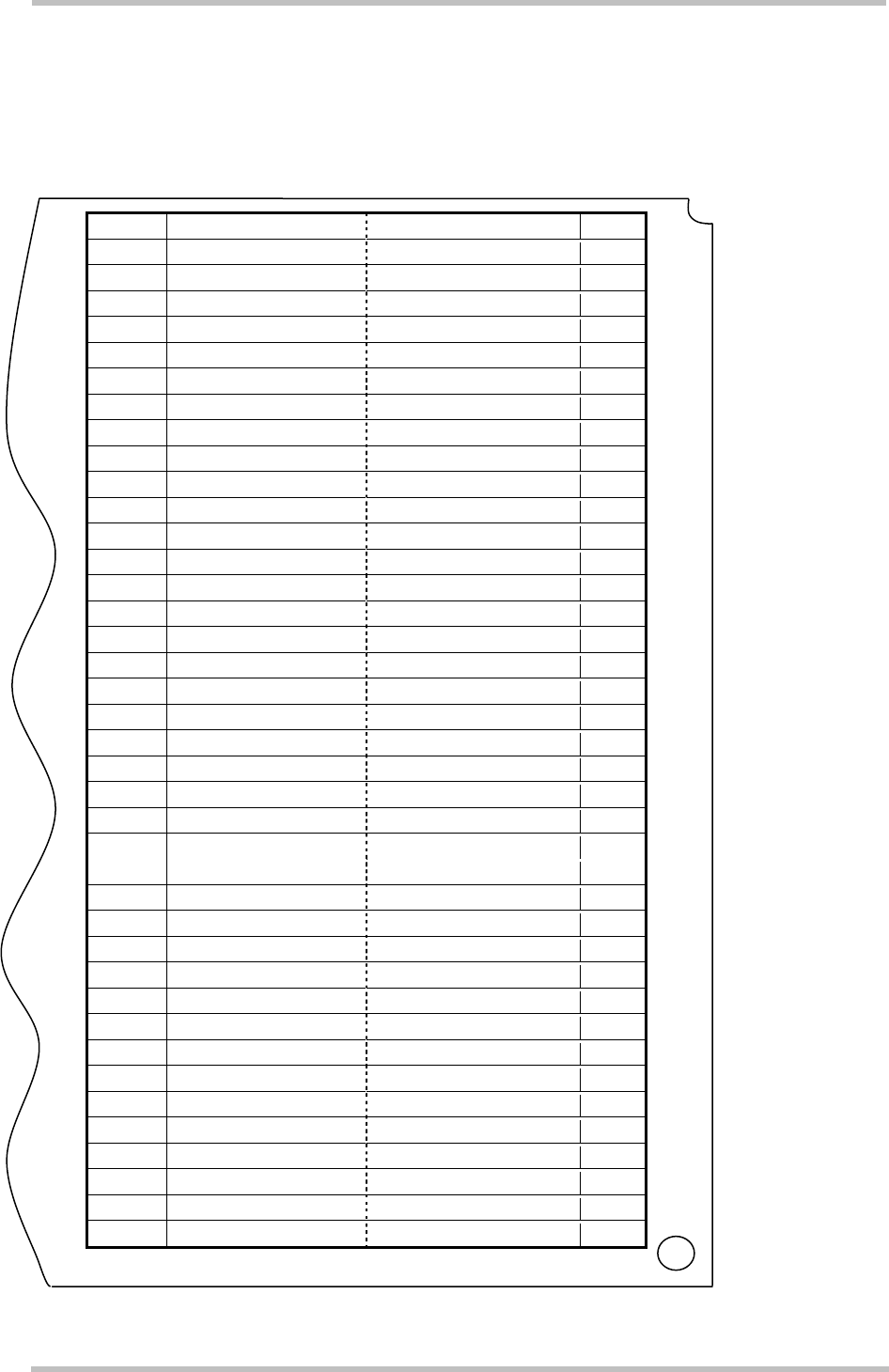
AC65/AC75 Hardware Interface Description
Confidential / Preliminary s
AC65/AC75_hd_v00.372 Page 86 of 118 2006-08-03
5.5 Pin Assignment and Signal Description
The Molex board-to-board connector on AC65/AC75 is an 80-pin double-row receptacle. The
names and the positions of the pins can be seen from Figure 1 which shows the top view of
AC65/AC75.
1 GND GND 80
2 Not connected DAC_OUT 79
3 Not connected PWR_IND 78
4 GND Do not use 77
5 GPIO10 GPIO9 76
6 GPIO8 SPICS 75
7 SPIDI GPIO4 74
8 GPIO7 GPIO3 73
9 GPIO6 GPIO2 72
10 GPIO5 GPIO1 71
11 I2CCLK_SPICLK I2CDAT_SPIDO 70
12 VUSB_IN USB_DP 69
13 DAI5 USB_DN 68
14 ISENSE VSENSE 67
15 DAI6 VMIC 66
16 CCCLK EPN2 65
17 CCVCC EPP2 64
18 CCIO EPP1 63
19 CCRST EPN1 62
20 CCIN MICN2 61
21 CCGND MICP2 60
22 DAI4 MICP1 59
23 DAI3 MICN1 58
24 DAI2 AGND 57
25 DAI1 IGT 56
26 DAI0 EMERG_RST 55
27 BATT_TEMP DCD0 54
28 SYNC CTS1 53
29 RXD1 CTS0 52
30 RXD0 RTS1 51
31 TXD1 DTR0 50
32 TXD0 RTS0 49
33 VDDLP DSR0 48
34 VCHARGE RING0 47
35 CHARGEGATE VEXT 46
36 GND BATT+ 45
37 GND BATT+ 44
38 GND BATT+ 43
39 GND BATT+ 42
40 GND BATT+ 41
Figure 40: Pin assignment (component side of AC65/AC75)

AC65/AC75 Hardware Interface Description
Confidential / Preliminary s
AC65/AC75_hd_v00.372 Page 87 of 118 2006-08-03
Please note that the reference voltages listed in Table 26 are the values measured directly
on the AC65/AC75 module. They do not apply to the accessories connected.
Table 26: Signal description
Function Signal name IO Signal form and level Comment
VImax = 4.5V
VItyp = 3.8V
VImin = 3.3V during Tx burst on board
I 2A, during Tx burst
Power
supply
BATT+ I
n Tx = n x 577µs peak current every
4.616ms
Five pins of BATT+ and GND
must be connected in parallel
for supply purposes because
higher peak currents may
occur.
Minimum voltage must not fall
below 3.3V including drop,
ripple, spikes.
Power
supply
GND Ground Application Ground
VCHARGE I VImin = 1.015 * VBATT+
VImax = 5.45V
This line signalizes to the
processor that the charger is
connected.
If unused keep pin open.
BATT_TEMP I
Connect NTC with RNTC 10kΩ @ 25°C to
ground. See Section 3.5.3 for B value of
NTC.
Battery temperature
measurement via NTC
resistance.
NTC should be installed
inside or near battery pack to
enable proper charging and
deliver temperature values.
If unused keep pin open.
ISENSE I VImax = 4.65V
∆VImax to VBATT+ = +0.3V at normal
condition
ISENSE is required for
measuring the charge current.
For this purpose, a shunt
resistor for current
measurement needs to be
connected between ISENSE
and VSENSE.
If unused connect pin to
VSENSE.
VSENSE I VImax = 4.5V VSENSE must be directly
connected to BATT+ at
battery connector or external
power supply.
Charge
Interface
CHARGEGATE O VOmax = 5.5V
IOmax = 0.6mA
Control line to the gate of
charge FET
If unused keep pin open.
External
supply
voltage
VEXT O Normal mode:
VOmin = 2.75V
VOtyp = 2.93V
VOmax = 3.05V
IOmax = -50mA
VEXT may be used for
application circuits, for
example to supply power for
an I2C
If unused keep pin open.
Not available in Power-down
mode. The external digital
logic must not cause any
spikes or glitches on voltage
VEXT.
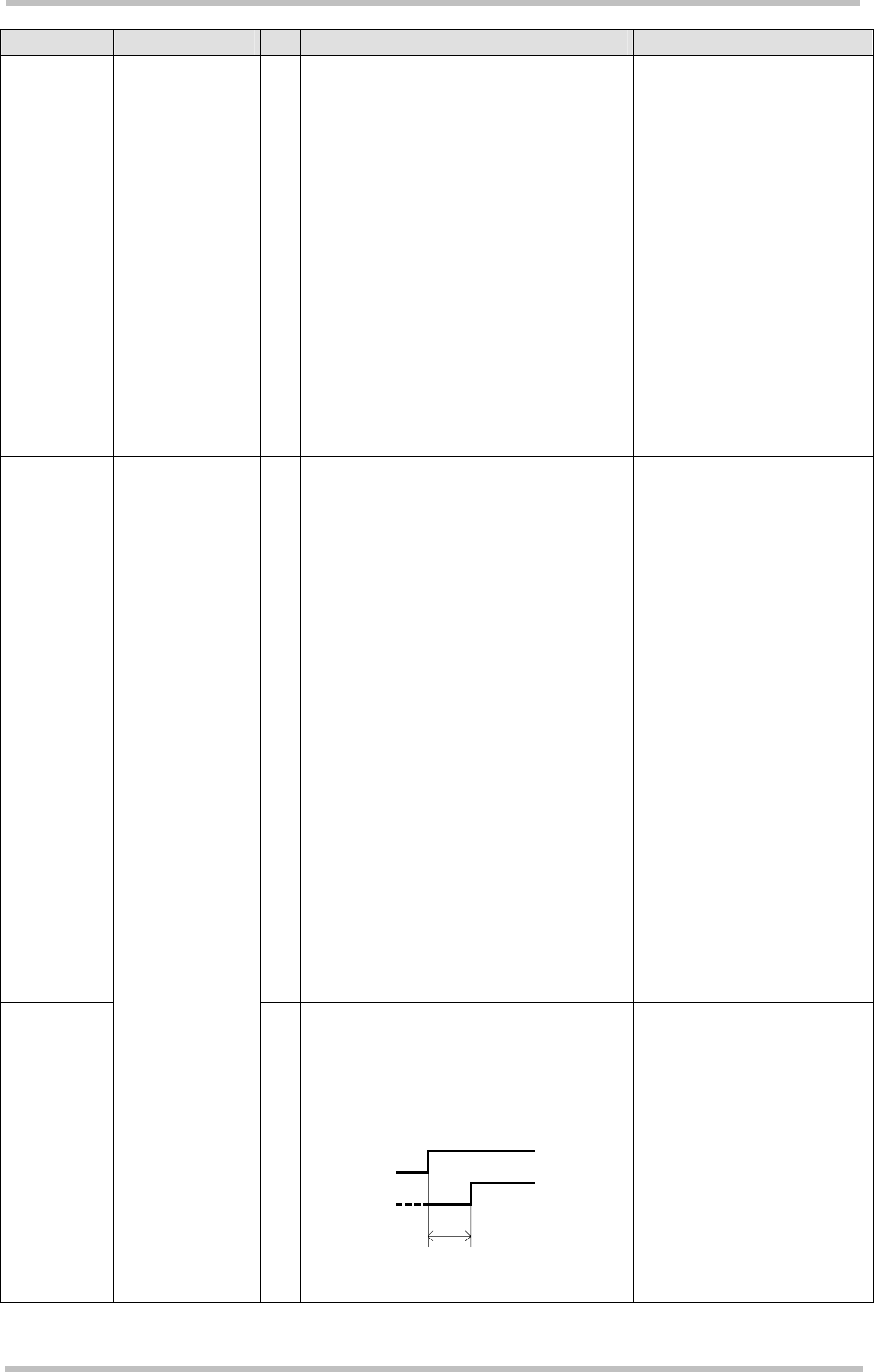
AC65/AC75 Hardware Interface Description
Confidential / Preliminary s
AC65/AC75_hd_v00.372 Page 88 of 118 2006-08-03
Function Signal name IO Signal form and level Comment
Power
indicator
PWR_IND O VIHmax = 10V
VOLmax = 0.4V at Imax = 2mA
PWR_IND (Power Indicator)
notifies the module’s on/off
state.
PWR_IND is an open
collector that needs to be
connected to an external pull-
up resistor. Low state of the
open collector indicates that
the module is on. Vice versa,
high level notifies the Power-
down mode.
Therefore, the pin may be
used to enable external
voltage regulators which
supply an external logic for
communication with the
module, e.g. level converters.
Ignition IGT I
Internal pull-up: RI 30kΩ, CI 10nF
VILmax = 0.8V at Imax = -150µA
VOHmax = 4.5V (VBATT+)
ON ~~~|____|~~~ Active Low ≥ 400ms
This signal switches the
mobile on.
This line must be driven low
by an open drain or open
collector driver.
Emergency
reset
I Internal pull-up: RI 5kΩ
VILmax = 0.2V at Imax = -0.5mA
VOHmin = 1.75V
VOHmax = 3.05V
Signal ~~~|______|~~~ Pull down ≥ 10ms
Reset or turn-off in case of
emergency: Pull down and
release EMERG_RST. Then,
activating IGT for 400ms will
reset AC65/AC75. If IGT is
not activated for 400ms,
AC65/AC75 switches off.
Data stored in the volatile
memory will be lost. For
orderly software controlled
reset rather use the
AT+CFUN command (e.g.
AT+CFUN=x,1).
This line must be driven by
open drain or open collector.
If unused keep pin open.
Power-on
reset
EMERG_RST
O Internal pull-up: RI 5kΩ
VOLmax = 0.2V at I = 2mA
VOHmin = 1.75V
VOHmax = 3.05V
Reset signal driven by the module:
VEXT
EMRG_RST
appr. 120ms
(see also Figure 5 and Figure 6)
Reset signal driven by the
module which can be used to
reset any application or
device connected to the
module. Only effective for
120ms during the assertion of
IGT when the module is about
to start.

AC65/AC75 Hardware Interface Description
Confidential / Preliminary s
AC65/AC75_hd_v00.372 Page 89 of 118 2006-08-03
Function Signal name IO Signal form and level Comment
VOLmax = 0.3V at I = 0.1mA
VOHmin = 2.3V at I = -0.1mA
VOHmax = 3.05V
Synchroni-
zation
SYNC
O
n Tx = n x 577µs impulse each 4.616ms,
with 180µs forward time.
There are two alternative
options for using the SYNC
pin:
a) Indicating increased
current consumption during
uplink transmission burst.
Note that the timing of the
signal is different during
handover.
b) Driving a status LED to
indicate different operating
modes of AC65/AC75. The
LED must be installed in the
host application.
To select a) or b) use the
AT^SSYNC command.
If unused keep pin open.
RTC backup VDDLP I/O RI 1k
VOmax = 4.5V
VBATT+ = 4.3V:
VO = 3.2V at IO = -500µA
VBATT+ = 0V:
VI = 2.4V…4.5V at Imax = 25µA
If unused keep pin open.
ASC0
Serial
interface
RXD0
TXD0
CTS0
RTS0
DTR0
DCD0
DSR0
RING0
O
I
O
I
I
O
O
O
VOLmax = 0.2V at I = 2mA
VOHmin = 2.55V at I = -0.5mA
VOHmax = 3.05V
VILmax = 0.8V
VIHmin = 2.15V
VIHmax = VEXTmin + 0.3V = 3.05V
Internal pull-down at TXD0: RI =330kΩ
Internal pull-down at RTS0: RI =330kΩ
Serial interface for AT
commands or data stream.
If lines are unused keep pins
open.
ASC1
Serial
interface
RXD1
TXD1
CTS1
RTS1
O
I
O
I
VOLmax = 0.2V at I = 2mA
VOHmin = 2.55V at I = -0.5mA
VOHmax = 3.05V
VILmax = 0.8V
VIHmin = 2.15V
VIHmax = VEXTmin + 0.3V = 3.05V
Internal pull-down at TXD1: RI =330kΩ
Internal pull-down at RTS1: RI =330kΩ
4-wire serial interface for AT
commands or data stream.
If lines are unused keep pins
open.

AC65/AC75 Hardware Interface Description
Confidential / Preliminary s
AC65/AC75_hd_v00.372 Page 90 of 118 2006-08-03
Function Signal name IO Signal form and level Comment
CCIN I
RI 100kΩ
VILmax = 0.6V at I = -25µA
VIHmin = 2.1V at I = -10µA
VOmax = 3.05V
CCRST O
RO 47Ω
VOLmax = 0.25V at I = +1mA
VOHmin = 2.5V at I = -0.5mA
VOHmax = 2.95V
CCIO I/O
RI 4.7kΩ
VILmax = 0.75V
VILmin = -0.3V
VIHmin = 2.1V
VIHmax = CCVCCmin + 0.3V = 3.05V
RO 100Ω
VOLmax = 0.3V at I = +1mA
VOHmin = 2.5V at I = -0.5mA
VOHmax = 2.95V
CCCLK O
RO 100Ω
VOLmax = 0.3V at I = +1mA
VOHmin = 2.5V at I = -0.5mA
VOHmax = 2.95V
CCVCC O VOmin = 2.75V
VOtyp = 2.85V
VOmax = 2.95V
IOmax = -20mA
SIM interface
specified for
use with 3V
SIM card
CCGND Ground
CCIN = Low, SIM card holder
closed
Maximum cable length or
copper track 100mm to SIM
card holder.
All signals of SIM interface
are protected against ESD
with a special diode array.
Usage of CCGND is
mandatory.
CCIN I
RI 100kΩ
VILmax = 0.6V at I = -25µA
VIHmin = 2.1V at I = -10µA
VOmax = 3.05V
CCRST O
RO 47Ω
VOLmax = 0.25V at I = +1mA
VOHmin = 1.45V at I = -0.5mA
VOHmax = 1.90V
CCIO I/O
RI 4.7kΩ
VILmax = 0.45V
VIHmin = 1.35V
VIHmax = CCVCCmin + 0.3V = 2.00V
RO 100Ω
VOLmax = 0.3V at I = +1mA
VOHmin = 1.45V at I = -0.5mA
VOHmax = 1.90V
CCCLK O
RO 100Ω
VOLmax = 0.3V at I = +1mA
VOHmin = 1.45V at I = -0.5mA
VOHmax = 1.90V
CCVCC O VOmin = 1.70V,
VOtyp = 1.80V
VOmax = 1.90V
IOmax = -20mA
SIM interface
specified for
use with
1.8V SIM
card
CCGND Ground
CCIN = Low, SIM card holder
closed
Maximum cable length or
copper track 100mm to SIM
card holder.
All signals of SIM interface
are protected against ESD
with a special diode array.
Usage of CCGND is
mandatory.
SPI
Serial
Peripheral
Interface
SPIDI
I2CDAT_SPIDO
I2CCLK_SPICLK
SPICS
I
O
O
O
VOLmax = 0.2V at I = 2mA
VOHmin = 2.55V at I = -0.5mA
VOHmax = 3.05V
VILmax = 0.8V
VIHmin = 2.15V,
VIHmax = VEXTmin + 0.3V = 3.05V
If the Serial Peripheral
Interface is active the I2C
interface is not available.
If lines are unused keep pins
open.

AC65/AC75 Hardware Interface Description
Confidential / Preliminary s
AC65/AC75_hd_v00.372 Page 91 of 118 2006-08-03
Function Signal name IO Signal form and level Comment
I2CCLK _SPICLK O VOLmax = 0.2V at I = 2mA
VOHmin = 2.55V at I = -0.5mA
VOHmax = 3.05V
I2C interface is only available
if the two pins are not used as
SPI interface.
I2C interface
I2CDAT_SPIDO I/O VOLmax = 0.2V at I = 2mA
VILmax = 0.8V
VIHmin = 2.15V
VIHmax = VEXTmin + 0.3V = 3.05V
I2CDAT is configured as
Open Drain and needs a pull-
up resistor in the host
application.
According to the I2C Bus
Specification Version 2.1 for
the fast mode a rise time of
max. 300ns is permitted.
There is also a maximum
VOL=0.4V at 3mA specified.
The value of the pull-up
depends on the capacitive
load of the whole system (I2C
Slave + lines). The maximum
sink current of I2CDAT and
I2CCLK is 4mA.
If lines are unused keep pins
open.
VUSB_IN I VINmin = 4.0V
VINmax = 5.25V
USB_DN I/O
USB
USB_DP I/O
Differential Output Crossover voltage
Range
VCRSmin = 1.5V, VCRSmax = 2.0V
Line to GND:
VOHmax = 3.6V
VOHtyp = 3.2V
VOHmin = 3.0V at I=-0.5mA
VOLmax = 0.2V at I=2mA
VIHmin = 2.24V
VILmax = 0.96V
Driver Output Resistance
Ztyp = 32Ohm
Pullup at USB_DP Rtyp=1.5kOhm
All electrical characteristics
according to USB
Implementers’ Forum, USB
2.0 Full Speed Specification.
Without Java: USB port
Under Java: Debug interface
for development purposes.
If lines are unused keep pins
open.
GPIO1 I/O
GPIO2 I/O
GPIO3 I/O
GPIO4 I/O
GPIO5 I/O
GPIO6 I/O
GPIO7 I/O
GPIO8 I/O
GPIO9 I/O
General
Purpose
Input/Output
GPIO10 I/O
VOLmax = 0.2V at I = 2mA
VOHmin = 2.55V at I = -0.5mA
VOHmax = 3.05V
VILmax = 0.8V
VIHmin = 2.15V,
VIHmax = VEXTmin + 0.3V = 3.05V
Pulse counter:
pulse
~|________|~~~~~~~~~~~~~|________|~~~
| 450µs | 450µs |
Slew rate 1µs
Pulse rate: max. 1000 pulses per second
All pins which are configured
as input must be connected to
a pull-up or pull-down resistor.
If lines are unused (not
configured) keep pins open.
Alternatively, the GPIO10 pin
can be configured as a pulse
counter for pulse rates from 0
to 1000 pulses per second.

AC65/AC75 Hardware Interface Description
Confidential / Preliminary s
AC65/AC75_hd_v00.372 Page 92 of 118 2006-08-03
Function Signal name IO Signal form and level Comment
Digital
Analog
Converter
DAC_OUT O VOLmax = 0.2V at I = 2mA
VOHmin = 2.55V at I = -0.5mA
VOHmax = 3.05V
PWM signal which can be
smoothed by an external filter.
Use the AT^SWDAC
command to open and
configure the DAC_OUT
output.
DAI0 O
DAI1 I
DAI2 O
DAI3 O
DAI4 I
DAI5 I
Digital Audio
interface
DAI6 I
VOLmax = 0.2V at I = 2mA
VOHmin = 2.55V at I = -0.5mA
VOHmax = 3.05V
VILmax = 0.8V
VIHmin = 2.15V
VIHmax = VEXTmin + 0.3V = 3.05V
See Table 16 for details.
If unused keep pins open.
VMIC O VOmin = 2.4V
VOtyp = 2.5V
VOmax = 2.6V
Imax = 2mA
Microphone supply for
customer feeding circuits
EPP2 O
EPN2 O
3.0Vpp differential typical @ 0dBm0
4.2Vpp differential maximal @ 3.14dBm0
Measurement conditions:
Audio mode: 6
Outstep 3
No load
Minimum differential resp. single ended
load 27Ohms
The audio output can directly
operate a 32-Ohm-
loudspeaker.
If unused keep pins open.
EPP1 O
EPN1 O
4.2Vpp (differential) typical @ 0dBm0
6.0Vpp differential maximal @ 3.14dBm0
Measurement conditions:
Audio mode: 5
Outstep 4
No load
Minimum differential resp. single ended
load 7.5Ohms
The audio output can directly
operate an 8-Ohm-
loudspeaker.
If unused keep pins open.
MICP1 I
MICN1 I
Full Scale Input Voltage 1.6Vpp
0dBm0 Input Voltage 1.1Vpp
At MICN1, apply external bias from 1.0V to
1.6V.
Measurement conditions:
Audio mode: 5
Balanced or single ended
microphone or line input with
external feeding circuit (using
VMIC and AGND).
If unused keep pins open.
MICP2 I
MICN2 I
Full Scale Input Voltage 1.6Vpp
0dBm0 Input Voltage 1.1Vpp
At MICN2, apply external bias from 1.0V to
1.6V.
Measurement conditions:
Audio mode: 6
Balanced or single ended
microphone or line input with
external feeding circuit (using
VMIC and AGND).
If unused keep pins open.
Analog
Audio
interface
AGND Analog Ground GND level for external audio
circuits
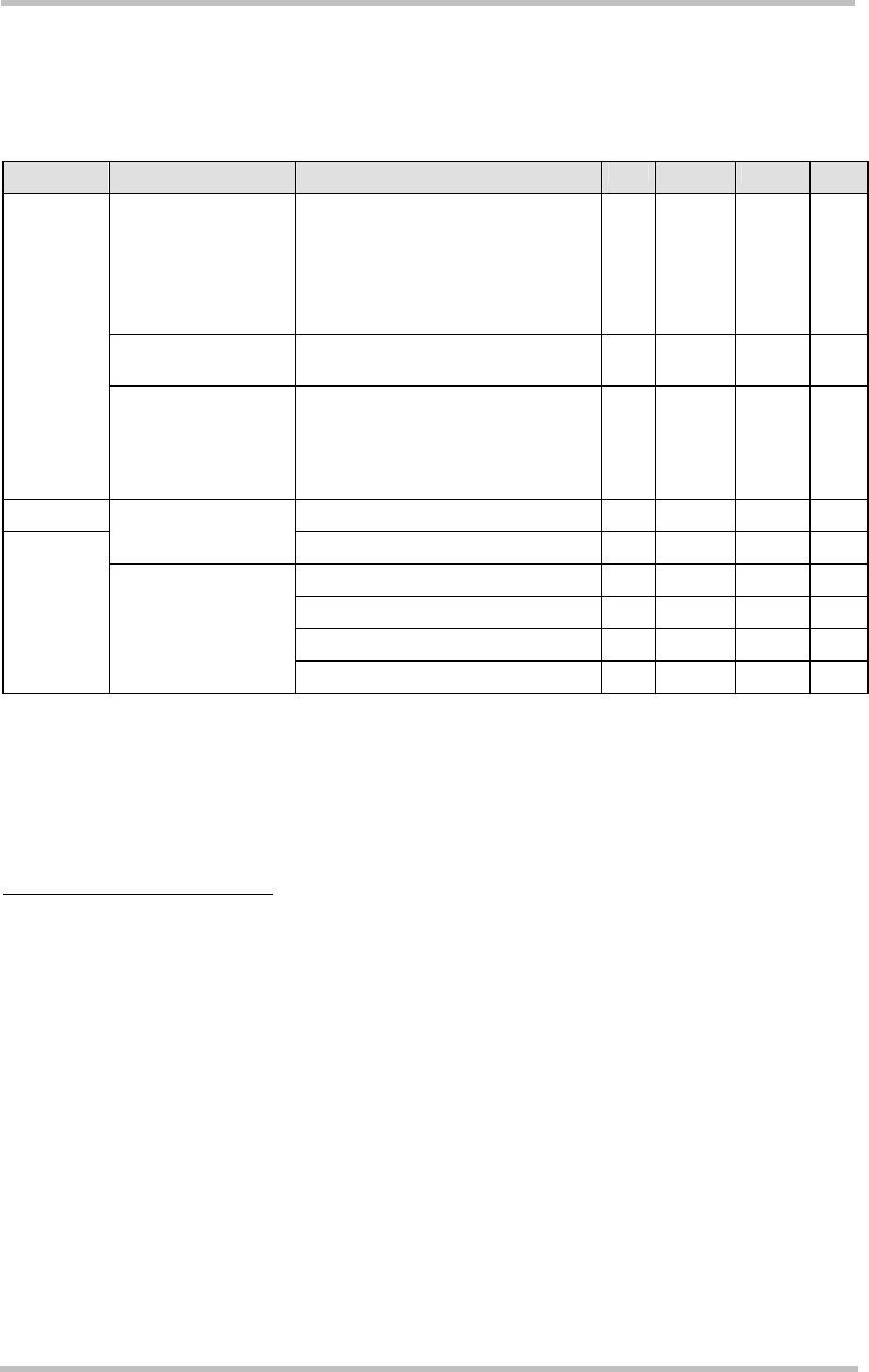
AC65/AC75 Hardware Interface Description
Confidential / Preliminary s
AC65/AC75_hd_v00.372 Page 93 of 118 2006-08-03
5.6 Power Supply Ratings
Table 27: Power supply ratings
Parameter Description Conditions Min Typ Max Unit
Supply voltage Directly measured at reference point
TP BATT+ and TP GND, see chapter
3.2.2
Voltage must stay within the min/max
values, including voltage drop, ripple,
spikes.
3.3 3.8 4.5 V
Voltage drop during
transmit burst
Normal condition, power control level
for Pout max
400 mV
BATT+
Voltage ripple Normal condition, power control level
for Pout max
@ f<200kHz
@ f>200kHz
50
2
mV
mV
IVDDLP RTC Backup @ BATT+ = 0V 25 µA OFF State
supply current POWER DOWN mode7 50 100 µA
SLEEP mode @ DRX = 9 3.7 9 mA
SLEEP mode @ DRX = 5 4.6 9 mA
SLEEP mode @ DRX = 2 7.0 9 mA
IBATT+
Average standby
supply current8
IDLE mode @ DRX = 2 28 10 mA
7 Measured after module INIT (switch ON the module and following switch OFF); applied voltage on BATT+ (w/o
INIT) show increased POWER DOWN supply current.
8 Additional conditions:
- SLEEP and IDLE mode measurements started 5 minutes after switching ON the module or after mode
transition
- Averaging times: SLEEP mode - 3 minutes; IDLE mode - 1.5 minutes
- Communication tester settings: no neighbor cells, no cell reselection
- USB interface disabled
9 Stated value applies to operation without autobauding (AT+IPR0).
10 Stated value applies to operation without autobauding (AT+IPR0). If autobauding is enabled (AT+IPR=0)
average current consumption in IDLE mode is up to 43mA.
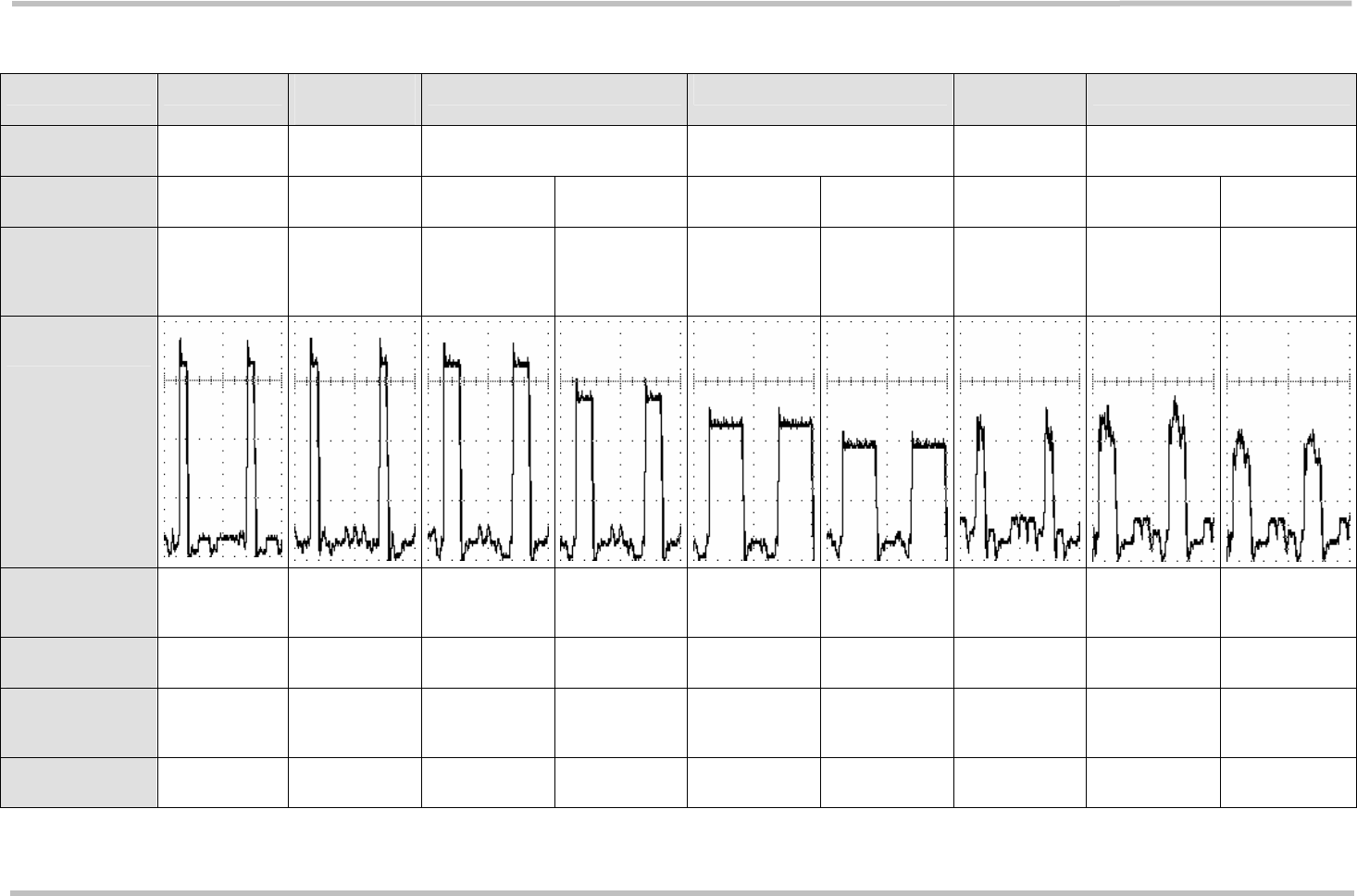
AC65/AC75 Hardware Interface Description
Confidential / Preliminary s
AC65/AC75_hd_v00.372 Page 94 of 118 2006-08-03
Table 28: Current consumption during Tx burst for GSM 850MHz and GSM 900MHz
Mode GSM call GPRS
Class 8
GPRS Class10 GPRS Class 12 EGPRS
Class 8
EGPRS Class 10
Timeslot
configuration
1Tx / 1Rx 1Tx / 4Rx 2Tx / 3Rx 4Tx / 1Rx 1Tx / 4Rx 2Tx / 3Rx
RF power nominal 2W
(33dBm)
2W
(33dBm)
2W
(33dBm)
1W
(30dBm)
1W
(30dBm)
0.5W
(27dBm)
0.5W
(27dBm)
0.5W
(27dBm)
0.25W
(24dBm)
Radio output power
reduction with
AT^SCFG,
parameter <ropr>
<ropr> = 1 ... 3
<ropr> = 1 ... 3
<ropr> = 1
<ropr> = 2 or 3
<ropr> = 1
<ropr> = 2 or 3
<ropr> = 1 ... 3
<ropr> = 1 or 2
<ropr> = 3
Current
characteristics
Burst current
@ 50 antenna
(typ.)
1.75A 1.75A 1.75A 1.48A 1.26A 1.1A 1.4A peak
1.2A plateau
1.4A peak
1.2A plateau
1.1A peak
1.0A plateau
Burst current
@ total mismatch
3.2A 3.2A 3.2A 2.7A 2.3A 1.9A 1.8A peak
1.5A plateau
1.8A peak
1.5A plateau
1.4A peak
1.2A plateau
Average current
@ 50 antenna
(typ.)
330mA 360mA 540mA 475mA 680mA 600mA 370mA 450mA 400mA
Average current
@ total mismatch
510mA 540mA 905mA 780mA 1200mA 1000mA 395mA 525mA 450mA
AT parameters are given in brackets <...> and marked italic.
Statements on EGPRS apply to AC75 only.
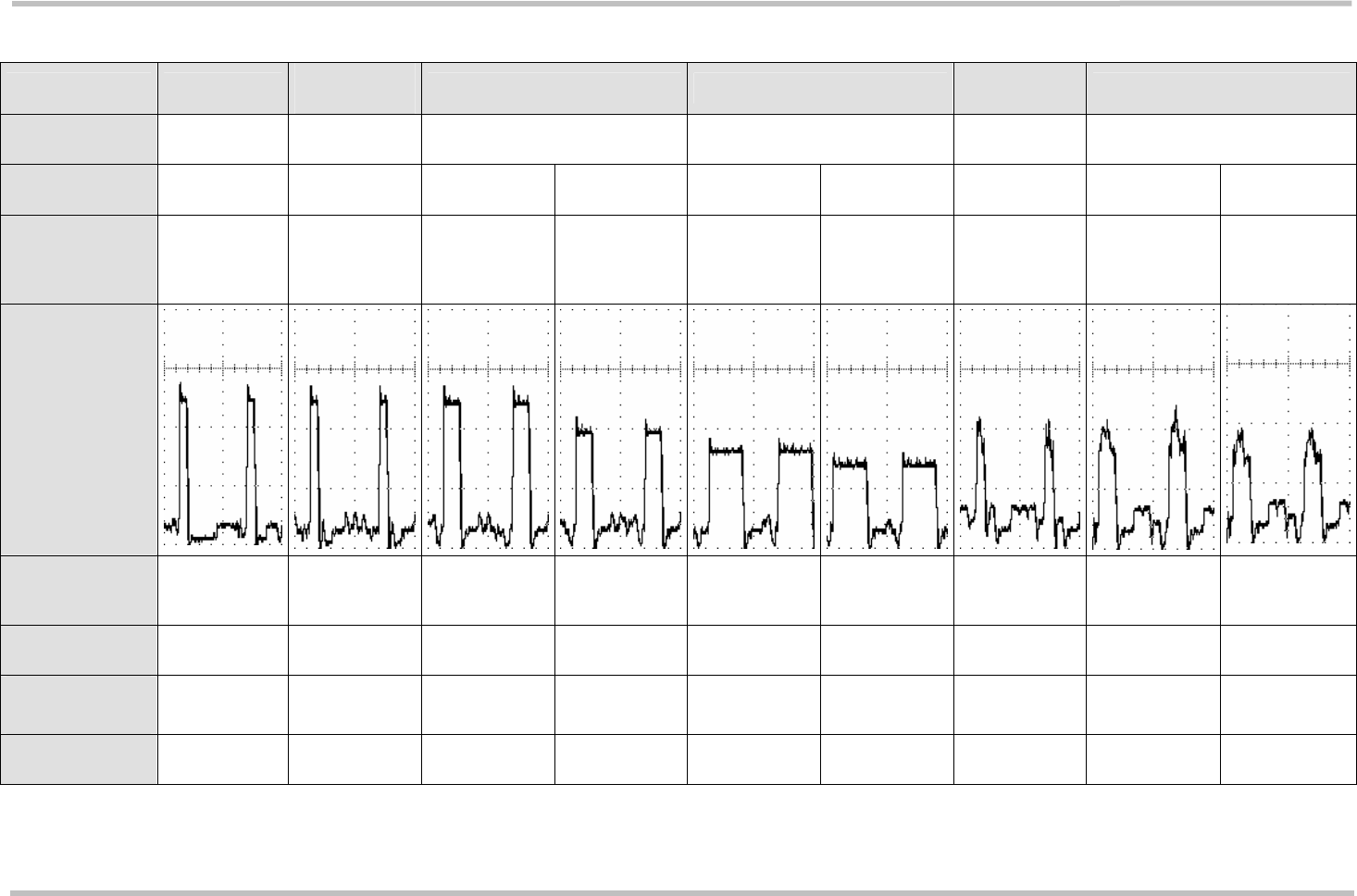
AC65/AC75 Hardware Interface Description
Confidential / Preliminary s
AC65/AC75_hd_v00.372 Page 95 of 118 2006-08-03
Table 29: Current consumption during Tx burst for GSM 1800MHz and GSM 1900MHz
Mode GSM call GPRS
Class 8 GPRS Class10 GPRS Class 12 EGPRS
Class 8 EGPRS Class 10
Timeslot
configuration 1Tx / 1Rx 1Tx / 4Rx 2Tx / 3Rx 4Tx / 1Rx 1Tx / 4Rx 2Tx / 3Rx
RF power nominal 1W
(30dBm)
1W
(30dBm)
1W
(30dBm)
0.5W
(27dBm)
0.5W
(27dBm)
0.25W
(24dBm)
0.4W
(26dBm)
0.4W
(26dBm)
0.2W
(23dBm)
Radio output power
reduction with
AT^SCFG,
parameter <ropr>
<ropr> = 1 ... 3
<ropr> = 1 ... 3
<ropr> = 1
<ropr> = 2 or 3
<ropr> = 1
<ropr> = 2 or 3
<ropr> = 1 ... 3
<ropr> = 1 or 2
<ropr> = 3
Current
characteristics
Burst current
@ 50 antenna
(typ.)
1.3A 1.3A 1.3A 1.1A 0.95A 0.85A 1.0A peak
0.9A plateau
1.0A peak
0.9A plateau
0.9A peak
0.75A plateau
Burst current
@ total mismatch
2.2A 2.2A 2.2A 1.75A 1.5A 1.25A 1.3A peak
1.0A plateau
1.3A peak
1.0A plateau
1.1A peak
0.95A plateau
Average current
@ 50 antenna
(typ.)
295mA 330mA 430mA 380mA 520mA 470mA 360mA 445mA 420mA
Average current
@ total mismatch
360mA 395mA 650mA 540mA 800mA 670mA 410mA 545mA 470mA
AT parameters are given in brackets <...> and marked italic.
Statements on EGPRS apply to AC75 only.

AC65/AC75 Hardware Interface Description
Confidential / Preliminary s
AC65/AC75_hd_v00.372 Page 96 of 118 2006-08-03
5.7 Electrical Characteristics of the Voiceband Part
5.7.1 Setting Audio Parameters by AT Commands
The audio modes 2 to 6 can be adjusted according to the parameters listed below. Each
audio mode is assigned a separate set of parameters.
Table 30: Audio parameters adjustable by AT command
Parameter Influence to Range Gain range Calculation
inBbcGain MICP/MICN analogue amplifier gain of
baseband controller before ADC
0...7 0...42dB 6dB steps
inCalibrate Digital attenuation of input signal after
ADC
0...32767 -...0dB 20 * log (inCalibrate/
32768)
outBbcGain EPP/EPN analogue output gain of
baseband controller after DAC
0...3 0...-18dB 6dB steps
outCalibrate[n]
n = 0...4
Digital attenuation of output signal after
speech decoder, before summation of
sidetone and DAC
Present for each volume step[n]
0...32767 -...+6dB 20 * log (2 *
outCalibrate[n]/
32768)
sideTone Digital attenuation of sidetone
Is corrected internally by outBbcGain to
obtain a constant sidetone independent
of output volume
0...32767 -...0dB 20 * log (sideTone/
32768)
Note: The parameters outCalibrate and sideTone accept also values from 32768 to 65535.
These values are internally truncated to 32767.
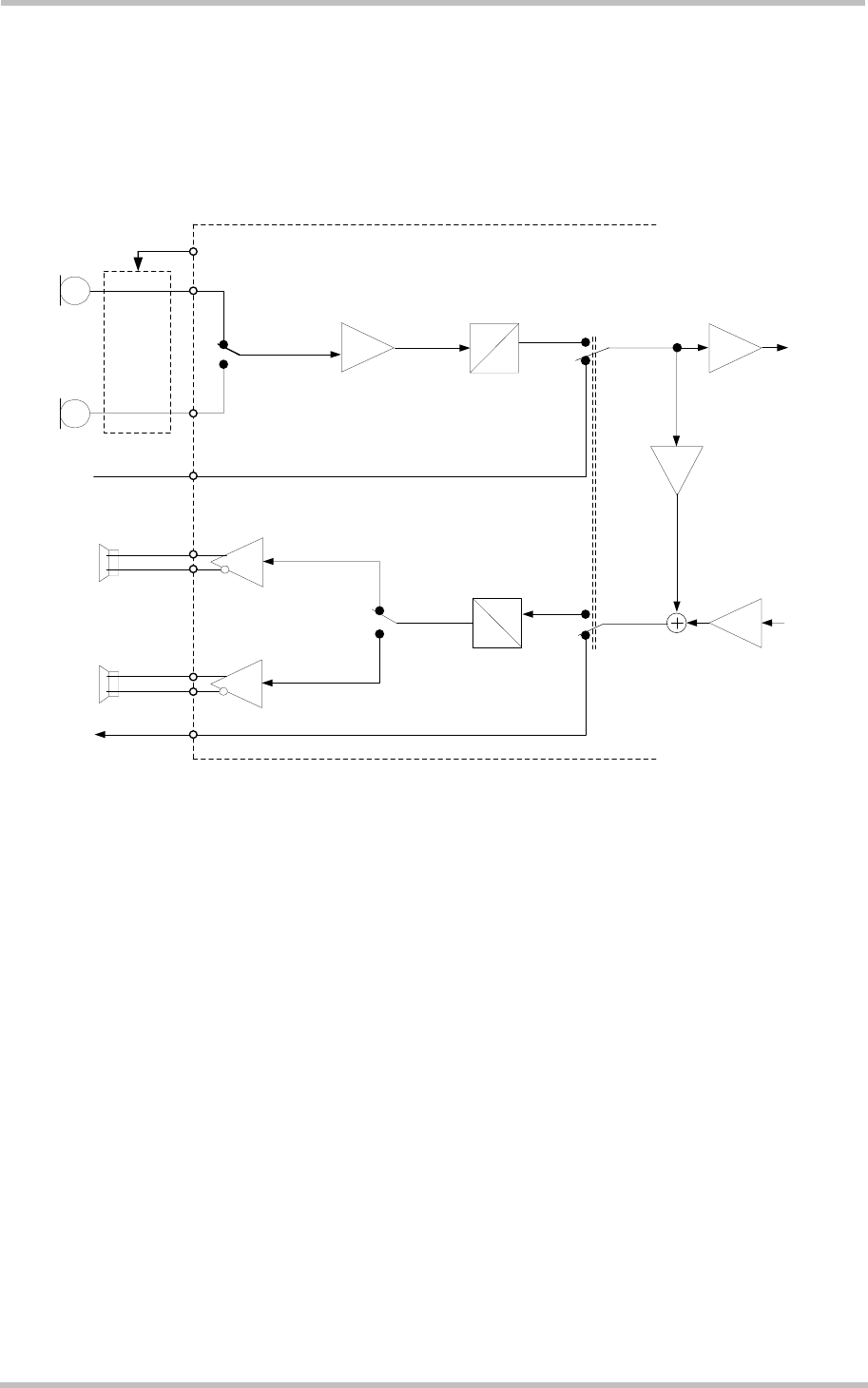
AC65/AC75 Hardware Interface Description
Confidential / Preliminary s
AC65/AC75_hd_v00.372 Page 97 of 118 2006-08-03
5.7.2 Audio Programming Model
The audio programming model shows how the signal path can be influenced by varying the
AT command parameters. The parameters inBbcGain and inCalibrate can be set with
AT^SNFI. All the other parameters are adjusted with AT^SNFO.
Figure 41: Audio programming model
<mic>
Microphone
feeding
A
D
Speech
coder
<sideTone>
MIC1
MIC2
A
DSpeech
decoder
TXDDAI
RXDDAI
8Ohms
EP1
EP2
32 Ohms
GSM module
<ep>
VMIC
<io>
<inBbcGain> <inCalibrate>
<outCalibrate [n]>
<outBbcGain>
AT parameters are given in brackets <...>
and marked red and italic.

AC65/AC75 Hardware Interface Description
Confidential / Preliminary s
AC65/AC75_hd_v00.372 Page 98 of 118 2006-08-03
5.7.3 Characteristics of Audio Modes
The electrical characteristics of the voiceband part depend on the current audio mode set
with the AT^SNFS command. All values are noted for default gains e.g. all parameters of
AT^SNFI and AT^SNFO are left unchanged.
Table 31: Voiceband characteristics (typical)
Audio mode no.
AT^SNFS=
1 (Default
settings, not
adjustable)
2 3 4 5 6
Name Default
Handset
Basic
Handsfree
Headset User
Handset
Plain
Codec 1
Plain
Codec 2
Purpose DSB with
Votronic
handset
Siemens
Car Kit
Portable
Siemens
Headset
DSB with
individual
handset
Direct access
to speech
coder
Direct access
to speech
coder
Gain setting via AT
command. Defaults:
inBbcGain
outBbcGain
Fix
5 (30dB)
1 (-6dB)
Adjustable
2 (12dB)
2 (-12dB)
Adjustable
5 (30dB)
1 (-6dB)
Adjustable
5 (30dB)
1 (-6dB)
Adjustable
0 (0dB)
0 (0dB)
Adjustable
0 (0dB)
0 (0dB)
Default audio
interface
1 2 2 1 1 2
11
Power supply VMIC ON ON ON ON ON ON
Sidetone Fix --- Adjustable Adjustable Adjustable Adjustable
Volume control Fix Adjustable Adjustable Adjustable Adjustable Adjustable
Echo control
Echo canceller ON ON ON ON OFF OFF
Loss controller
idle/full attenuation
3dB / 6dB 4dB / 50dB 9dB / 18dB 3dB / 6dB OFF OFF
Comfort noise
generator
ON ON ON ON OFF OFF
Non linear processor ON ON ON ON OFF OFF
MIC input signal for
0dBm0
-10dBm0
f=1024 Hz
18mV
5.8mV
---12
95mV
---12
14mV
18mV
5.8mV
400mV
126mV
400mV
126mV
EP output signal in
mV rms. @ 0dBm0,
1024 Hz, no load
(default gain) /
@ 3.14 dBm0
475mV 70mV
default @
max volume
270mV
default @
max volume
475mV
default @
max volume
1.47V
Vpp = 6.2 V
1.47V
Sidetone gain at
default settings
21.9dB - dB 10.0dB 21.9dB - dB - dB
NOTE: With regard to acoustic shock, the cellular application must be designed to avoid
sending false AT commands that might increase amplification, e.g. for a highly sensitive
earpiece. A protection circuit should be implemented in the cellular application.
11 Audio mode 5 and 6 are identical. AT^SAIC can be used to switch mode 5 to the second interface. Audio mode
6 is therefore kept mainly for compatibility to earlier Siemens GSM products.
12 In audio modes with an active loss controller a continuous sine signal is attenuated by the idle attenuation after
a few seconds. All input voltages are noted for the idle attenuation. If the idle attenuation is higher than 3 dB,
0dBm0 cannot be reached without clipping. In this case only the value for -10dBm0 is noted.

AC65/AC75 Hardware Interface Description
Confidential / Preliminary s
AC65/AC75_hd_v00.372 Page 99 of 118 2006-08-03
5.7.4 Voiceband Receive Path
Test conditions:
• The values specified below were tested to 1kHz with default audio mode settings, unless
otherwise stated.
• Default audio mode settings are: mode=5 for EPP1 to EPN1 and mode=6 for EPP2 to
EPN2, inBbcGain=0, inCalibrate=32767, outBbcGain=0, OutCalibrate=16384 (volume=4)
or OutCalibrate=11585 (volume=3), sideTone=0.
Table 32: Voiceband receive path
Parameter Min Typ Max Unit Test condition / remark
Maximum differential
output voltage (peak to
peak)
EPP1 to EPN1
6.0
6.2
V
V
8 ,
no load,
Audio Mode 5, Volume 4
@ 3.14 dBm0 (Full Scale)
Batt+ = 3.6V
Maximum differential
output voltage (peak to
peak)
EPP2 to EPN2
4.0
4.2
V
V
32 ,
no load
Audio Mode 6, Volume 313
@ 3.14 dBm0 (Full Scale)
Nominal differential output
voltage (peak to peak)
EPP1 to EPN1
4.2
4.3
V
V
8 ,
no load,
Audio Mode 5, Volume 4
@ 0 dBm0 (Nominal level)
Nominal differential output
voltage (peak to peak)
EPP1 to EPN1
2.8
2.9
V
V
32 ,
no load
Audio Mode 6, Volume 313
@ 0 dBm0 (Nominal level)
Output bias voltage Batt+/2 V from EPP1 or EPN1 to AGND
Output bias voltage 1.2 V from EPP2 or EPN2 to AGND
Differential output gain
settings (gs) at 6dB stages
(outBbcGain)
-18 0 dB Set with AT^SNFO
Fine scaling by DSP
(outCalibrate)
- 0 dB Set with AT^SNFO
Differential output load
resistance
7.5 8 From EPP1 to EPN1
Differential output load
resistance
27 32 From EPP2 to EPN2
Single ended output load
resistance
7.5 8 From EPP1 or EPN1 to AGND
Single ended output load
resistance
27 32 From EPP2 or EPN2 to AGND
Absolute gain error -0.1 0.1 dB outBbcGain=2
Idle channel noise14 -83 -75 dBm0p outBbcGain=2
Signal to noise and
distortion15
47 dB outBbcGain=2
13 Full scale of EPP2/EPN2 is lower than full scale of EPP1/EPN1 but the default gain is the same. 3.14dBm0 will
lead to clipping if the default gain is used.
14 The idle channel noise was measured with digital zero signal fed to decoder. This can be realized by setting
outCalibrate and sideTone to 0 during a call.
15 The test signal is a 1 kHz, 0 dbm0 sine wave.

AC65/AC75 Hardware Interface Description
Confidential / Preliminary s
AC65/AC75_hd_v00.372 Page 100 of 118 2006-08-03
Parameter Min Typ Max Unit Test condition / remark
Frequency Response16
0Hz - 100Hz
200Hz
300Hz - 3350Hz
3400Hz
4000Hz
4400Hz
-0.2
-1.1
-0.7
-39
-34
0.1
-75
dB
gs = gain setting
5.7.5 Voiceband Transmit Path
Test conditions:
• The values specified below were tested to 1kHz and default settings of audio modes,
unless otherwise stated.
• Parameter setup: Audio mode=5 for MICP1 to MICN1 and 6 for MICP2 to MICN2,
inBbcGain=0, inCalibrate=32767, outBbcGain=0, OutCalibrate=16384, sideTone=0
Table 33: Voiceband transmit path
Parameter Min Typ Max Unit Test condition / Remark
Full scale input voltage (peak to peak)
for 3.14dBm0
MICP1 to MICN1 or AGND, MICP2 to
MICN2 or AGND
1.6 V
MICPx must be biased with
1.25V (VMIC/2)
Nominal input voltage (peak to peak)
for 0dBm0
MICP1 to MICN1 or AGND, MICP2 to
MICN2 or AGND
1.1 V
MICPx must be biased with
1.25V (VMIC/2)
Input amplifier gain in 6dB steps
(inBbcGain)
0 42 dB Set with AT^SNFI
Fine scaling by DSP (inCalibrate) - 0 dB Set with AT^SNFI
Microphone supply voltage VMIC 2.4 2.5 2.6 V
VMIC current 2 mA
Idle channel noise -82 -76 dBm0p
Signal to noise and distortion 70 77 dB
Frequency response16
0Hz - 100Hz
200Hz
300Hz - 3350Hz
3400Hz
4000Hz
4400Hz
-0.2
-1.1
-0.7
-39
-34
0.1
-75
dB
16 This is the frequency response from a highpass and lowpass filter combination in the DAC of the baseband chip
set. If the PCM interface is used, this filter is not involved in the audio path. Audio mode 1 to 4 incorporate
additional frequency response correction filters in the digital signal processing unit and are adjusted to their
dedicated audio devices (see Table 31).

AC65/AC75 Hardware Interface Description
Confidential / Preliminary s
AC65/AC75_hd_v00.372 Page 101 of 118 2006-08-03
5.8 Air Interface
Test conditions: All measurements have been performed at Tamb= 25°C, VBATT+ nom = 4.0V.
The reference points used on AC65/AC75 are the BATT+ and GND contacts (test points are
shown in Figure 4).
Table 34: Air Interface
Parameter Min Typ Max Unit
GSM 850 824 849 MHz
E-GSM 900 880 915 MHz
GSM 1800 1710 1785 MHz
Frequency range
Uplink (MS → BTS)
GSM 1900 1850 1910 MHz
GSM 850 869 894 MHz
E-GSM 900 925 960 MHz
GSM 1800 1805 1880 MHz
Frequency range
Downlink (BTS → MS)
GSM 1900 1930 1990 MHz
GSM 850 31 33 35 dBm
E-GSM 90017 31 33 35 dBm
GSM 180018 28 30 32 dBm
RF power @ ARP with 50 load
GSM 1900 28 30 32 dBm
GSM 850 124
E-GSM 900 174
GSM 1800 374
Number of carriers
GSM 1900 299
GSM 850 45 MHz
E-GSM 900 45 MHz
GSM 1800 95 MHz
Duplex spacing
GSM 1900 80 MHz
Carrier spacing 200 kHz
Multiplex, Duplex TDMA / FDMA, FDD
Time slots per TDMA frame 8
Frame duration 4.615 ms
Time slot duration 577 µs
Modulation GMSK
GSM 850 -102 -108 dBm
E-GSM 900 -102 -108 dBm
GSM 1800 -102 -107 dBm
Receiver input sensitivity @ ARP
BER Class II < 2.4% (static input level)
GSM 1900 -102 -107 dBm
17 Power control level PCL 5
18 Power control level PCL 0
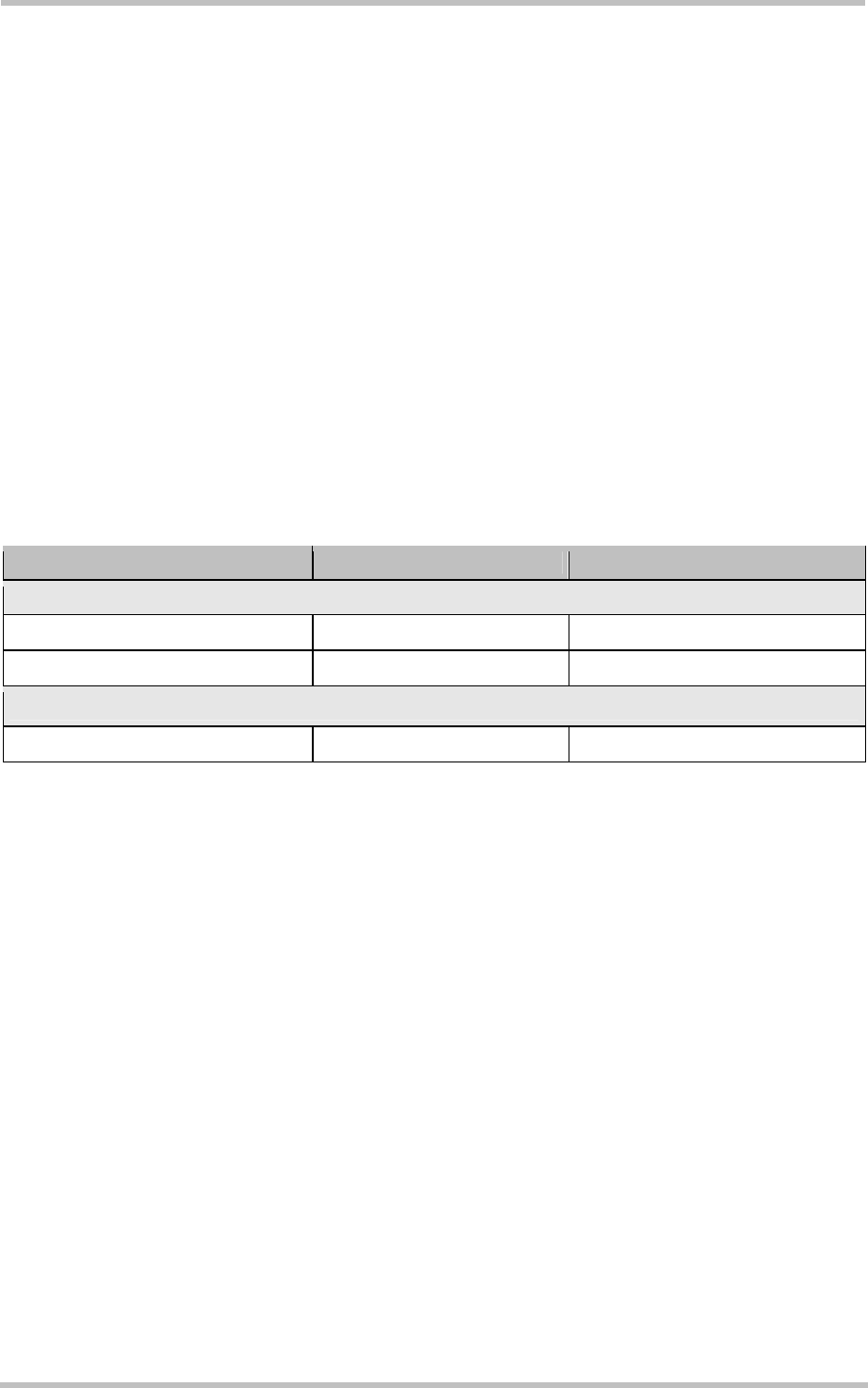
AC65/AC75 Hardware Interface Description
Confidential / Preliminary s
AC65/AC75_hd_v00.372 Page 102 of 118 2006-08-03
5.9 Electrostatic Discharge
The GSM engine is not protected against Electrostatic Discharge (ESD) in general.
Consequently, it is subject to ESD handling precautions that typically apply to ESD sensitive
components. Proper ESD handling and packaging procedures must be applied throughout
the processing, handling and operation of any application that incorporates a AC65/AC75
module.
Special ESD protection provided on AC65/AC75:
Antenna interface: one spark discharge line (spark gap)
SIM interface: clamp diodes for protection against overvoltage.
The remaining ports of AC65/AC75 are not accessible to the user of the final product (since
they are installed within the device) and therefore, are only protected according to the
“Human Body Model” requirements.
AC65/AC75 has been tested according to the EN 61000-4-2 standard. The measured values
can be gathered from the following table.
Table 35: Measured electrostatic values
Specification / Requirements Contact discharge Air discharge
ETSI EN 301 489-7
ESD at SIM port ± 4kV ± 8kV
ESD at antenna port ± 4kV ± 8kV
Human Body Model (Test conditions: 1.5kΩ, 100pF)
ESD at all other interfaces ± 1kV ± 1kV
Note: Please note that the values may vary with the individual application design. For
example, it matters whether or not the application platform is grounded over external
devices like a computer or other equipment, such as the Siemens reference
application described in Chapter 8.
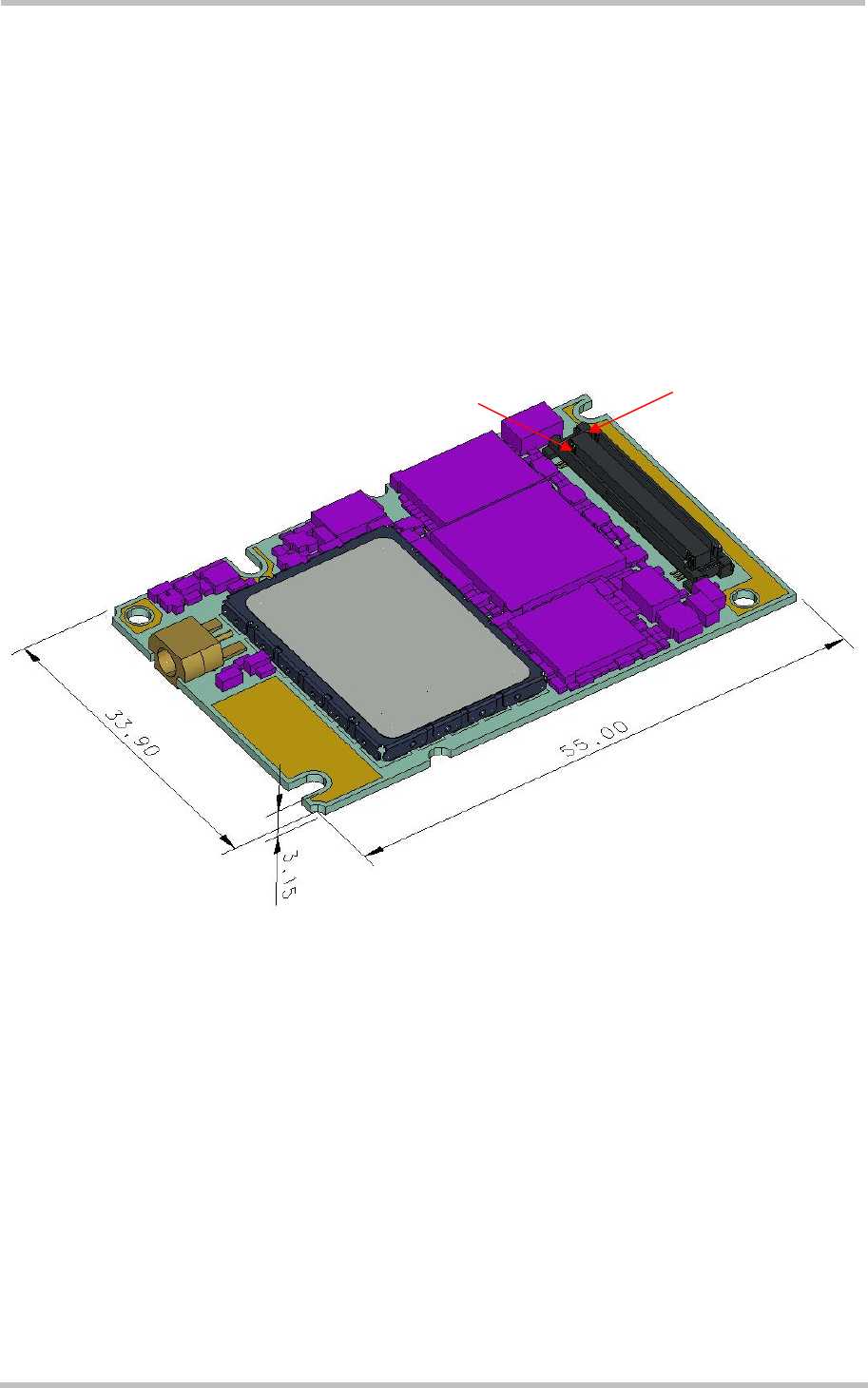
AC65/AC75 Hardware Interface Description
Confidential / Preliminary s
AC65/AC75_hd_v00.372 Page 103 of 118 2006-08-03
6 Mechanics
6.1 Mechanical Dimensions of AC65/AC75
Figure 42 shows the top view of AC65/AC75 and provides an overview of the board's
mechanical dimensions. For further details see Figure 43.
Length: 55.00mm
Width: 33.90mm
Height: 3.15mm
Figure 42: AC65/AC75 – top view
Pin 80
Pin 1
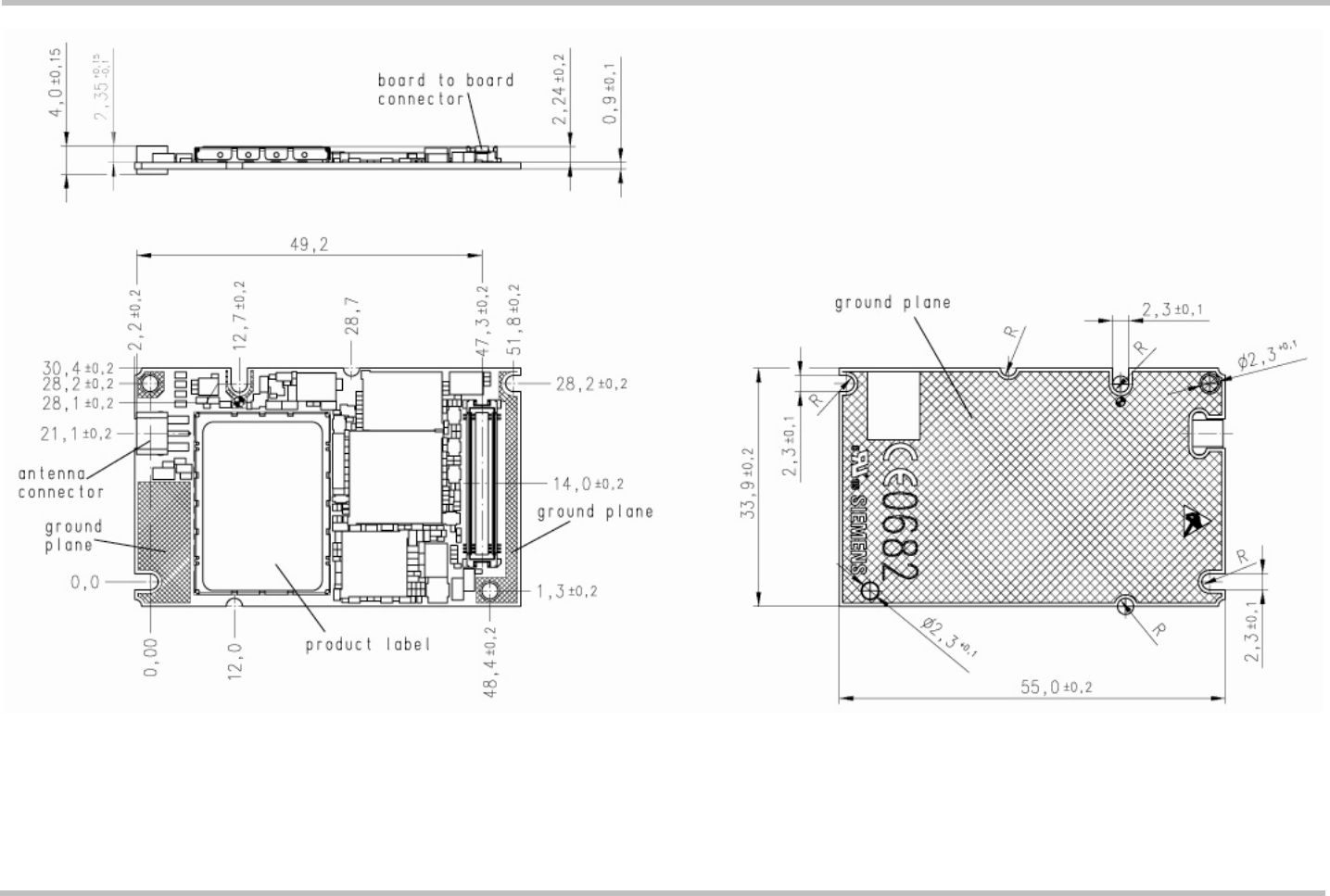
AC65/AC75 Hardware Interface Description
Confidential / Preliminary s
AC65/AC75_hd_v00.372 Page 104 of 118 2006-08-03
All dimensions in mm
Figure 43: Dimensions of AC65/AC75

AC65/AC75 Hardware Interface Description
Confidential / Preliminary s
AC65/AC75_hd_v00.372 Page 105 of 118 2006-08-03
6.2 Mounting AC65/AC75 to the Application Platform
There are many ways to properly install AC65/AC75 in the host device. An efficient approach
is to mount the AC65/AC75 PCB to a frame, plate, rack or chassis.
Fasteners can be M2 screws plus suitable washers, circuit board spacers, or customized
screws, clamps, or brackets. In addition, the board-to-board connection can also be utilized
to achieve better support. To help you find appropriate spacers a list of selected screws and
distance sleeves for 3mm stacking height can be found in Chapter 9.2.
When using the two small holes take care that the screws are inserted with the screw head
on the bottom of the AC65/AC75 PCB. Screws for the large holes can be inserted from top or
bottom.
For proper grounding it is strongly recommended to use large ground plane on the bottom of
board in addition to the five GND pins of the board-to-board connector. The ground plane
may also be used to attach cooling elements, e.g. a heat sink or thermally conductive tape.
To prevent mechanical damage, be careful not to force, bend or twist the module. Be sure it
is positioned flat against the host device.
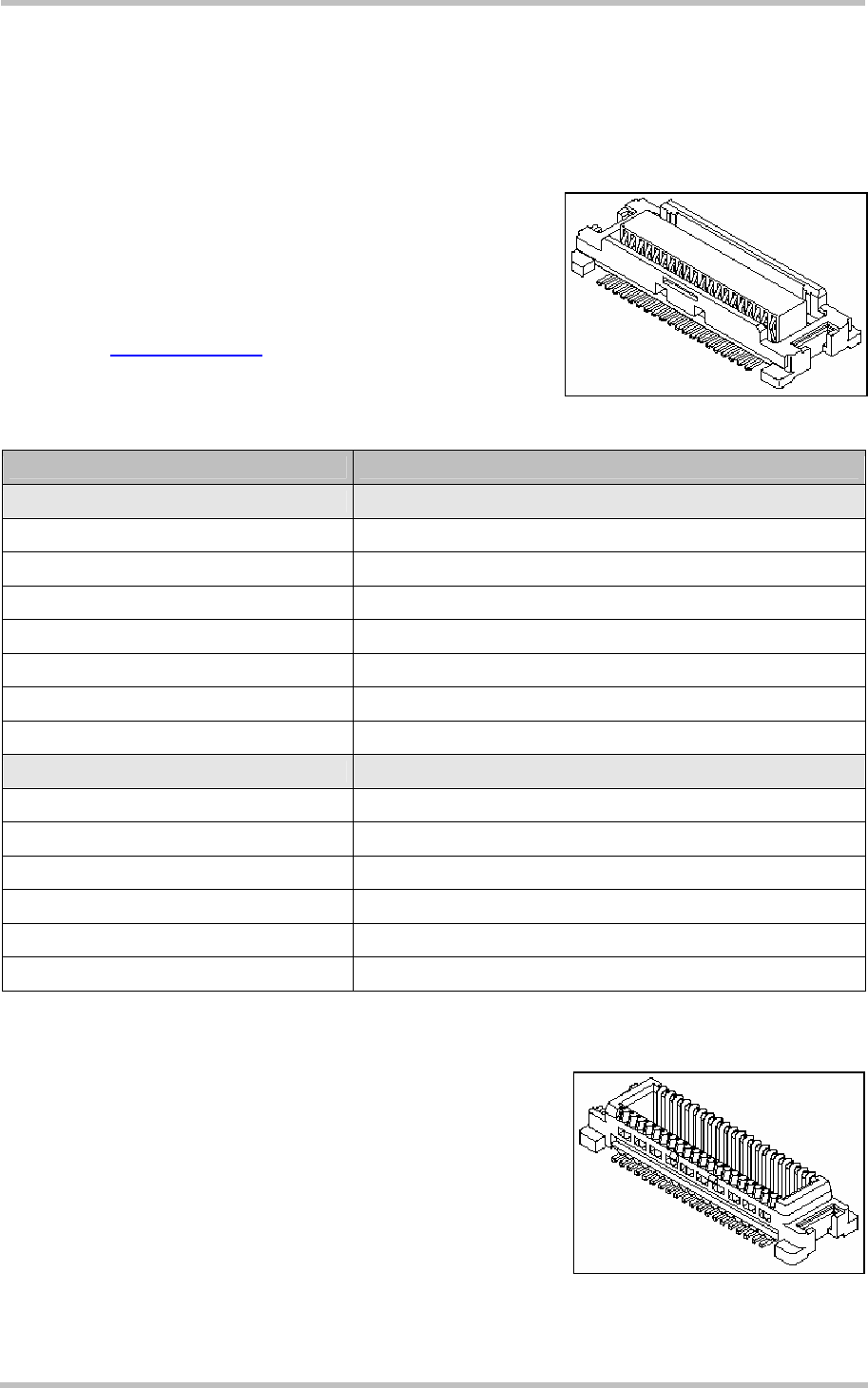
AC65/AC75 Hardware Interface Description
Confidential / Preliminary s
AC65/AC75_hd_v00.372 Page 106 of 118 2006-08-03
6.3 Board-to-Board Application Connector
This section provides the specifications of the 80-pin board-to-board connector used to
connect AC65/AC75 to the external application.
Connector mounted on the AC65/AC75 module:
Type: 52991-0808 SlimStack Receptacle
80 pins, 0.50mm pitch,
for stacking heights from 3.0 to 4.0mm,
see Figure 44 for details.
Supplier: Molex
www.molex.com
Table 36: Technical specifications of Molex board-to-board connector
Parameter Specification (80-pin B2B connector)
Electrical
Number of Contacts 80
Contact spacing 0.5mm (.020")
Voltage 50V
Rated current 0.5A max per contact
Contact resistance 50m max per contact
Insulation resistance > 100M
Dielectric Withstanding Voltage 500V AC (for 1 minute)
Physical
Insulator material (housing) White glass-filled LCP plastic, flammability UL 94V 0
Contact material Plating: Gold over nickel
Insertion force 1st < 74.4N
Insertion force 30th < 65.6N
Withdrawal force 1st > 10.8N
Maximum connection cycles 30 (@ 70m max per contact)
Mating connector types for the customer's application
offered by Molex:
• 53748-0808 SlimStack Plug, 3mm stacking height,
see Figure 45 for details.
• 53916-0808 SlimStack Plug, 4mm stacking height
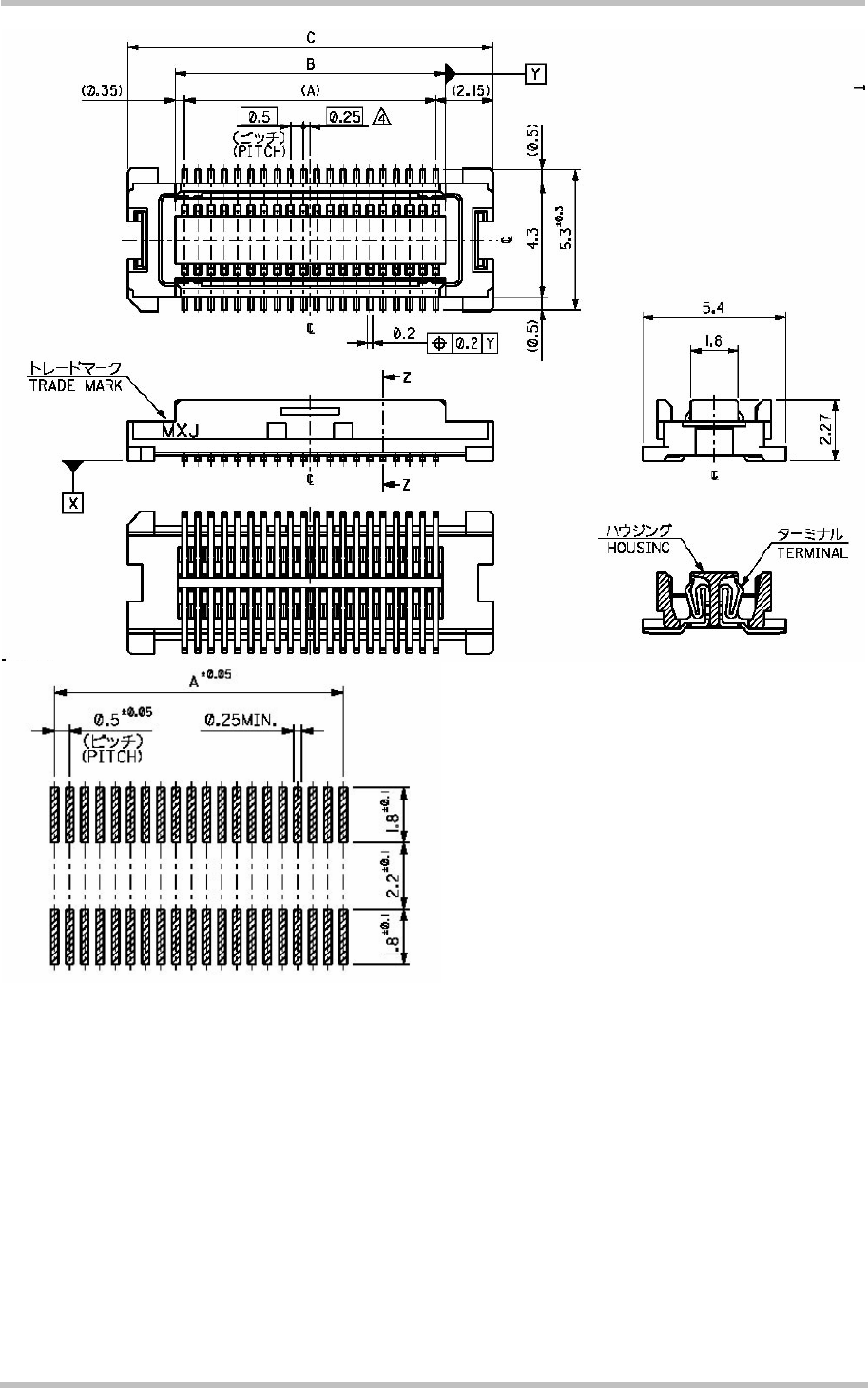
AC65/AC75 Hardware Interface Description
Confidential / Preliminary s
AC65/AC75_hd_v00.372 Page 107 of 118 2006-08-03
Figure 44: Molex board-to-board connector 52991-0808 on AC65/AC75
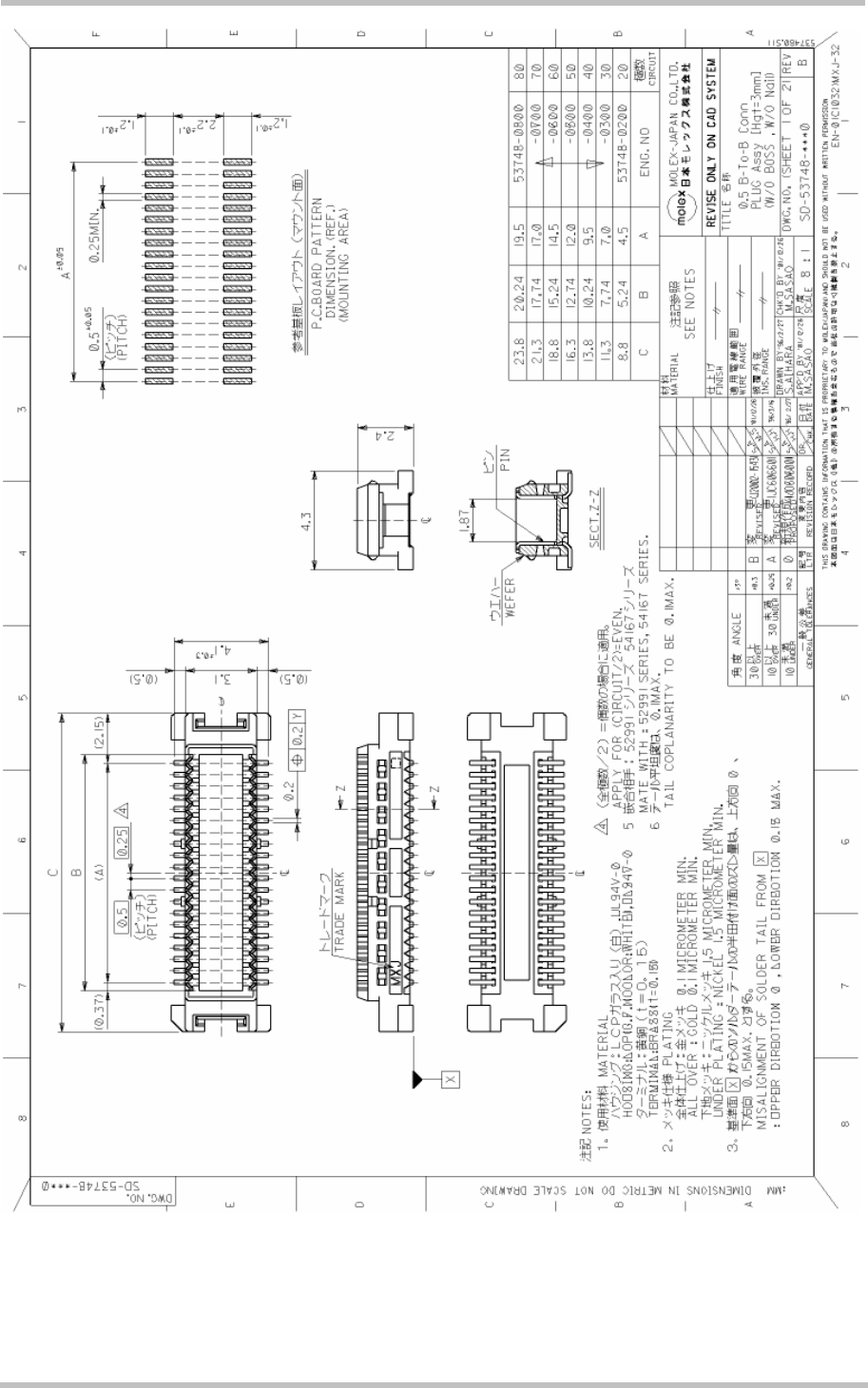
AC65/AC75 Hardware Interface Description
Confidential / Preliminary s
AC65/AC75_hd_v00.372 Page 108 of 118 2006-08-03
Figure 45: Mating board-to-board connector 53748-0808 on application

AC65/AC75 Hardware Interface Description
Confidential / Preliminary s
AC65/AC75_hd_v00.372 Page 109 of 118 2006-08-03
7 Sample Application
Figure 46 shows a typical example of how to integrate a AC65/AC75 module with a Java
application. Usage of the various host interfaces depends on the desired features of the
application.
Audio interface 1 demonstrates the balanced connection of microphone and earpiece. This
solution is particularly well suited for internal transducers. Audio interface 2 uses an
unbalanced microphone and earpiece connection typically found in headset applications.
The charging circuit is optimized for the charging stages (trickle charging and software
controlled charging) as well as the battery and charger specifications described in Chapter
3.5.
The PWR_IND line is an open collector that needs an external pull-up resistor which
connects to the voltage supply VCC µC of the microcontroller. Low state of the open collector
pulls the PWR_IND signal low and indicates that the AC65/AC75 module is active, high level
notifies the Power-down mode.
If the module is in Power-down mode avoid current flowing from any other source into the
module circuit, for example reverse current from high state external control lines. Therefore,
the controlling application must be designed to prevent reverse flow.
If the I2C bus is active the two lines I2CCLK and I2DAT are locked for use as SPI lines. Vice
versa, the activation of the SPI locks both lines for I2C. Settings for either interface are made
by using the AT^SSPI command.
The internal pull-up resistors (Rp) of the I2C interface can be connected to an external power
supply or to the VEXT line of AC65/AC75. The advantage of using VEXT is that when the
module enters the Power-down mode, the I2CI interface is shut down as well. If you prefer to
connect the resistors to an external power supply, take care that the interface is shut down
when the PWR_IND signal goes high in Power-down mode.
The interfaces ASC0, ASC1 and USB have different functions depending on whether or not
Java is running. Without Java, all of them are used as AT interfaces. When a Java
application is started, ASC0 and ASC1 can be used for CommConnection or/and
System.out, and the USB lines can be used for debugging or System.out.
The EMC measures are best practice recommendations. In fact, an adequate EMC strategy
for an individual application is very much determined by the overall layout and, especially,
the position of components. For example, mounting the internal acoustic transducers directly
on the PCB eliminates the need to use the ferrite beads shown in the sample schematic.
However, when connecting cables to the module’s interfaces it is strongly recommended to
add appropriate ferrite beads for reducing RF radiation.
Disclaimer
No warranty, either stated or implied, is provided on the sample schematic diagram shown in
Figure 46 and the information detailed in this section. As functionality and compliance with
national regulations depend to a great amount on the used electronic components and the
individual application layout manufacturers are required to ensure adequate design and
operating safeguards for their products using AC65/AC75 modules.
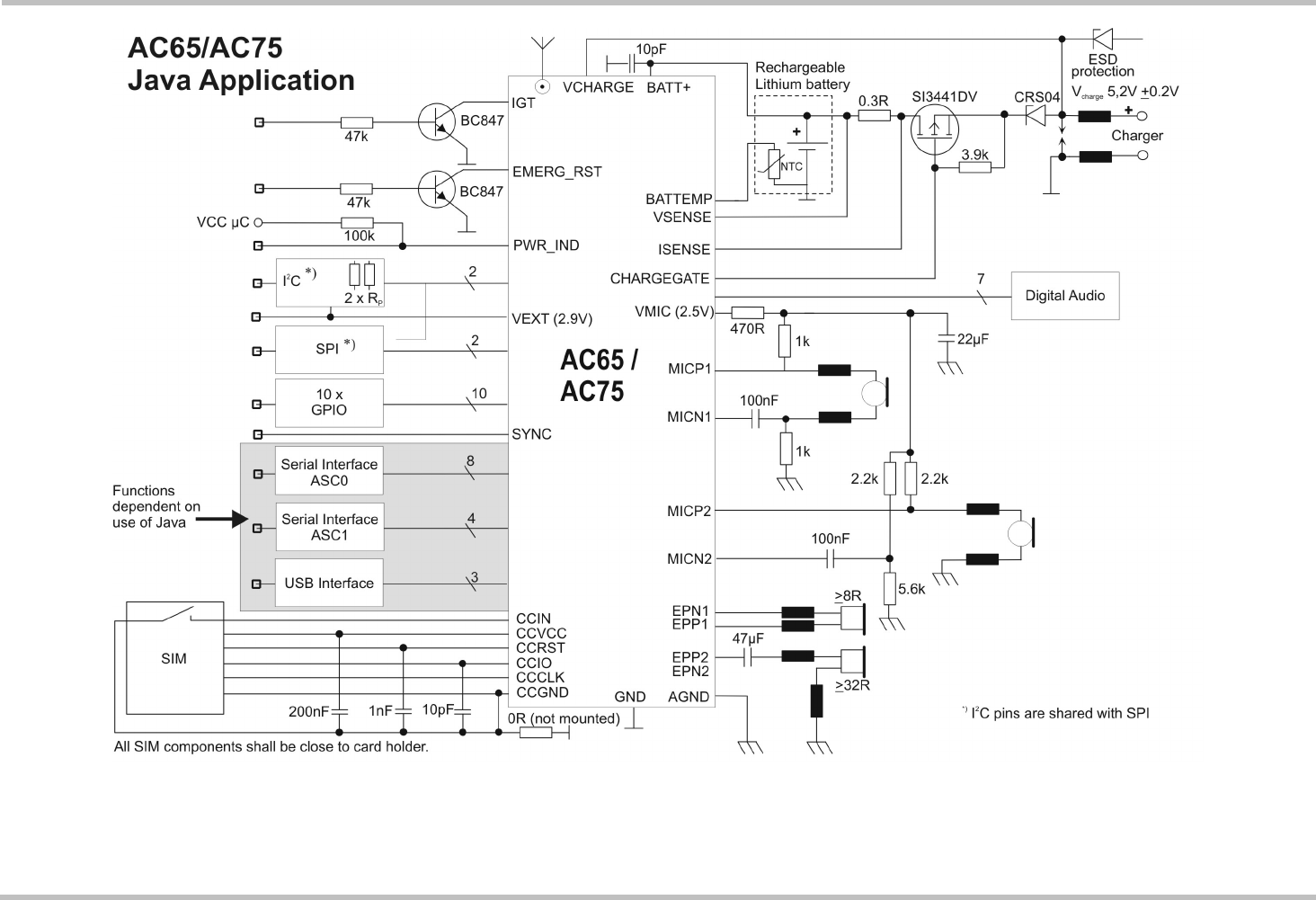
AC65/AC75 Hardware Interface Description
Confidential / Preliminary s
AC65/AC75_hd_v00.372 Page 110 of 118 2006-08-03
Figure 46: AC65/AC75 sample application for Java
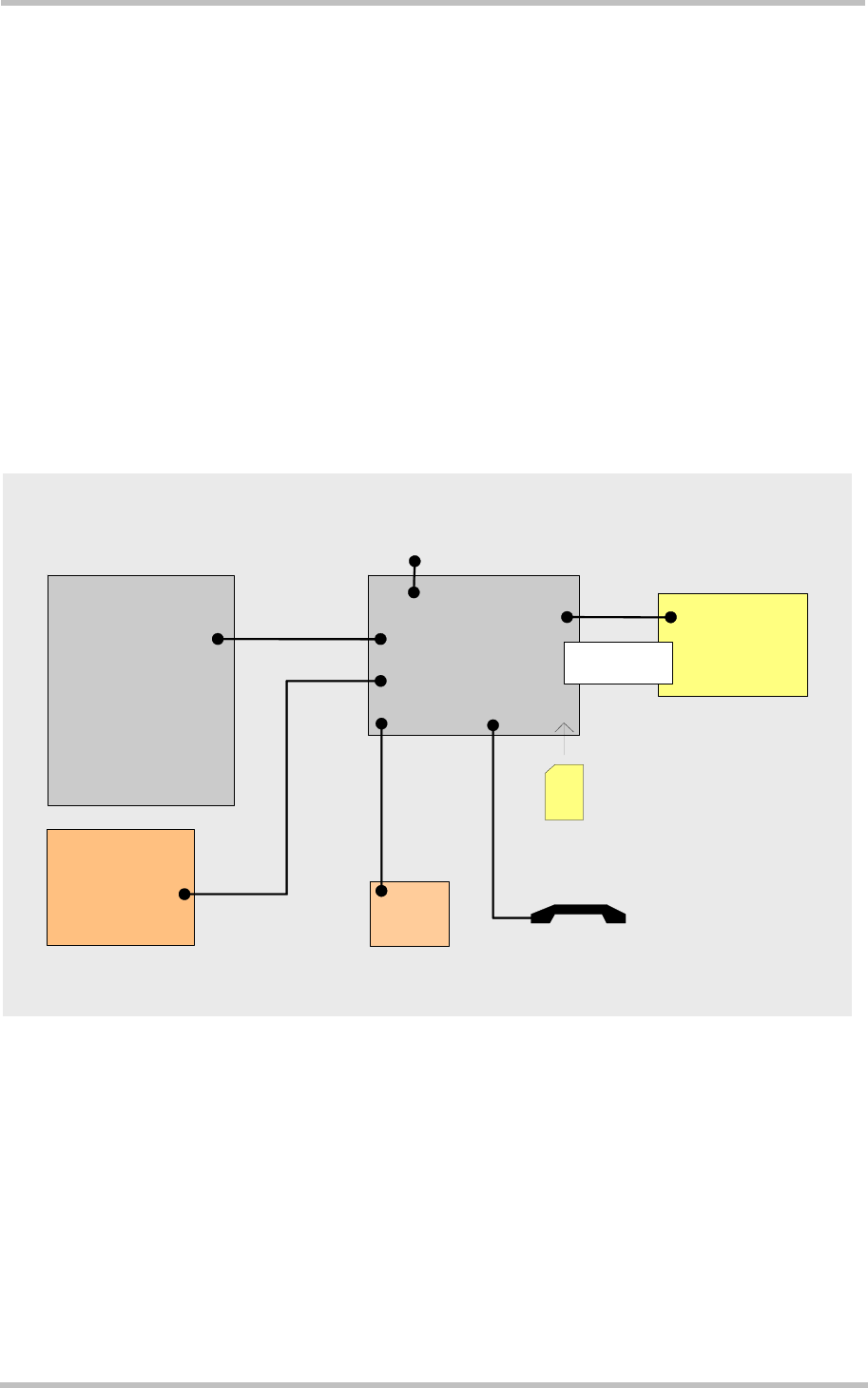
AC65/AC75 Hardware Interface Description
Confidential / Preliminary s
AC65/AC75_hd_v00.372 Page 111 of 118 2006-08-03
8 Reference Approval
8.1 Reference Equipment for Type Approval
The Siemens reference setup submitted to type approve AC65/AC75 consists of the
following components:
• Siemens AC65/AC75 cellular engine
• Development Support Box DSB75
• SIM card reader integrated on DSB75
• U.FL-R-SMT antenna connector and U.FL-LP antenna cable
• Handset type Votronic HH-SI-30.3/V1.1/0
• Li-Ion battery
• PC as MMI
PC
Power supply
SIM
RS-232 DSB75
Handset
Li-Ion
battery
GSM module
Flex cable
100mm
Antenna or 50 Ω
cable to system
simulator
Antenna
Figure 47: Reference equipment for Type Approval

AC65/AC75 Hardware Interface Description
Confidential / Preliminary s
AC65/AC75_hd_v00.372 Page 112 of 118 2006-08-03
8.2 Compliance with FCC Rules and Regulations
The FCC Equipment Authorization Certification for the Siemens reference application
described in Chapter 8.1 will be registered under the following identifiers:
FCC identifier QIPAC65
IC: 267W-AC65
granted to Siemens AG
and
FCC identifier QIPAC75
IC: 267W-AC75
granted to Siemens AG.
Manufacturers of mobile or fixed devices incorporating AC65/AC75 modules are authorized
to use the FCC Grants and IC Certificates of the AC65/AC75 modules for their own final
products according to the conditions referenced in these documents. In this case, the FCC
label of the module shall be visible from the outside, or the host device shall bear a second
label stating “Contains FCC ID QIP AC65” resp. “Contains FCC ID QIPAC75”.
IMPORTANT:
Manufacturers of portable applications incorporating AC65/AC75 modules are required to
have their final product certified and apply for their own FCC Grant and IC Certificate related
to the specific portable mobile. This is mandatory to meet the SAR requirements for portable
mobiles (see Chapter 1.3.1 for detail).
Changes or modifications not expressly approved by the party responsible for compliance
could void the user’s authority to operate the equipment.
If the final product is not approved for use in U.S. territories the application manufacturer
shall take care that the 850 MHz and 1900 MHz frequency bands be deactivated and that
band settings be inaccessible to end users. If these demands are not met (e.g. if the AT
interface is accessible to end users), it is the responsibility of the application manufacturer to
always ensure that the application be FCC approved regardless of the country it is marketed
in. The frequency bands can be set using the command
AT^SCFG="Radio/Band"[,<rbp>][, <rba>].
A detailed command description can be found in [1].

AC65/AC75 Hardware Interface Description
Confidential / Preliminary s
AC65/AC75_hd_v00.372 Page 113 of 118 2006-08-03
9 Appendix
9.1 List of Parts and Accessories
Table 37: List of parts and accessories
Description Supplier Ordering information
AC65 Siemens Standard module (Siemens IMEI)
Siemens ordering number: L36880-N8335-A100
Customer IMEI mode:
Siemens Ordering number: L36880-N8336-A100
AC75 Siemens Standard module (Siemens IMEI)
Siemens ordering number: L36880-N8330-A100
Customer IMEI mode:
Siemens Ordering number: L36880-N8331-A100
Siemens Car Kit Portable Siemens Siemens ordering number: L36880-N3015-A117
DSB75 Support Box Siemens Siemens ordering number: L36880-N8811-A100
Votronic Handset VOTRONIC Votronic HH-SI-30.3/V1.1/0
VOTRONIC
Entwicklungs- und Produktionsgesellschaft für
elektronische Geräte mbH
Saarbrücker Str. 8
66386 St. Ingbert
Germany
Phone: +49-(0)6 89 4 / 92 55-0
Fax: +49-(0)6 89 4 / 92 55-88
e-mail: contact@votronic.com
SIM card holder incl. push
button ejector and slide-in
tray
Molex Ordering numbers: 91228
91236
Sales contacts are listed in Table 38.
Board-to-board connector Molex Sales contacts are listed in Table 38.
SMP Rosenberger antenna
connector
Hirose Rosenberger Hochfrequenztechnik GmbH & Co.
POB 1260
84526 Tittmoning
Germany
http://www.rosenberger.de

AC65/AC75 Hardware Interface Description
Confidential / Preliminary s
AC65/AC75_hd_v00.372 Page 114 of 118 2006-08-03
Table 38: Molex sales contacts (subject to change)
Molex
For further information
please click:
http://www.molex.com/
Molex Deutschland GmbH
Felix-Wankel-Str. 11
4078 Heilbronn-Biberach
Germany
Phone: +49-7066-9555 0
Fax: +49-7066-9555 29
Email: mxgermany@molex.com
American Headquarters
Lisle, Illinois 60532
U.S.A.
Phone: +1-800-78MOLEX
Fax: +1-630-969-1352
Molex China Distributors
Beijing,
Room 1319, Tower B,
COFCO Plaza
No. 8, Jian Guo Men Nei
Street, 100005
Beijing
P.R. China
Phone: +86-10-6526-9628
Phone: +86-10-6526-9728
Phone: +86-10-6526-9731
Fax: +86-10-6526-9730
Molex Singapore Pte. Ltd.
Jurong, Singapore
Phone: +65-268-6868
Fax: +65-265-6044
Molex Japan Co. Ltd.
Yamato, Kanagawa, Japan
Phone: +81-462-65-2324
Fax: +81-462-65-2366
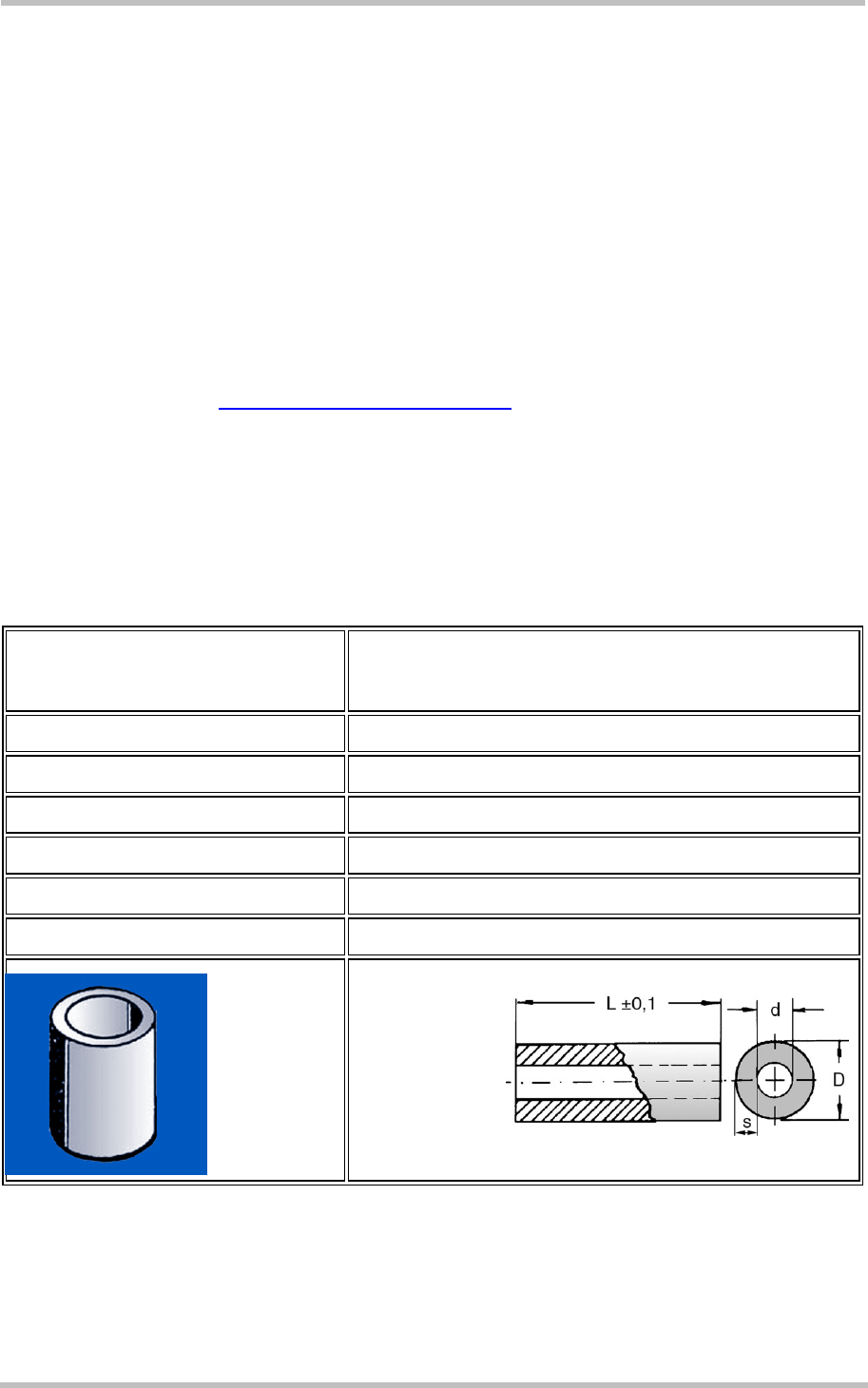
AC65/AC75 Hardware Interface Description
Confidential / Preliminary s
AC65/AC75_hd_v00.372 Page 115 of 118 2006-08-03
9.2 Fasteners and Fixings for Electronic Equipment
This section provides a list of suppliers and manufacturers offering fasteners and fixings for
electronic equipment and PCB mounting. The content of this section is designed to offer
basic guidance to various mounting solutions with no warranty on the accuracy and
sufficiency of the information supplied. Please note that the list remains preliminary although
it is going to be updated in later versions of this document.
9.2.1 Fasteners from German Supplier ETTINGER GmbH
Sales contact: ETTINGER GmbH
http://www.ettinger.de/main.cfm
Phone: +4981 04 66 23 – 0
Fax: +4981 04 66 23 – 0
The following tables contain only article numbers and basic parameters of the listed
components. For further detail and ordering information please contact Ettinger GmbH.
Please note that some of the listed screws, spacers and nuts are delivered with the DSB75
Support Board. See comments below.
Article number: 05.71.038
Spacer - Aluminum /
Wall thickness = 0.8mm
Length 3.0mm
Material AlMgSi-0,5
For internal diameter M2=2.0-2.3
Internal diameter d = 2.4mm
External diameter 4.0mm
Vogt AG No. x40030080.10
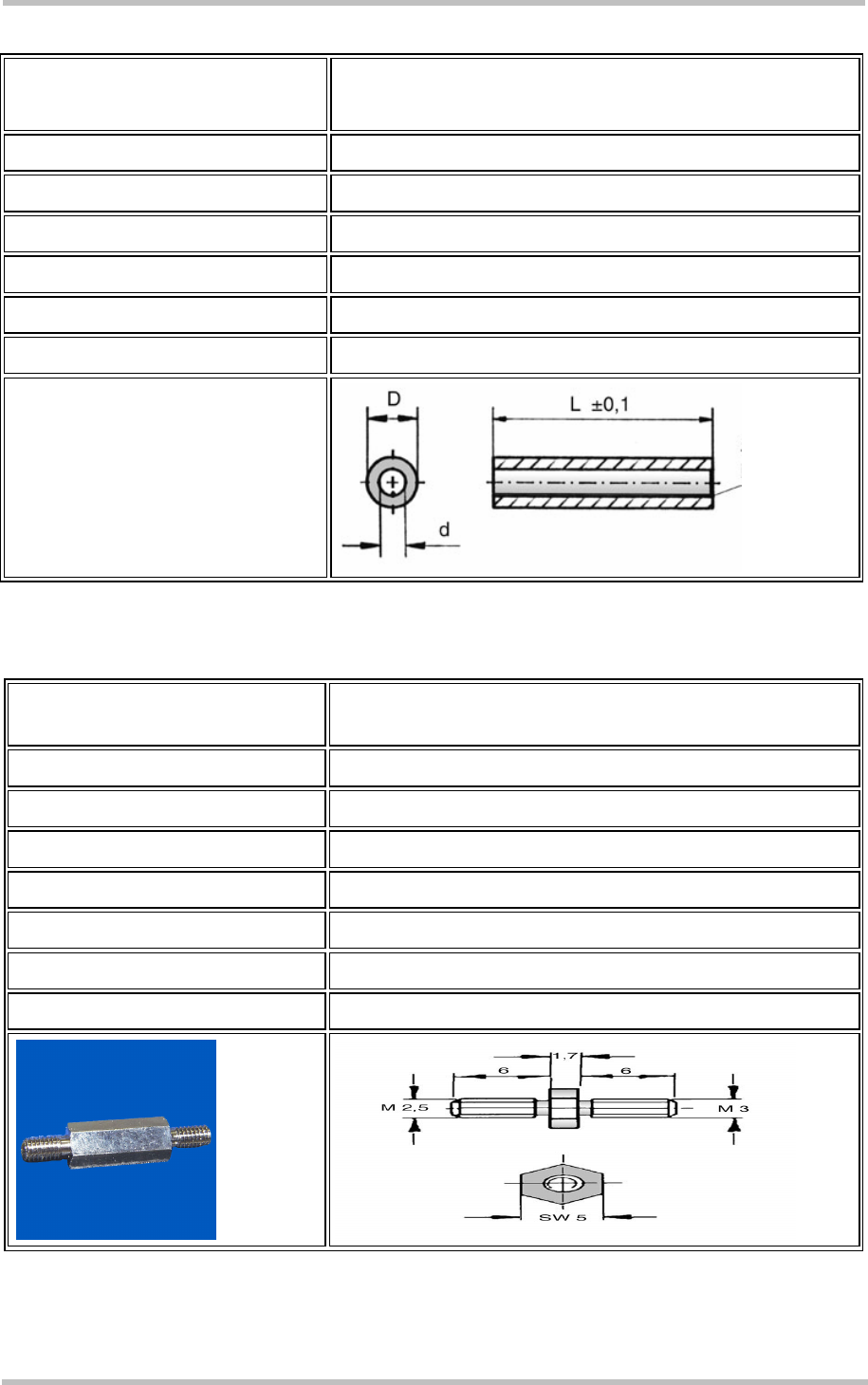
AC65/AC75 Hardware Interface Description
Confidential / Preliminary s
AC65/AC75_hd_v00.372 Page 116 of 118 2006-08-03
Article number: 07.51.403
Insulating Spacer for M2
Self-gripping *)
Length 3.0mm
Material Polyamide 6.6
Surface Black
Internal diameter 2.2mm
External diameter 4.0mm
Flammability rating UL94-HB
*) 2 spacers are delivered with DSB75 Support Board
Article number: 05.11.209
Threaded Stud M2.5 - M2 Type E /
External thread at both ends
Length 3.0mm
Material Stainless steel X12CrMoS17
Thread 1 / Length M2.5 / 6.0mm
Thread 2 / Length M2 / 8.0mm
Width across flats 5
Recess yes
Type External / External
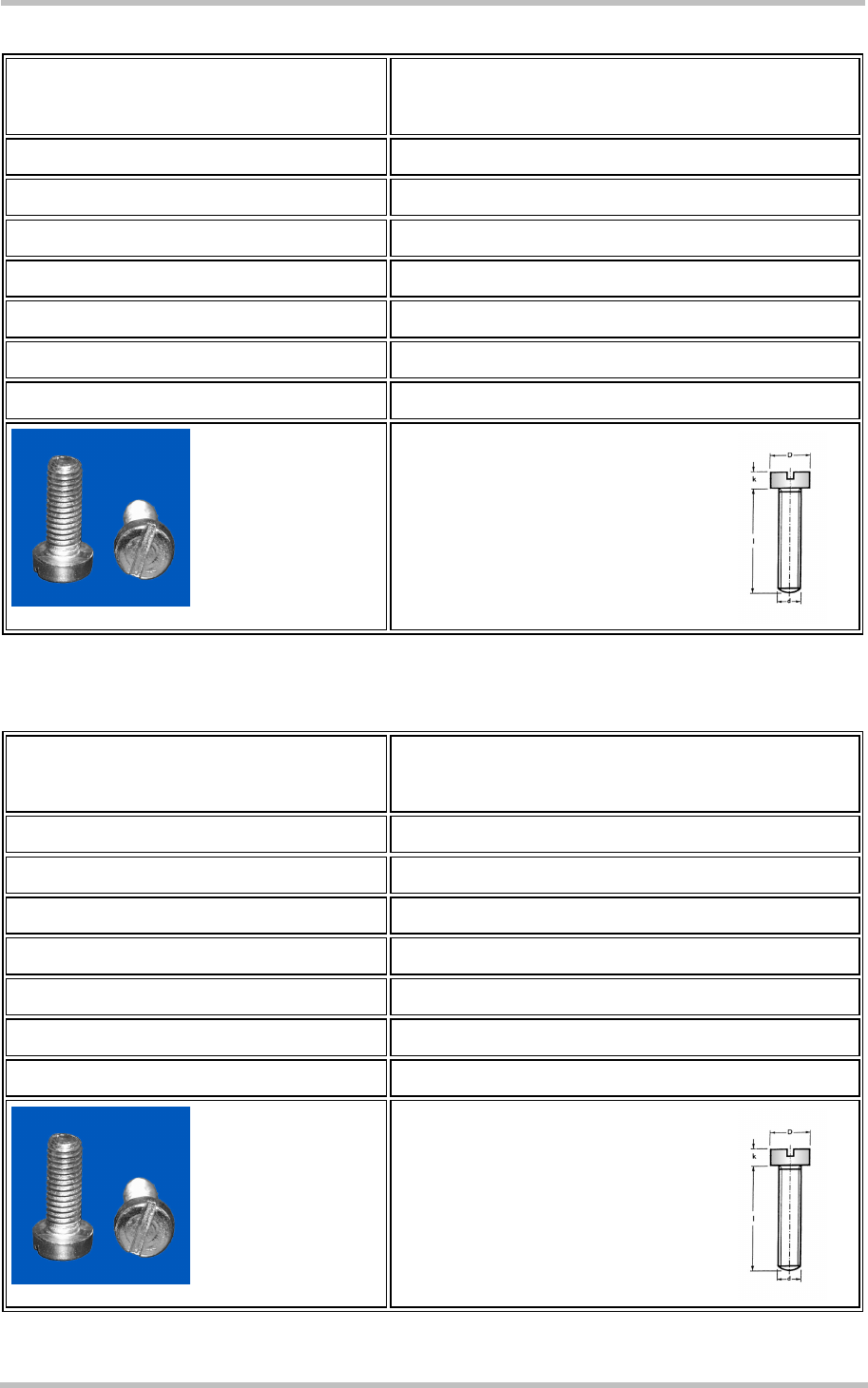
AC65/AC75 Hardware Interface Description
Confidential / Preliminary s
AC65/AC75_hd_v00.372 Page 117 of 118 2006-08-03
Article number: 01.14.131 Screw M2 *)
DIN 84 - ISO 1207
Length 8.0mm
Material Steel 4.8
Surface Zinced A2K
Thread M2
Head diameter D = 3.8mm
Head height 1.30mm
Type Slotted cheese head screw
*) 2 screws are delivered with DSB75 Support Board
Article number: 01.14.141 Screw M2
DIN 84 - ISO 1207
Length 10.0mm
Material Steel 4.8
Surface Zinced A2K
Thread M2
Head diameter D = 3.8mm
Head height 1.30mm
Type Slotted cheese head screw
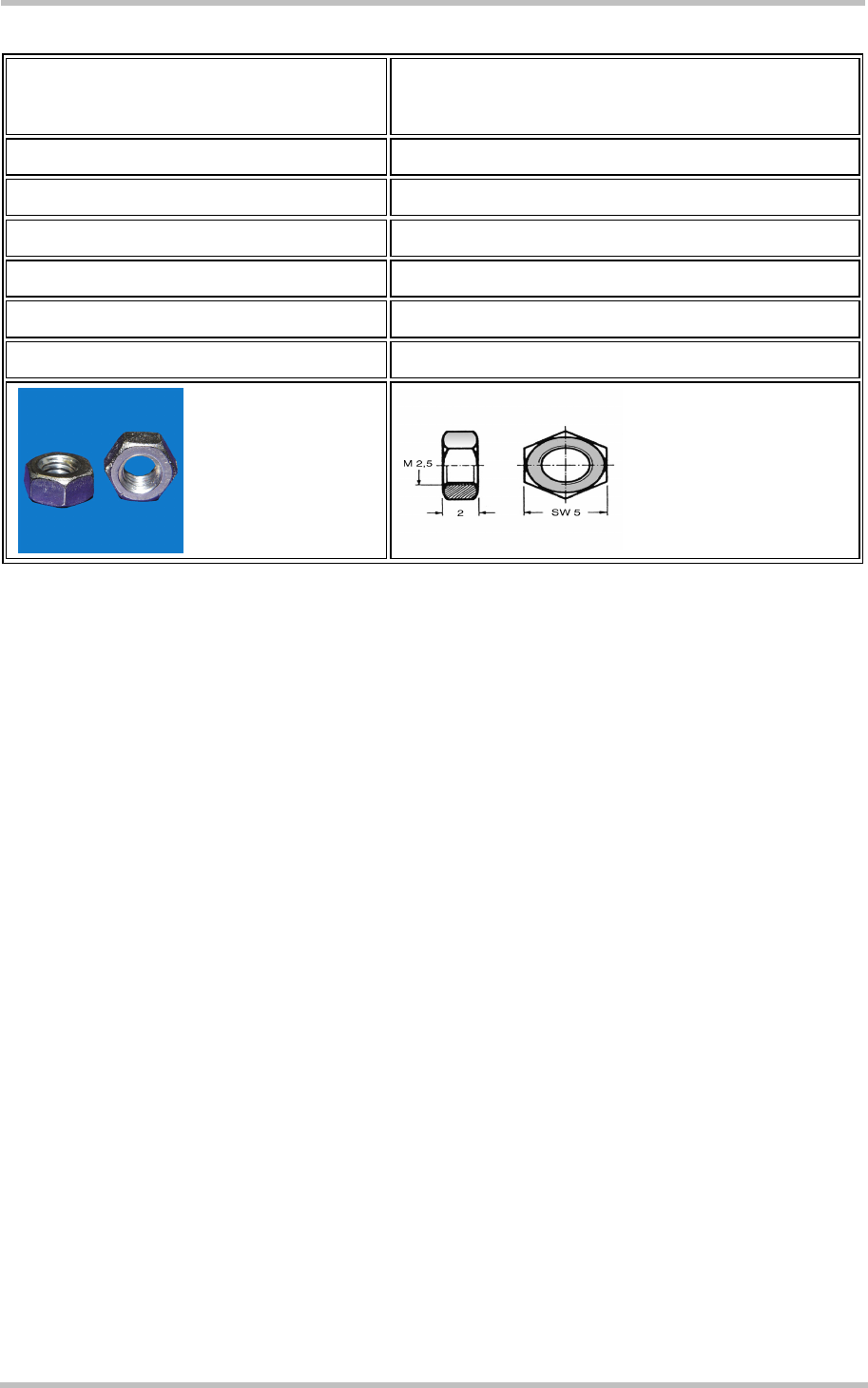
AC65/AC75 Hardware Interface Description
Confidential / Preliminary s
AC65/AC75_hd_v00.372 Page 118 of 118 2006-08-03
Article number: 02.10.011 Hexagon Nut *)
DIN 934 - ISO 4032
Material Steel 4.8
Surface Zinced A2K
Thread M2
Wrench size / Ø 4
Thickness / L 1.6mm
Type Nut DIN/UNC, DIN934
*) 2 nuts are delivered with DSB75 Support Board
